SUMNER, ALBERT E. (1840-1882). Surgeon, United States Navy. Originally from Hartford, Connecticut, he graduated from Trinity College there and studied medicine at New York University receiving a diploma from the latter school. According to his obituary in the Brooklyn Standard Union, he served as surgeon in the Navy during the Civil War, although there are no details. In 1863, he opened a medical practice in Brooklyn and was associated with the Homeopathic Hospital on Cumberland Street in Brooklyn where he served on the Board of Trustees.
Civil War Bio Search
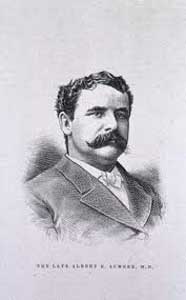
Active in civic and professional organizations, Sumner was a member of the Kings County and New York State Medical Associations, the American Institute of Medicine, the Long Island Historical Society and the Philharmonic Society (of which he was a director). He died of an apparent stroke while making rounds with his driver and carriage and could not be revived. His last address was 130 Clinton Street in Brooklyn. Section J, lot 19867.
SUMNER (or SUMMER), CLARK FREEMAN (1845-1910). Second lieutenant, 52nd Regiment, New York State National Guard, Company G. Sumner, a native of Milford, Massachusetts, was a descendant on his mother’s side of Revolutionary War patriot Samuel Adams. In 1863, he enlisted at Brooklyn on June 19, was immediately commissioned into the 52nd Regiment as a second lieutenant, and mustered out at Brooklyn after the termination of his 30 day enlistment on July 25. As per his obituary in the New York Tribune, he joined the woolen firm of John Mott & Co. circa 1870; the company later was known as Sumner, Reed & Martin until its dissolution in 1895. At that time, he became a member of the American Woolen Company. He last lived in Babylon, New York. Section 158, lot 23168.
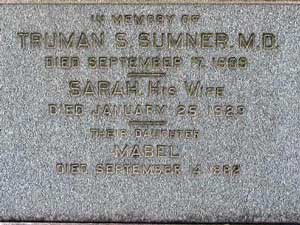
SUMNER, TRUMAN SQUIRE (or L.) (1847-1909). Private, 62nd Alabama Infantry, Company A, Confederate States of America. A native of Richmond, Virginia, he was living in Marion, Alabama, at the onset of the Civil War. On August 1, 1864, he enlisted as a private at West Point, Georgia, and served in the 62nd Alabama (also known as the 1st Alabama Reserves). His muster roll notes that he was 17 years old, was present in August, and was never paid. Further details related to his service are unknown.
Sumner is listed in the Bellevue College Medical College’s annual catalogue of students for 1873-1874; he studied at University Medical College before that. In 1885, he was a physician living at 507 Clinton Street in Brooklyn as per the Brooklyn Directory with an office at 28 West 28th Street in Manhattan. Sumner was one of the first physicians in the United States to perform transfusions. His practice was listed as allopath (mainstream) in the Directory of Deceased Physicians. Sarah Lilliss Sumner, his wife who is interred with him, had three brothers, John (see), Joseph (see) and William Lilliss (see), who fought for the Union and are interred in the same lot. As per his obituary in the Brooklyn Daily Eagle, Southern newspapers and those in Bennington, Vermont, were asked to publish his death notice. He last lived at 250 Lafayette Avenue in Brooklyn. Section 168, lot 14830.
SURAND, JOHN (1843-1868). Second lieutenant, 55th New York Infantry, Companies I and E; 38th New York Infantry, Company G; 40th New York Infantry. Born in England, he enlisted at Staten Island as a private on July 31, 1861, and mustered into Company I of the 55th New York on August 28. In 1862, he rose to sergeant on June 1, and to second lieutenant on October 1 effective upon his transfer that day to Company E. Transferred to Company G of the 38th New York on or about December 21, he was subsequently transferred into the 40th New York on June 3, 1863. He last lived in New York City. Section 177, lot 2353.
SUTHERLAND (or SOUTHERLAND), THEODORE (1843-1871). Private, 32nd New York Infantry, Company C. Born in Wells, New York, Sutherland was a lumberman who was 5′ 6″ tall with light hair, gray eyes and fair complexion at the time of his enlistment as a private at Johnstown, New York, on May 7, 1861. He mustered into the 32nd New York on May 31, and mustered out at New York City on June 9, 1863. His last home was in Palatka, Florida. Section 11, lot 491.

SUTTIE, GEORGE L. (1841-1893). Sergeant, 71st Pennsylvania Infantry, Company G. A native of New York, Suttie enlisted on May 28, 1861, as a private, and mustered into the 71st Pennsylvania. He was promoted the following year to sergeant, on May 1, and two years later, he mustered out at Philadelphia on July 2, 1864. Suttie was living at 130 East 138th Street in Manhattan at the time of his death. Section 190, lot 17885.
SUTTON, JOSEPH FORD (1827-1912). Chaplain, 102nd New York Infantry. Born in Sussex County, New Jersey, he was a 1832 graduate of Rutgers College and received a degree from the Union Theological Seminary in 1857. According to the census of 1860, he was a minister who owned real estate worth $5,000 and had a personal worth of $1,000. Sutton was 5’5¾” tall with gray eyes, brown hair and a light complexion when he entered service. After enlisting as a chaplain at New York City on March 6, 1862, he was commissioned into the Field and Staff of the 102nd New York two days later. He was discharged on November 22, 1862.
Sutton’s obituary in the New York Herald states that after his discharge, he was active with the United States Christian Commission, an organization that catered to the spiritual and emotional needs of soldiers through hospital and relief work. The censuses of 1870 and 1880 show that he was living in Philadelphia, Pennsylvania, where he was a Presbyterian clergyman. In 1883, he was awarded a doctor of divinity degree from Maryville College. When he applied for a passport at New York City in 1890, his hair had turned gray and he noted that he had a thin face, medium forehead, and irregular nose. His obituary states that he stepped down from the Murray Hill Presbyterian Church in Manhattan in 1890, the last church that he headed.
As per the censuses of 1900 and 1910, he was living in New York and was a clergyman. He applied for a veterans’ pension in 1907 that was granted under certificate 1140376. Among the many organizations that he was a member of include the Loyal Legion, Sons of the Revolution, New York Presbytery, and the American Geographical Society. An author of many hymns, he wrote this poem that was published in The African Repository and Colonial Journal by the American Colonization Society, an organization that was originally founded in 1816 to repatriate free Blacks to Africa where they thought their lives would be better. (The Journal was published from 1825-1919.)
Courage, Soldiers!
Hark, the tread of many millions
Marching on-the hosts of God;
Coming from the isles and nations
Ransomed by the Saviour’s blood!
Hear them Shouting!
“He hath washed us in his blood!”
God His promise is fulfilling
To His well-beloved Son;
Heathen nations to him giving,
For a heritage, His own.
See them coming!
All to worship at his throne.
Christ is seeing of the travail
Of His loving, waiting soul,
In the triumphs of the Gospel
Over men, from pole to pole.
Hear their praises!
Like the voice of waters, roll.
Soldiers of the Cross, long waiting
For the coming of this day—
Toiling, weeping, watching, praying,
Courage take and march away!
“We have triumphed!”
Soon you’ll hear our Captain say.
He last lived at 253 West 95th Street in Manhattan. Joanna Sutton was awarded a widow’s pension in 1916, certificate 843,121. Section 76, lot 85.
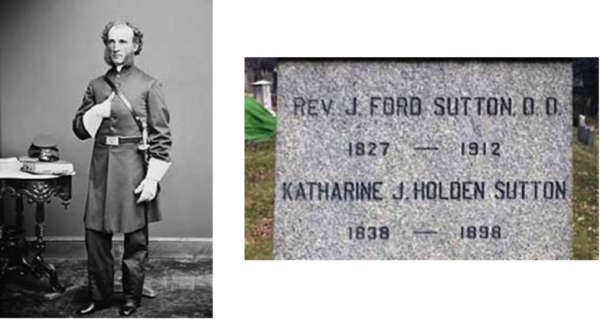
SUTTON, WOODRUFF (1841-1896). Private, 22nd Regiment, New York State Militia, Company D. A New York City native, he was working as a clerk according to the 1860 census. During the Civil War, Sutton enlisted at New York City on May 28, 1862, and mustered into the 22nd Regiment. The 22nd Regiment mustered out on September 5, 1862. Sutton was listed as a merchant in the 1870 and 1878 New York City Directories. The 1880 census reports that he was living with his parents, siblings, and son in West Islip, New York. He joined Lafayette Post #140 of the G.A.R. on September 20, 1886, listing his occupation as merchant. He lived at 1072 Madison Avenue at that time. The 1894 New York City Directory lists him as a merchant. He last lived in Babylon, New York. The cause of his death was cerebral apoplexy. Section 119, lot 5713.
SUYDAM (or SONGDAM, SNYDAM), GEORGE HENRY (1842-1914). Captain, 162nd New York Infantry, Companies C and H; first lieutenant, 174th New York Infantry, Company G. A native of New York, Suydam enlisted as a second lieutenant at New York City on October 16, 1862, and was commissioned into the 174th New York two days later. He was promoted to first lieutenant on July 15, 1863, and transferred into Company C of the 162nd on February 17, 1864. He was promoted to captain on April 10, 1864, effective upon his transfer to Company H on that day, and mustered out on October 12, 1865, at Savannah, Georgia.
According to his obituary in the Sunday Call in Newark, New Jersey, Suydam was a businessman in Salisbury, North Carolina, after the War, then engaged in business in New York City and Newark. He was a member of the Lafayette Post #140 of the G.A.R. Among the civic associations to which he belonged were the Freemasons, Roseville Athletic Association, and the Holland Society of New York. His application for an invalid pension was granted in 1900, certificate 1,047,781. A resident of Newark, New Jersey, since 1887, he last lived there at 433 Fourth Avenue. White McRorie Suydam, who is interred with him, applied for and received a widow’s pension in 1914, certificate 785,870. Section 70, lot 363.
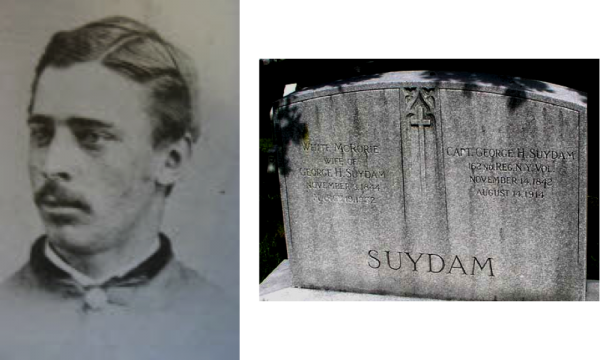
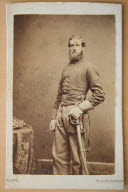
SUYDAM, HENRY (1834-1916). Commissary sergeant, 1st New York Cavalry, Companies B and A; 2nd Battalion. At the time of his enlistment, Suydam was a sharecropper farmer in Morris County, New Jersey, who was 6′ 1″, with blue-gray eyes, brown hair and a light complexion. He enlisted as a private on July 19, 1861, at New York City, and mustered into Company B of the 1st New York Cavalry. That same year, he was promoted to corporal on September 19 when he was transferred to Company A, and detailed as a commissary sergeant for the 2nd Battalion on November 5. He returned to Company B as a commissary sergeant on September 6, 1862. After sustaining a slight gunshot wound of the left wrist, he was captured in action on August 13, 1864, at New Market, Virginia. He was held prisoner at Andersonville, Georgia, and not paroled until November 9, 1864, at Savannah, Georgia, at which time he was wearing only a shirt and drawers. On November 26, he was sent to St. John’s Hospital at Annapolis, Maryland, suffering from scurvy, emaciation and exposure, and remained there until January 1865. He mustered out on January 16, 1865, at New York City.
After the War, Suydam returned to Morris County and resumed farming. In 1888, he applied for an invalid pension, application 652,083. It was not granted at that time, but he was issued a pension in 1897, certificate 941,140. By 1901, he was working as a clerk, being too infirm to farm. He died in the Bronx. Section 45, lot 7096.
SUYDAM, SEYMOUR L. (1829-1879). Private, 139th New York Infantry, Company A. A Brooklyn resident at the time of his enrollment, he enlisted there as a private on August 21, 1862, mustered into the 139th New York on September 9, and mustered out at Richmond, Virginia, on June 19, 1865. His last residence in Brooklyn was at 1879 Hicks Street. In 1890, his widow, Anna Suydam, was granted a pension under certificate 301,068. Section 67, lot 5183.
SWAN, JOSEPH S. (1841-1909). Corporal, 29th New Jersey Infantry, Company D. He enlisted at Riceville, New Jersey, the town of his birth, on September 4, 1862, mustered into the 29th New Jersey as a corporal, and served until his discharge at Freehold, New Jersey, on June 30, 1863. A grocer as a young man, he became an Associated Press ship news reporter and lived in New York and Brooklyn after the War. In his application for a pension in 1904, Swan noted guarding the pontoon bridges at Fredericksburg, Virginia, and fighting, under General Hooker, at Chancellorsville, Virginia. He wrote, “I remember a man named Compton in our company from Port Monmouth lost a leg in that action. I have lived in Brooklyn for the last thirty years and never had a conversation with my old comrades, and therefore have forgotten names and dates.”
As per his obituary in the Brooklyn Standard Union, which confirms his Civil War service, Swan went to Montana after the Civil War on a mining expedition. Living an adventurous life, he returned to New York and became a ship reporter and marine representative for The Associated Press. The 1873-1876 Brooklyn Directory notes his employment with ship news; during those years, he lived at 400 Court Street. He was connected with the aforementioned organization for 40 years and died at his desk at the Ship News Office at the Battery. Swan applied for and received an invalid pension in 1904. As per his death certificate, he was married, worked as a reporter and died in Manhattan. He last resided at 520 53rd Street in Brooklyn. His wife, Julia Swan, applied soon after his death for a widow’s pension, and was granted one under certificate 684,183. He was also survived by three sons and two daughters. Section 86, lot 31217, grave 53.
SWANSTROM, JOHN P. (1821-1889). Member, United States Sanitary and Christian Commission. A reverend originally from Gruena, Sweden, Swanstrom immigrated to the United States in 1847 where he founded the Swedish Pilgrims Congregational Church in Brooklyn. For three years during the Civil War, he went to the front lines as part of United States Sanitary and Christian Commission, an organization that provided soldiers with social services and religious support. General Grant wrote him a letter of praise for his battlefield work.
According to his obituary in the Brooklyn Daily Eagle, Swanstrom was active in providing for the welfare of Swedish-Americans and helped build nine Swedish churches in New York City. He last resided at 285 Pacific Street where he died suddenly at his front door after returning from the polls on Election Day. Section 202, lot 28301, grave 2.
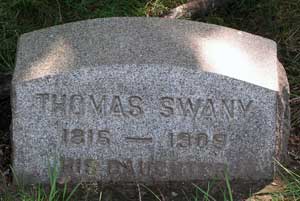
SWANY, THOMAS (1816-1909). Captain, 8th Regiment, New York State Militia, Company B. Enlisting at New York City as a captain at age 44 on April 23, 1861, he was commissioned into the 8th New York State Militia two days later, served three months, and mustered out at New York City on August 2. He last resided at 327A Madison Street in Brooklyn where he died at age 92. Section 3, lot 13145, grave 5.
SWARTZ, JOHN HANCOCK (1835-1919). Private, 7th Regiment, New York State Militia, Company A. Born in New York, Swartz served with the 7th Regiment for 30 days in 1861. In 1904, his pension application was approved, certificate 1,092,078. He last lived at 229 Bergen Street in Brooklyn. Section 199, lot 28785, grave 1.
SWEENEY, DANIEL M. (1832-1871). Private, 63rd New York Infantry, Company G. A native of Brooklyn, he enlisted at New York City on March 8, 1862, and mustered into the 63rd on April 3. He re-enlisted on December 21, 1863, and mustered out on August 28, 1865, at Brattleboro, Vermont. His last address was 19 Willoughby Street in Brooklyn. Section 92, lot 3224.
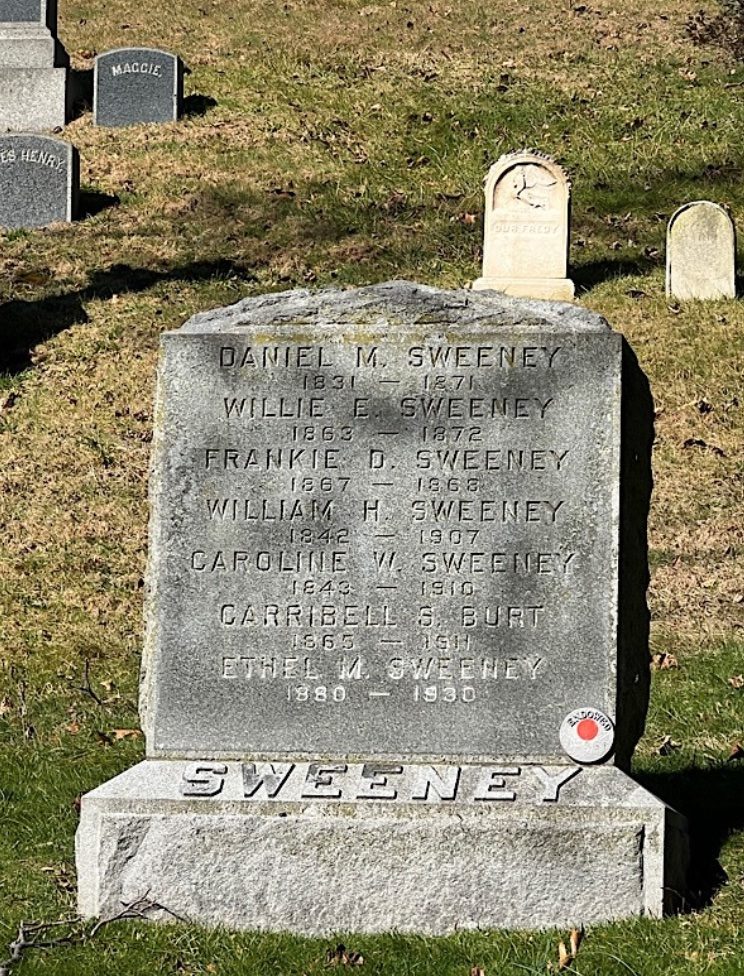
SWEENEY, EDWARD (1840-1895). Private, 12th Regiment, New York State Militia, Company E. Sweeney served for three months in the 12th Regiment in 1861. Sweeney became a member of the G.A.R. in June 1882. In 1891, his application for an invalid pension was approved, certificate 842,594. He last lived at 70 Vernon Avenue in Flatbush, Brooklyn, where he died from cirrhosis. Shortly after his death in 1895, Fannie Sweeney, who is interred with him, applied for and received a widow’s pension, certificate 419,733. Section 194, lot 29102.
SWEENEY, GEORGE (1840-1894). Sergeant, 73rd New York Infantry, Company K. After enlisting as a sergeant at New York City on May 15, 1861, he mustered into the 73rd New York on July 10, and was reduced to ranks at some point before he deserted in Virginia on June 19, 1862. He last lived in Brooklyn. Section 2, lot 5499, grave 90.
SWEENEY (or SWEENY), HENRY (1833-1908). Private, 162nd New York Infantry, Company D. Originally from Ireland, Sweeney enlisted as a private at New York City on September 26, 1862, mustered into Company D of the 162nd New York on October 18, and was discharged for disability at a hospital in New Orleans, Louisiana, on April 30, 1864 (his pension index card notes April 14, 1964).
Sweeney’s application for an invalid pension was approved in 1890, certificate 685,166. The census of 1900 indicates that he was living in the Bronx and had been married for six years. He last lived at 466 East 135th Street in the Bronx. His death was attributed to myocarditis. Shortly after his death, Lizzie Sweeney applied for and received a widow’s pension, certificate 889,990. Section 134/135, lot 27263, grave 1342.
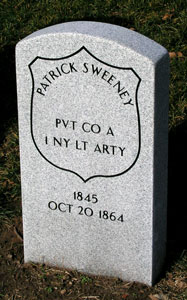
SWEENEY, PATRICK (1845-1864). Private, 1st New York Light Artillery, Company A. Sweeney served in the 1st New York Light Artillery, and died of typhoid fever at Hart’s Island, New York Harbor, on October 20, 1864. Interment at Green-Wood was on November 12 of that year. Section 115, lot 13536 (Soldiers’ Lot), grave 93.
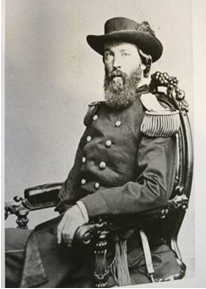
SWEENY (or SWEENEY), THOMAS WILLIAM (1823-1892). Brigadier general, United States Volunteers and Missouri Volunteers; major, Regular United States Army; colonel, 52nd Illinois Infantry. Born in County Cork, Ireland, he came to New York City at the age of 12 with his widowed mother. He worked as a printer and joined the militia. He volunteered for service during the Mexican War, was elected second lieutenant of Company A of the 2nd New York Volunteers, and was wounded so badly at Churubusco that his right arm had to be amputated. On his return to New York in 1848, he was given a “Grand Reception Ball” at Castle Garden by the printers of New York. Later, he fought Yuma Indians in the Southwest, where he was wounded in the neck by an arrow in 1852, and fought the Sioux on the Great Plains as a lieutenant in the 2nd United States Infantry.
When the Civil War began, Sweeny was sent to St. Louis, Missouri, where he and 40 recruits successfully held the United States Arsenal and its 60,000 arms against 3,000 Confederate sympathizers. In May of 1861, he resigned as lieutenant of the Regular Army to become a brigadier general of Missouri Volunteers. Within three months he was wounded at Wilson’s Creek, Missouri, on August 10, and carried from the field after a ball struck him in his right thigh (and remained there the rest of his life). The wound was slow to heal and he was forced to take a month’s leave as of September 1. He soon left the Missouri Volunteers to become colonel of the 52nd Illinois Infantry on January 21, 1862. He commanded this unit in Tennessee at Fort Donelson, and a brigade at Shiloh, where, according to General Sherman, Sweeny saved the day, although he suffered a severe wound to his left arm.
In 1872, Sweeny wrote about the engagement at Shiloh on April 6, 1862, in which he remembered when he took control of 9th Illinois before General Buell came in later that day with reinforcements, “…Having no artillery, we fought under great disadvantage; nevertheless, my men acted with the most determined bravery. Each man seemed to feel as if the fate of the day depended upon his conduct alone, knowing, as we did, that if we could keep the enemy at bay until Buell’s troops [reinforcements] crossed the river the army would be saved.” After taking a sick leave on June 26, 1862, he resumed command two months later. Subsequently commissioned brigadier general of volunteers on November 29, 1862, he distinguished himself in Mississippi at Corinth, and in Georgia at Kennesaw Mountain and Atlanta, leading the 1st Brigade and the Department of the Tennessee.
On sick leave from July 11, 1863, he returned in September, and attained the rank of major on October 23, 1863. On July 25, 1864, Sweeny, apparently under the influence of alcohol, called his commanding officer a “God-damned liar” and a “cowardly son of a bitch,” then hit him. He then wrestled another general to the ground. Sweeny was immediately arrested and charged with conduct unbecoming an officer, but he was acquitted. The City of Brooklyn presented Sweeny with a sword for his services during the Civil War. He was a member of the honor guard around the body of President Lincoln when he lay in state in New York’s City Hall.
Mustered out of service in August of 1865, Sweeny was elected secretary of war of the “Irish Republic” by the Fenian Congress. In an effort to bring pressure on the British to free Ireland, he led a force of Irish-Americans north to capture Canada. The invasion was a fiasco, and for his efforts he was arrested by United States officials but released without a trial. He returned to active duty, retiring as brigadier general in 1870 after being found “incapacitated for active service” due to his many battle wounds. He spent the rest of his life in Astoria, Queens. The Army & Navy Journal described him “as gallant, warm-hearted and impulsive an officer as ever wore the uniform.”
Sweeny’s last public act was his effort to build a home for Confederate veterans in Texas. In a letter to the New York committee in charge of that endeavor in 1889, he wrote, “…Sir: I am heartily in favor of the movement you have in contemplation to relieve the necessities of the surviving veterans of the late Confederate Army. They were our foes—they are now our brothers. I, for one, lost all hostile feeling toward them the moment they laid down their arms and returned to the protection of the “old flag.” Let the people of the North show their generosity and magnanimity by aiding them now in their distress.” He last lived in Long Island City. On May 6, 1901, his son received a letter from Vice President Theodore Roosevelt, written from Oyster Bay, Long Island, “…I was deeply interested in the recital of your father’s heroism. It is the kind of tale that makes my blood thrill with pride in my country. I prize his picture, and I take the utmost pleasure in sending you one of mine.” Section 163, lot 14257.
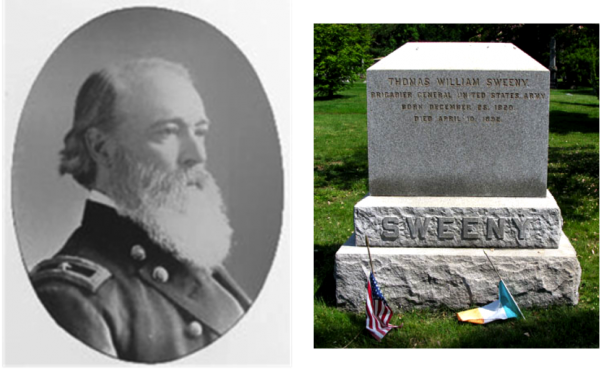


SWEET, GEORGE HENRY (1831-1912). Colonel, 15th Texas Cavalry, Company A; private, 4th Texas Infantry, Company F, Confederate States of America. Sweet, who was born in Ulster County, New York, and was a veteran of the Mexican War, married a woman from San Antonio, Texas, in 1859. In 1860, he became editor of the San Antonio Herald. Sweet first served as a private in the 4th Texas Infantry, Company F, known familiarly as the Mustang Grays. He served for about four months in that company which was organized on July 11, 1861. Sweet was officially discharged by Special Order #21 by the Confederate War Department on January 27, 1862. He had been elected captain of the 15th Texas Cavalry, Company A, on January 1, 1862, at San Antonio, Texas, and became its colonel on March 10. His name was on the muster rolls at Little Rock, Arkansas, on May 26, where he was re-elected colonel as of May 20, 1862. The regiment marched into Arkansas that summer, dismounted, and served as infantry as of July 24.
On October 27, 1862, Sweet was relieved from command of the First Brigade, Second Division. He and most of his troops were captured at Arkansas Post on January 11, 1863. Sweet was exchanged in the spring of that year, and sent to the Trans-Mississippi Department in the fall to collect the men from his regiment who had escaped from Arkansas Post. In the autumn of 1864, he was in command at Camp Ford, the Confederate prison at Tyler, Texas.
After the War, in 1866, Sweet traveled through Mexico keeping a diary of his journey. By 1871, he published an immigrant’s handbook, Texas: Her Early History, Climate, Soil, and Material Resources, and had become publisher of Texas New Yorker, a monthly periodical that was published in New York and promoted investment in and immigration to Texas. The masthead of the magazine was a Lone Star with clasped hands across the continent welcoming newcomers to the state. Surrounding the logo were scenes depicting life in Texas. Published through 1878 for $1.50 per year, this quote also appeared on the masthead, “Devoted to making known to the Capitalist, Merchant, Mechanic, and Emigrant the Agricultural, Horticultural, Stock-raising, Manufacturing, Railroading, and other Latent Wealth of Texas.” (Barbara J. Rozek, Come to Texas, 2003, pp. 81-82)
In 1878, Sweet relocated to Galveston, Texas, where he was publisher of the Galveston Journal until 1881 when he sold the newspaper. On July 1, 1912, he wrote to the officials at Green-Wood, where his wife owned a plot, asking to be assured that he could be buried with her. Without mentioning Texas, he wrote, “New York is my native state and I have a personal pride in wanting to be interred there.” Sweet further identified himself as “a veteran of the Mexican War under General Scott in my 82nd year,” but neglected to say that he fought for the Confederacy. He last lived on Wood Avenue in Linden, New Jersey. A Bowie knife, presented to him and inscribed by his father, and a portrait of him from the Mexican War, were auctioned in May 2007. Section M, lot 21114, grave 5.
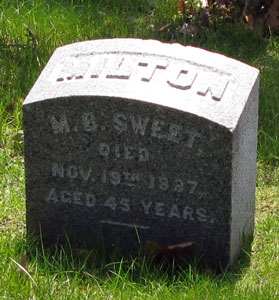
SWEET, MILTON B. (1843-1887). Private, 7th Regiment, New York State Militia, Company I. Sweet, who was born in New York State, served with the 7th Regiment for 30 days in 1861. When the 7th Regiment was reactivated a year later and part of the National Guard, Sweet re-enlisted as a private at New York City on May 25, 1862, mustered into his company the same day, and mustered out three months later on September 5 at New York City.
Remaining in the 7th National Guard after the War, Sweet became a first lieutenant and resigned in 1873. As per the New York City Directory of 1877, he worked at an eating house at 4 Fulton Street in Manhattan. He last lived at 380 Washington Avenue, Brooklyn. His remains were moved to the current location on May 17, 1888. Section 155, lot 26007.
SWEET, SAMUEL S. (1846-1902). First sergeant, 165th New York Infantry, Company C; private, 71st Regiment, New York State Militia, Company H. After Sweet enlisted as a private in 1861 for three months, he mustered into Company H of the 71st Regiment and mustered out at the end of his term. He re-enlisted as a private at New York City on September 12, 1862, and mustered into the 165th on November 28. In 1863, he was promoted to corporal on February 10, reduced to ranks on August 18, and promoted to sergeant on December 12. He became a first sergeant on April 15, 1865, and mustered out on September 1 at Charleston, South Carolina. In 1892, his application for an invalid pension was approved, certificate 871,225. He died in St. James, Long Island. His wife, Lucinda Sweet, applied for and was granted a widow’s pension in 1908, certificate 551,607. Section 165, lot 16995, grave 1.
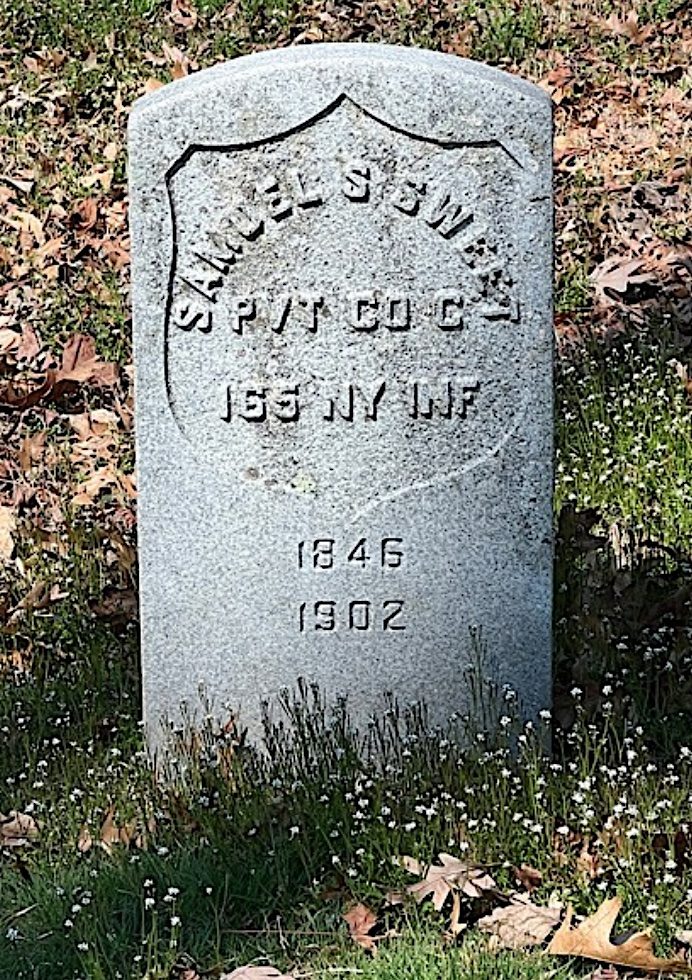
SWEETSER, LEVI (1831-1908). Acting second assistant engineer, United States Navy. Sweetser was a native of Troy, New York. He was a Brooklyn resident and an engineer by profession when he enlisted at Washington, D.C., on October 18, 1861, and entered service as an acting second assistant engineer in the United States Navy. Sweetser served onboard the USS Wyandank in the Potomac Flotilla until June 1864 when he was transferred to the USS Jacob Bell until September 27, 1864. On October 7, 1864, he transferred to the USS Mingo. He served until his discharge on October 14, 1865, at Brooklyn (although another document lists his place of discharge as Philadelphia, Pennsylvania).
In 1892, Sweetser applied for and received a pension from the Navy for “inability to earn a support by manual labor,” certificate 21,992. Among the numerous ailments afflicting Sweetser were senile debility, dyspepsia, disease of the liver and kidneys, rheumatism, piles and impaired vision. His pension was $12 a month. In 1907, when he reapplied to the Pension Bureau, he was 5′ 9″ tall, 155 pounds, with white hair, brown eyes and an olive complexion; he was not working at the time of his application. He last lived at 26 St. Charles Place in Brooklyn. Section 54, lot 31065, grave 1.
SWEZEY, CHRISTOPHER (1840-1898). Private, 13th Regiment, New York State Militia, Company G. A Long Island native, the census of 1860 reports that Swezey lived in Brooklyn and worked as a clerk. During the Civil War, he enlisted as a private on May 13, 1861, mustered into the 13th Regiment and was discharged at Brooklyn on August 6, 1861. During his service, the 13th was sent to Annapolis, Maryland, where they quartered at the United States Naval Academy. Detachments from the 13th were sent out to search for light-ships taken by rebel forces, and other expeditions were sent to the eastern shore of Maryland to find concealed weapons. In addition, the engineer corps of the 13th rebuilt the railroad from the station at Annapolis to the pier of the Naval Academy. Swezey wrote this letter to his father from 13th Regiment Headquarters:
Headquarters 13th [New York] Regt., Co. G
Annapolis, [Maryland]
Wednesday, June 5th 1861Dear Father,
Have just received that box and a very good reception it has and will receive. Everything in good order. Looked for a moment or two to consider how it was to be opened. Will concluded it was nailed and soon it was not.
Our rainy weather still continues giving us plenty of leisure time. Our rooms excite the jealousy of all who do not have interest in it and those wishing to have a quiet game of cards or to read in peace generally seek it at night now. I have no difficulty in getting to sleep—much easier than when at home—on account of our being so much more tired, I suppose.
Last evening a party of about twenty—including myself—took a row up the river round the Allegheny and back making in all nearly a mile. Fine exercise. I am surprised Dunscombe should have lost so much flesh. Most of the men here are gaining but we have really no hard work since the building of the railroad. We are all somewhat excited in relation to the rumors floating around in relation to our taking that secession town now known to be “Snow Hill” in the southern part of the states inside the pickets of the enemy. It’s hard to tell whether the regiment or Co. G is to do the work. One of the boys has just told me that Capt. [R. M.] Thorn has told him this morning that we were to do the work and that all the Colonel is waiting for is another steamer. We are all anxious to go.
I am going to endeavor to draw a view of the academy ground to send you. Of course it will not amount to much but you can get some idea of them. I do not remember to have mentioned the fact of Winans steam gun being here. It’s now not good for much—lie out in the rain going to decay.
Nothing more of interest to communicate. Will write again the last of the week. If we should leave this place permanently, I shall probably ship the box home with all superfluous articles.
Love to all. Your affectionate son, — Chris Swezey
As per the New York City Directories for 1877 and 1882-1883, Swezey was in the flour business. The 1890 Veterans Schedule, a census of Civil War veterans, lists Christopher Swezey as a “U. S. Soldier.” The New York City Directories for 1891-1892, 1892-1893, 1896-1897 and 1897-1899 list him as a flour merchant at the Produce Exchange; in the last directory, he was identified as president of that exchange. In all of the directories, he lived at 73 Lefferts Place in Brooklyn, and last lived there. His cause of death was nephritis. The aforementioned Civil War letter, written by Swezey, was offered for sale on eBay in 2020. Section 188, lot 19060, grave 1.
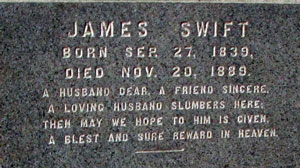
SWIFT, JAMES (1839-1889). Private, 13th Regiment, New York State National Guard, Company A. He enlisted in 1862 for a period of three months and served in Company A of the 13th New York Heavy Artillery. Swift last lived at 437 Monroe Street, Brooklyn. His widow applied for a pension in 1903, application 786,646. Section 167, lot 17697.
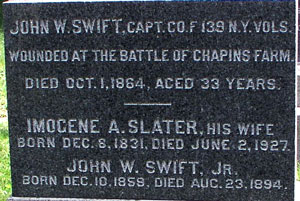
SWIFT, JOHN WILLIAM (1831-1864). Captain, 139th New York Infantry, Company F; first lieutenant, 47th New York Infantry, Company I; 176th New York Infantry, Company K; 52nd Regiment, New York State National Guard, Company D. Swift was born in Brooklyn. On December 23, 1856, he married Imogene Ann Slater in Manhattan on December 23, 1860. (See marriage certificate below.) As per the 1860 census, he was a trunk maker.
After enlisting at New York City as a second lieutenant on July 27, 1861, Smith was commissioned into the 47th Infantry on September 14, 1861, and was promoted to first lieutenant on January 16, 1862. At the time of his enlistment, he was a trunk maker who was 5′ 8″ tall with hazel eyes, black hair and a dark complexion. Swift fought at James Island and other engagements in South Carolina, and was discharged on July 7, 1862, after which he went North to restore his health and regain his strength. He was subsequently commissioned as a first lieutenant into the 176th New York Infantry on December 24, 1862, and discharged on February 9, 1863. On June 19, 1863, he was commissioned as first lieutenant into the 52nd National Guard and mustered out after 30 days on July 25, 1863, at Brooklyn. As per his obituary in the Brooklyn Daily Eagle, which confirmed his Civil War service and referred to him as a “Brooklyn Hero,” Swift helped raise Company F of the 139th New York but he was initially denied its captaincy due to “red tape.” However, after the Pennsylvania campaign and through the intervention of Governor Seymour, Swift was promoted to captain on October 27, 1863, and was commissioned on that date into the 139th New York Infantry with rank from July 29.
According to a descendant, Swift fought gallantly at Petersburg, Virginia, succumbed to battle fatigue and sunstroke in May 1864, and was hospitalized at Chesapeake Hospital in Fort Monroe, Virginia, before being granted a leave at the end of June 1864 to return to his home at 229 Walworth Street (near DeKalb Avenue) in Brooklyn. He returned to the battlefield in late July; while charging the enemy’s works at Chaffin’s Farm (also called Chapin’s Farm), Virginia, on September 29, he was mortally wounded by a shell and died at Point of Rocks, Virginia, on October 1, 1864. A hospital had been established at that location in 1864, a former plantation that was a Union observation point and Major General Benjamin Butler’s Headquarters.
The Brooklyn Daily Eagle published the letter that Chaplain G. G. Jones wrote to Mrs. Swift reporting on her husband’s death at City Point Hospital in Point of Rocks, Virginia:
I write to inform you of the sad news that your husband, Captain John W. Swift, Company F, 139th New York Volunteers, died at this hospital October 1st, at 9 P.M., of shell wound in the left thigh. He was here two days—suffered much, and yet was completely resigned. He had good care and everything desirable. He only desired to see his wife and children once more, but trusted in Christ and passed on to the better land. He was so calm, so patient, so Christ-like in these last hours while with us as a stranger, that he won upon all hearts.
Swift was interred at Green-Wood on October 23. The Brooklyn Daily Eagle said of him, “A braver or more worthy officer there was not in the service.” The New York Tribune reported that Smith’s funeral was held at the Fleet Street Methodist Church. His funeral service was filled to capacity and his rosewood coffin was adorned with the American flag, cap, sword and belt of the deceased. Members of his Masonic lodge and members of the 47th Regiment attended the funeral while a contingent from the 52nd Regiment National Guard escorted Smith’s remains to the grave. The burial was marked by military and Masonic honors.
On December 19, 1864, Imogene Swift, who is interred with him, applied for and received a widow’s pension, certificate 67,501. On June 20, 1873, his widow, Imogene, changed their son’s name from Thomas to John W. Swift Jr. (born December 10, 1859) to honor his memory; the Swifts also had two daughters. On August 5, 1926, Imogene Smith wrote to Winfield Scott, the Commissioner of Pensions, as a Civil War widow, requesting an allowance of $50 per month as authorized by an Act of July 3, 1926. Imogene Slater died in 1927 at her daughter’s home in Montclair, New Jersey; her funeral costs totaled $482. Section 13, lot 9514.
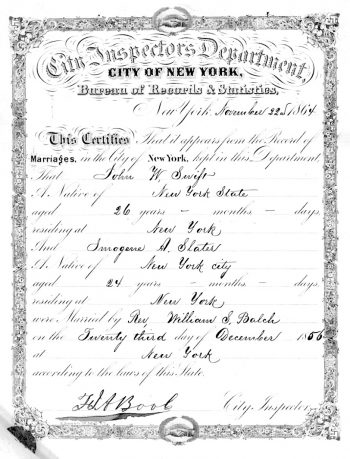
SWIFT, WILLIAM (1779-1864). Surgeon, United States Navy. Born in Massachusetts, Dr. Smith spent his medical career in the Navy beginning as a surgeon’s mate on July 24, 1813, and rising to surgeon on April 15, 1814. He retired on April 25, 1861, shortly after the Civil War began. His last address was 12 Carroll Park in Brooklyn. Section 158, lot 15579.

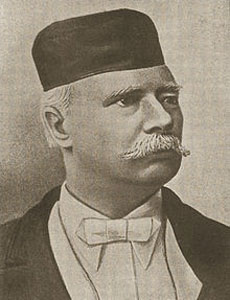
SWINTON, WILLIAM (1829-1892). Author and Civil War correspondent. A native of Scotland, he was educated in Toronto at Knox College and at Amherst College, then became a Presbyterian minister. However, he soon turned to teaching and then writing. In 1858 he joined the staff of The New York Times, and in 1859, collaborated with Walt Whitman on a book about word origins, Rambles Among Words: Their Poetry, History, and Wisdom.
In 1862, Swinton went to the front lines to cover the Civil War. His savage criticisms of generals soon made him very unpopular with authorities. In 1864, after he wrote critically of General Ambrose Burnside, reporting that the general got an entire Union regiment stuck in the mud, Burnside was so enraged that he wanted Swinton shot; restraining himself, he barred him from Army camps. On the night of May 5, 1864, during the Wilderness, Virginia, campaign, Swinton was caught eavesdropping behind a stump as Meade met with Grant, and he was stripped of his credentials as a correspondent and forbidden to remain with the Army.
In 1867, Swinton traveled through the South interviewing the military and civil leaders of the Confederacy. He wrote The Times Review of McClellan; His Military Career Reviewed and Exposed (1864), Campaigns of the Army of the Potomac: The Twelve Decisive Battles of the War (1866), (1867), and History of the New York Seventh Regiment During the War of the Rebellion (1870). He taught at the University of California, Berkeley, 1869-74, where he became involved in a controversy that enveloped the land grant college. Swinton, a humanities professor, befriended a populist, Henry George, the editor of San Francisco’s Daily Evening Post (who is also interred at Green-Wood). In 1872, George editorialized that the school had become a institution of “the classics” rather than a “college of industry,” its original intent. Although Swinton taught humanities, he sided with George and supported the Granges, the populist group that wanted to strip the California land grant colleges of any liberal arts classes. Upon his resignation in 1874, he moved back to Brooklyn and had great success writing sixteen school textbooks. He last lived at 292 Jefferson Avenue in Brooklyn. His remains were moved to the present location on May 7, 1893. Section 166, lot 28372, grave 2.
SWITZER, JAMES (1840-1925). First lieutenant, 66th New York Infantry, Companies C and D. Born in Ireland, Switzer enlisted as a corporal on August 8, 1861, at New York City, and mustered into Company C of the 66th New York. He rose through the ranks becoming a sergeant in November 1861, effective upon his transfer into Company D on November 30. On April 5, 1862, he became a first sergeant, and then on July 1, 1862, he was promoted to second lieutenant. After he was wounded on December 11, 1862, at Fredericksburg, Virginia, he became a first lieutenant on March 17, 1863, but did not muster in at that rank. He was discharged for disability on October 10, 1863. He applied for and received an invalid pension in 1864, certificate 57,501. His last residence was in Freeport, Long Island. Section 146, lot 24915.
SWITZER, JOHN H. (or M. H.) (1837-1896). Private, 84th New York (14th Brooklyn) Infantry, Company D. He enlisted at Brooklyn on April 18, 1861, mustered in on May 23, and mustered out on June 6, 1864. A member of the G.A.R., he last lived at 615 Halsey Street in Brooklyn. Mary Switzer, who is interred with him, applied for and received a widow’s pension, certificate 420,145. Section D, lot 19863.
SWITZER, MARTIN (1823-1863). Private, 2nd Infantry, United States Army, Company C. Switzer served as a private in the 2nd Infantry, United States Army. Further details of his service are not known. Section 115, lot 4196, grave 550.
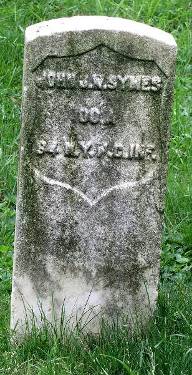
SYMES, JOHN J. N. (1846-1908). Private, 84th Regiment, New York State National Guard, Company A; 37th Regiment, New York State National Guard, Companies B and I. According to his government-issued gravestone, which his widow and other descendants had installed in 1928, he served in the 84th Regiment, New York National Guard. In 1863 and 1864, he served for 30 days in the 37th Regiment. In 1892, he was appointed an adjutant general of the second brigade of New York’s Grand Army of the Republic for its march through Washington, D.C. He was also a trustee of the Republican Club of the 23rd Assembly District of New York. He last resided at 259 West 129th Street in Manhattan. Shortly after his death in 1908, Annie Symes applied for and received a widow’s pension, certificate 677,099. Section 43, lot 5085, grave 1.

TACKABERRY, WILLIAM G. (1842-1912). Captain, 90th New York Infantry, Company B; second lieutenant, 70th New York Infantry, Company D; sergeant, 62nd New York Infantry, Company C. He enlisted as a sergeant at New York City on June 30, 1861, mustered into the 62nd New York on July 3, and was discharged two weeks later on July 15. Tackaberry then re-enlisted as a captain at New York City on October 3, 1861, was commissioned into the 90th New York Infantry on January 13, 1862, and was discharged on October 14, 1862. Two months later on December 19, 1862, he re-enlisted as a second lieutenant at New York City, was commissioned into the 70th New York on that day, and was dismissed on May 30, 1863. He resided on East 77th Street in Manhattan before he died of tuberculosis at the Manhattan State Hospital. Section 29, lot 10733.
TAFT, RICHARD V. (1840-1908). Hospital steward, 71st Regiment, New York State National Guard. After Taft enlisted as a hospital steward at New York City on May 28, 1862, he mustered immediately into the Field and Staff of the 71st New York’s National Guard, served three months, and mustered out on September 28 at New York City. At the time of his death, he lived at 421 Bloomfield Street in Hoboken, New Jersey. Section 81, lot 6742.
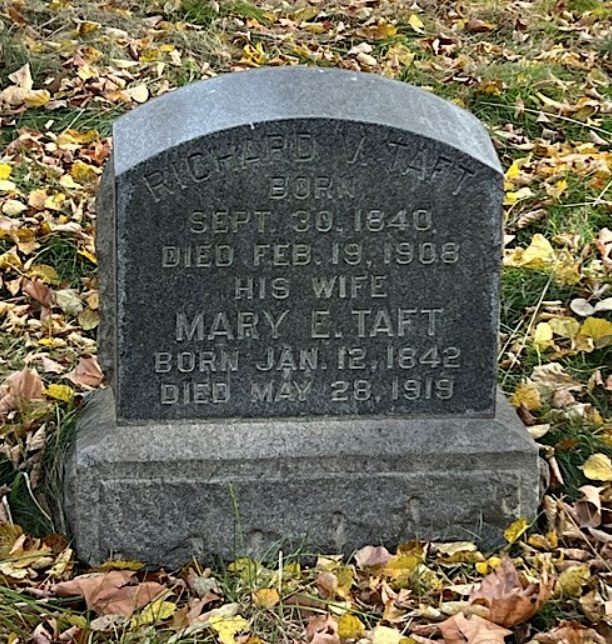
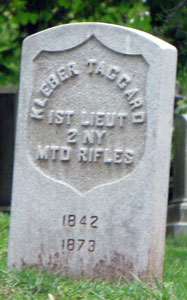
TAGGARD, KLEBER D. (1842-1873). First lieutenant, 2nd New York Mounted Rifles, Company K; private, 96th New York Infantry, Company K. Originally from Vermont, Taggard enlisted as a private at Plattsburg, New York, on April 13, 1864, and was discharged for promotion on November 26. On December 28, 1864, he re-enlisted as a first lieutenant, the same date that he was commissioned into the 2nd New York Mounted Rifles. He was dismissed on June 30, 1865. His last residence was on West 42nd Street in Manhattan. In 1906, Cordelia Taggard applied for and received a widow’s pension, certificate 957,147. Section 51, lot 8381.
TAGGARD, ROBERT SEYMOUR (1845-1864). Second lieutenant, 42nd New York Infantry; sergeant, 1st Connecticut Cavalry, Company K. A resident of Saybrook, Connecticut, Taggart enlisted as a second lieutenant on October 21, 1863, and was commissioned immediately into the 42nd New York but not assigned to any company. His method of discharge was not given, and he declined his commission on an unknown date. On January 4, 1864, he enlisted as a private and mustered into the 1st Connecticut Cavalry, was promoted to sergeant on January 18, and died of dysentery on October 4, 1864, at Baltimore, Maryland. Section 98, lot 78.
TAINTOR, CHARLES (1840-1887). Private, 22nd Regiment, New York State National Guard, Company A. Originally from Connecticut, Taintor enlisted as a private at New York City on May 28, 1862, mustered immediately into the 22nd Regiment, and mustered out after three months at New York City on September 5. He last lived in Port Richmond, Staten Island. His death was attributed to chronic nephritis. Section 72, lot 11446.
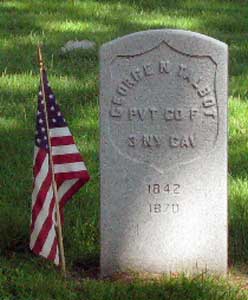
TALBOT, GEORGE N. (1842-1870). Private, 3rd New York Cavalry, Company F; 1st New York Mounted Rifles, Company H. After Talbot enlisted as a private at New York City on March 23, 1865, he mustered into the 3rd New York Cavalry six days later. He transferred into the 1st New York Mounted Rifles on July 21 of that year and deserted on August 2 from De Lamter Post Hospital at Norfolk, Virginia. He last lived at 268 Jay Street in Brooklyn. Section 180, lot 14857.
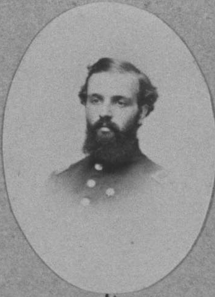
TALCOTT, EDWARD N. KIRK (1840-1901). Captain, 1st New York Engineers, Companies A and E; private, 7th Regiment, New York State National Guard, Company H. Born in Cuba, New York, he enlisted as a private at New York City on May 25, 1862, mustered into the 7th Regiment, and mustered out after three months on September 5. Prior to his leaving the 7th, he re-enlisted as a second lieutenant on August 28, 1862, and was commissioned into Company E of the 1st New York Engineers on September 3. After being promoted to first lieutenant on April 14, 1863, effective upon his transfer to Company A on July 7, he was transferred back to Company E on August 26 of that year.
Talcott was present as an engineer officer at these operations: the siege of Charleston, South Carolina (where he was praised in the official report); the siege of Petersburg, Virginia; and the movements along the James River. He was the depot engineer in Virginia at Bermuda Hundred and at Fort Monroe. Talcott was promoted to captain on January 9, 1865, was an aide-de-camp to General Gillmore beginning in March, served in the Florida expedition in 1865, and mustered out on August 1, 1865. He last resided in Goshen, New York. His death was caused by gastritis. In 1901, his widow, Lilian Talcott, applied for and received a pension, certificate 546,935. Section 158, lot 18547, grave 3.
TALLMAN, WARREN L. (1835-1862). Private, 53rd New York Infantry, Company B; 12th New York Infantry, Company D. Born in Brooklyn, Tallman enlisted as a private at New York City on August 26, 1861, mustered into the 53rd New York on September 2, and deserted on September 28 at Staten Island. Subsequently, he re-enlisted as a private at New York City on February 5, 1862, and mustered into the 12th New York. On May 21, 1862, he died from typhoid fever at City Hospital of New York. His name appeared on the list of Bodies in Transit. Section 100, lot 866.
TALLMAN (or TALMAN), WILLIAM DOWAH (1839-1905). Private, 5th New York Infantry, Company F. Born in New York City and a stone-cutter by trade, Tallman was 5′ 8″ with gray eyes, dark complexion, and brown hair. After he enlisted on April 25, 1861, at Fort Schuyler, New York, as a private, he mustered into the 5th New York on May 9. He was discharged for disability due to a pre-existing heart condition on May 19, 1862, at Baltimore, Maryland, from Patterson Park Hospital. He last lived at 93 Orient Avenue in Jersey City, New Jersey. Section 74, lot 10679, grave 5.
TALMAGE, JOHN FRELINGHUYSEN (1833-1897). Rank unknown, 11th New York Infantry. Talmage was born into a prominent family at Mont Verd, a community near Somerville, New Jersey. He was named for his mother’s brother-in-law, General John Frelinghuysen, who, during the War of 1812, commanded the New Jersey State Militia at Sandy Hook to prevent British ships from attacking New York City. His first cousin was Reverend T. DeWitt Talmage (see), a fiery preacher and another cousin was Thomas Talmage, the mayor of Brooklyn in 1845. He was educated at the academy in Somerville and was tutored by his pastor, the Reverend T. W. Chambers. As per his obituary, Talmage graduated from Rutgers College in 1852 (where Theodore Frelinghuysen, the son of his namesake, was then president), taught school and then taught ancient languages at an Alabama college. While in Alabama, he decided to study medicine there in Huntsville but returned to New York and was a graduate of the University of New York Medical College in 1859. Upon completion of his studies, he joined a medical partnership with Dr. A. Cooke Hull.
As per two of his biographical sketches of him, Talmage served with the 11th New York during the Civil War; one sketch notes that he served under General Jeremiah V. Meserole (see). In 1863, he married Maggie Hunt; the couple had four children. In 1866, he gained renown during the cholera epidemic. After Dr. Hull died in 1868, Talmage was later joined in practice by his brother, Dr. Samuel Talmage, in 1870. Active in his profession, he was a member of the American Institute of Homeopathy and other medical societies. In charitable work, Talmage was a physician at the Brooklyn Orphan’s Asylum, consulting physician at the Brooklyn Nursery, consulting physician at the Brooklyn Homeopathic Hospital and was department head at the Diseases of Women at the Brooklyn Homeopathic Dispensary. In addition, he was brigade surgeon for the New York State National Guard.
Talmage’s first wife died in 1881; he later married Louise Thaine. Aside from his large medical practice, he was a member of the Brooklyn, Crescent and Hamilton Clubs, as well as a director of the Brooklyn Philharmonic Society and the Brooklyn Mercantile Library. He last lived at 157 Joralemon Street in Brooklyn. He died in Rye, New York, at the home of his daughter, Lillian, who was married to Congressman J. Murray Mitchell. His death, after a long illness, was attributed to heart and kidney troubles. An article about his funeral in the Brooklyn Daily Eagle notes that the simple Episcopal service was held at his Brooklyn home; his casket was covered with black cloth and was adorned with elaborate silver handles. One of his grandsons, Edward T. H. Talmage, was a governor of the New York Stock Exchange. Section 75, lot 13020.
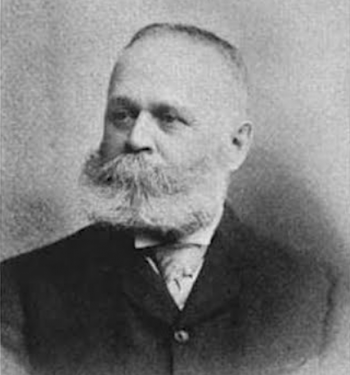

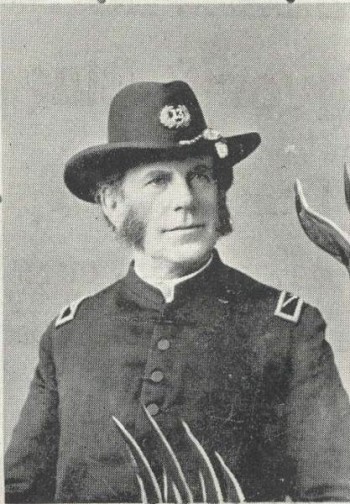
TALMAGE, THOMAS DE WITT (1832-1902). Chaplain, 40th Pennsylvania Militia Infantry; clergyman, editor, and lecturer. Talmage was born near Boundbrook, New Jersey, briefly studied law at the University of the City of New York, but turned to the ministry, following in the footsteps of many members of his family. In 1856, he graduated from the New Brunswick Theological Seminary and was ordained a minister of the Dutch Reformed Church.
During the Civil War, Talmage was chaplain of the 40th Pennsylvania Militia in 1863 and from July 2 until August 16, 1863, during and in the wake of General Robert E. Lee’s ill-fated invasion of the North. Talmage was a minister in Syracuse and Philadelphia before becoming the religious leader of the Central Presbyterian Church of Brooklyn in 1869.
Talmage’s sensational preaching style soon was drawing larger audiences than any other minister in America. His sermons were published weekly in 3,500 newspapers. To accommodate the throngs, a new building, the Tabernacle, was built; it burnt on Sunday morning, December 22, 1872, in one of the most memorable fires in Brooklyn history. The congregation met at the Brooklyn Academy of Music for the next two years, until a new and larger Tabernacle was completed. The second Tabernacle was destroyed by fire in 1889, and a third was built, then destroyed by fire in 1894.
Talmage was the most popular lecturer of his time; for many years he delivered one per week. He, with Reverend Henry Ward Beecher (see), escorted by police detectives, made regular trips to sin dens in Manhattan, in disguise, to gather material for sermons. His oratorical style, which had won him such fame, got him in trouble in 1879 when he was tried by the Brooklyn Presbytery for “falsehood and deceit and …using improper methods of preaching, which tend to bring religion into contempt.” He was narrowly acquitted of these charges. It was Talmage who first referred to New York City as the “modern Gomorrah.” But the author of Snares of New York felt that Talmage’s lurid sermons were the best advertisement for the sin business. Talmage worked in religious journalism, editing the Christian at Work (1874-76), Frank Leslie’s Sunday Magazine (1881-89), and the Christian Herald (1890-1902). He also wrote many books, including The Abominations of Modern Society (1872) and Rum, the Worst Enemy of the Working Classes (1886). He was a first cousin of Tunis Talmage (see). He last lived on Massachusetts Avenue in Washington, D.C. Section 167, lot 23437.

TALMAGE, TUNIS VAN PELT (1832-1909). Captain, 67th Regiment, New York State National Guard; member, United States Relief Committee. Originally from Clinton, New Jersey, he was educated in the public schools of New York City where his father, Thomas Talmage, was the sixth mayor of Brooklyn, elected in 1845. He moved to California at age 17 where he became a “forty-niner,” staying for three years. According to his obituary in The New York Times, he set out on his journey for California by way of the Isthmus of Panama, ran out of money in Colon, and worked his way up the coast as a sailor. He then moved to Brooklyn in 1852 where he was a street contractor and then worked in the coal business. Active in the Democratic Party politics, Talmage was elected supervisor from the Eighth Ward in Brooklyn in 1860 and was elected alderman in 1862.
During the Civil War, Talmage was a member and supervisor of the United States Relief Committee, helping widows of war veterans. In June 1863, he helped organize the 67th Regiment, enlisted at Brooklyn as a captain in that regiment (company unknown), and saw action at the Battle of Gettysburg, Pennsylvania. He was re-elected in 1864, at which time he resigned his commission and became president of the Board of Aldermen.
In 1865, Talmage ran for nomination of the Democratic Party for mayor of Brooklyn, losing the election by one vote in the City Convention to Marvin Kalbfleisch. In 1874, he was elected to the State Assembly and was responsible for sponsoring legislation related to the assessments for Prospect Park arguing that the park, which benefited the entire city, should have its tax burden shared equally rather than be paid only by those whose properties were adjacent to the greenery. Thomas De Witt Talmage (see) was his first cousin. His last residence was 216 Eighth Avenue in Brooklyn. Section 61, lot 13646, grave 5.
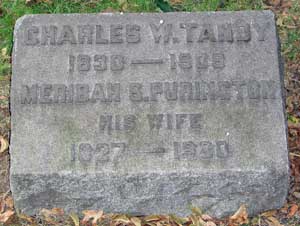
TANDY, CHARLES W. (1830-1909). Third sergeant, 13th Regiment, New York State Militia, Company C. Born in Hawks, New Hampshire, Tandy settled in Brooklyn in 1852 and established a business there in 1858. During the Civil War, he served for three months as a third sergeant with the New York State Militia in 1861.
The Brooklyn Directories for 1863, 1865, 1866, and 1868 list Tandy as a marble-cutter on 24th Street and Fifth Avenue. As per his obituary in the Brooklyn Daily Eagle, he belonged to the Lafayette Post #140 of the G.A.R. and the 13th Regiment Veteran Association; members of the 13th Veterans were asked to wear their badges to his funeral. In addition, he was a Freemason and a member of Odd Fellows. Tandy served on the board of directors of the Mechanics Bank, and belonged to the South Brooklyn Board of Trade and Society of Old Brooklynites. Active in politics, he belonged to the Twelfth Assembly District Republican Club and the Seventh Assembly Republican District. He last resided at 203 17th Street in Brooklyn. He died from peritonitis. Section 70, lot 19292, grave 2 and 3.
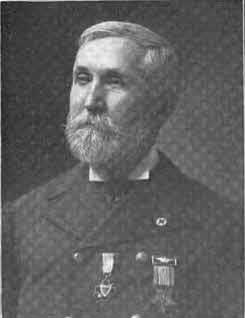
TANEYHILL (or TANNEYHILL), GEORGE LANE (1840-1916). Assistant surgeon, 11th Maryland Infantry. Born in Bellefonte, Pennsylvania, he was a graduate of Dickinson Seminary, class of 1858, and taught school until 1863. He then studied medicine and received his medical degree from the University of Maryland in 1865. In the closing months of the Civil war, he enlisted as an assistant surgeon on May 10, 1865, immediately mustered into the Field and Staff of the 11th Maryland, and mustered out on June 15, 1865, at Baltimore, Maryland.
Taneyhill then served as an assistant physician at the Maryland Hospital for the Insane until 1868. Among his many achievements were: president of the Baltimore Medical Association 1874-75; school commissioner of the Twelfth Ward; member of the Pension Examining Board; vice president of the Baltimore Obstetrical and Gynecological Society; physician to St. Andrew’s Society; and a founder of the Maryland Academy of Sciences. He died of heart disease in Baltimore, Maryland. Section 93, lot 10276.

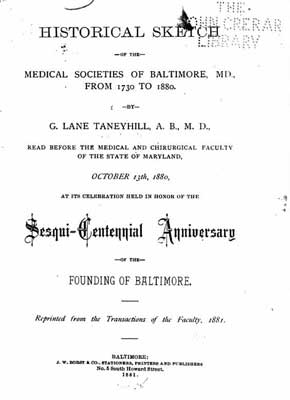
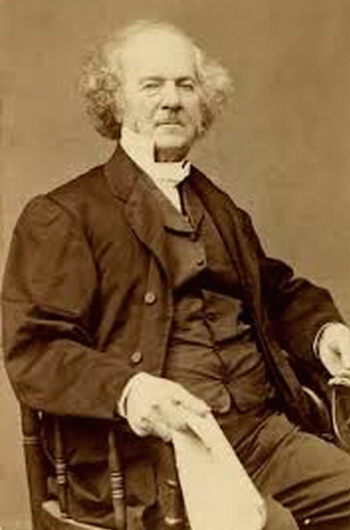
TAPPAN, LEWIS (1788-1873). Abolitionist, industrialist and philanthropist. Born in Northampton, Massachusetts, he was a merchant, dealing in wool and cotton mills, first in Philadelphia, Pennsylvania, and then in Boston, Massachusetts. Raised a strict Calvinist, he believed in cash transactions because the Bible prohibited money-lending and charging of interest. After his business failed due to poor investments, Tappan joined his brother Arthur’s successful silk business in New York City in 1827. (Their eldest brother, Benjamin Tappan, was an Ohio judge and Democrat who represented Ohio in the United States Senate from 1839-1845.) He maintained his strict religious teachings, gave away Bibles and crusaded against gaming houses and brothels.
The Tappan brothers met William Lloyd Garrison in 1830, and were part of the nationwide effort against slavery. Their actions did not sit well with other businessmen in New York and by 1834, Arthur’s business was stormed by mobs and Lewis’s house was attacked. In 1835, the brothers helped establish Oberlin College in Ohio, an institution that welcomed men and women and all races. But when faced with another business failure, the brothers reluctantly offered credit to investors. Although the business failed in the Panic of 1837, creditors were repaid and the business was re-instated two years later. Lewis Tappan, realizing that credit was the “new norm” for business, began keeping records on customers’ credit-worthiness and the Tappan Mercantile Agency soon had 280 clients and branch offices in Philadelphia, Boston, and Baltimore by 1844. In addition to his business ventures, he was simultaneously supporting the anti-slavery movement.
Arthur and Lewis Tappan played a major role in Amistad case, in which slaves mutinied off the coast of Cuba, but were later tricked by the crew and apprehended when their vessel arrived in Long Island in 1839. The Tappans worked to support the enslaved Africans when their case came to the United States Supreme Court in 1841. Arthur and Lewis Tappan helped secure top lawyers including former President John Quincy Adams, raised funds and organized the return trip to Africa for survivors of the ordeal when the Court ruled in their favor. In 1846, Tappan was among the founders of the American Missionary Association, an anti-slavery group that provided aid to abolitionist churches, mainly in the Midwest. Ultimately, Lewis Tappan gave up leadership of the day-to-day operations of his mercantile company in 1849, first to his chief clerk and then to Robert Graham Dun in 1858. (Eventually, R. G. Dun & Company merged with its main competitor in 1933, forming Dun & Bradstreet, the largest credit-reporting company in the world.)
Tappan, like other radical abolitionists, denounced the Democratic Party as pro-slavery and voted for Abraham Lincoln in 1860 and 1864. A supporter of the Emancipation Proclamation, he wrote to the Charles Sumner, “When will the poor negro have his rights? Not, I believe, until he has a musket in one hand and a ballot in the other.” Tappan retired from business in 1866 due to old age and failing health. After the Civil War, the American Missionary Society extended its outreach to found schools and colleges to aid in the education of freedmen and others in poverty. Among the most well-known of the schools are Berea College in Kentucky, Fisk University in Tennessee and Hampton Institute in Virginia.
His funeral was held at the Plymouth Church with Henry Ward Beecher (see) presiding. According to an article about his funeral in The New York Times on June 25, 1873, Tappan requested a simple burial and was buried in a plain rosewood casket with silver handles. Beecher said in his eulogy, “…Mr. Tappan was in every sense a Christian; and when others were afraid to speak, he came out boldly for the cause of freedom, and held on against the storm of abuse which met the cause for which he battled….” Black clergymen sent additional condolence resolutions to his family. He last lived at 218 Degraw Street in Brooklyn. Section E, lot 19728.
TAPPEN, EDWARD (1842-1918). Corporal, 5th New York Infantry, Company C. Tappen was born in New York City. The 1855 New York State census and the 1860 census indicate that he lived in New York City with his father, Daniel, a hay cartman, his step-mother Susan, siblings and extended family. During the Civil War, he enlisted on April 25, 1861, was promoted to corporal on October 15, 1862, and mustered out on May 14, 1863.
The Marriage License Bureau notes that Tappen married Anna Menge in Manhattan on March 27, 1872. The 1880 census reports that he was living at 293 St. Mary’s Street in Brooklyn and working as a clerk. Tappen was a member of the 5th New York Veterans Association and Warren Monument Committee. The 5th New York erected a monument in 1888 at Gettysburg to honor Gouverneur K. Warren, whose first command was the 5th New York. The statue of Warren is atop Little Round Top, where Warren, then Chief Engineer of the Army of the Potomac, recognized that that location was the key to the entire Union flank; Warren was injured there but remained on the field and was responsible for the desperate but ultimately successful defense of that hill. In a tribute to him on an unstated date, James E. Weir, a comrade from the 5th who died in 1903, noted that Tappen “proved himself a trustworthy man, insuring respect.”
In 1890, Tappen was living at 93 Eighth Avenue in New York City and was working in the trucking business. The 1900 census reports that he was living at 311 West 134th Street in Manhattan in a rental, was retired and a widower who lived with his son, who bore his name, and Elizabeth Tappen, age 22, relationship unknown. As per the 1905 New York State census, the 1910 census and the 1915 New York State census, he was living in Manhattan with his younger brother Silas. As per his obituary in the New York Tribune, he last lived at 145 Edgecombe Avenue in Manhattan. His obituary notes that friends, relatives, members of the 5th New York Volunteers and comrades of the Sumner Post #24 of the G.A.R. were invited to attend his funeral. Section 157, lot 15985.
TARR, GEORGE W. (1838-1862). Second lieutenant, 36th New York Infantry, Company H. A native New Yorker, Tarr enlisted there on April 28, 1861, and was commissioned into the 36th New York on June 24. He died of disease on May 17, 1862, at Fortress Monroe, Virginia. He likely was the brother of William F. Tarr (see). His remains were moved to the present location at Green-Wood on April 28, 1868. Section 164, lot 15971.
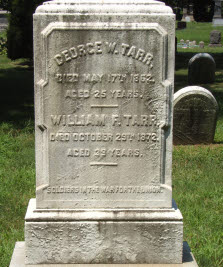
TARR, WILLIAM F. (1833-1872). Private, 36th New York Infantry, Company H. Tarr enlisted at New York City on May 13, 1861, and mustered into the 36th on June 24. After being discharged for disability on July 16, he re-enlisted on December 11, 1861, and mustered into the same regiment and company on that date. He mustered out on July 15, 1863. He likely was the brother of George Tarr (see) who also served in the 36th and is buried in the same lot. He last resided at 261 Carlton Avenue in Brooklyn. Section 164, lot 15971.
TARTTER, JACOB (or JAKOB) (1812-1885). First lieutenant, 55th Regiment, New York State National Guard, Company B. Of French birth, he enlisted and was commissioned into the 55th New York on June 24, 1863, at New York City. He mustered out after 30 days of service on July 27 at New York City. He last lived in Brooklyn. His death was attributed to “valvular of heart.” Section 199, lot 25007.
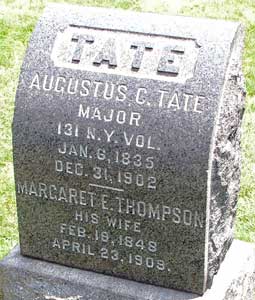
TATE, AUGUSTUS C. (1835-1902). Major, 131st New York Infantry, Company B; private, 12th Regiment, New York State Militia, Company D. Born in New York City, he was educated at the Charlotte Academy and then worked in his father’s dry goods store. During the Civil War, Tate first served for three months in 1861 with the 12th New York State Militia as a color sergeant, according to his obituary in the New York Evening Post. He subsequently re-enlisted as a captain at New York City on September 6, 1862, and was commissioned into the 131st on that day. He received a promotion to major on January 1, 1864. His obituary reports that he participated at the Battles of Irish Bend and Port Hudson in Louisiana and was in the Shenandoah Valley with General Philip Sheridan. He was discharged on January 2, 1865.
In 1869, Tate became a customs officer and four years later was appointed to a position in the office of the State Surveyor Alonzo Cornell. During the Presidency of Ulysses S. Grant, Tate was president of the Soldiers’ National Committee. President Chester A. Arthur appointed Tate United States marshal for the Eastern District of New York, a position that he held for seven years before becoming marshal of the Court of Appeals. In 1894, he was appointed Water Commissioner of Brooklyn, a position he held, except for a brief interval, until his death. Tate was a past commander of both the Thomas Devin Post #148 and the U. S. Grant Post #327 of the G.A.R., a Freemason, and member of the Union League of Brooklyn. At the time of his death, he lived at 404 Madison Street in Brooklyn. In 1903, Margaret Tate applied for and received a widow’s pension, certificate 625,921. Section 7, lot 22348, grave 5.
TATE, JOHN W. (1846-1913). First class boy, United States Navy. A New York City native, Tate enlisted as a first class boy and joined the United States Navy at some point during the Civil War. He was a member of the Grand Army of the Republic, George G. Meade Post #38 in New York City, as of 1886; as per his obituary in the New York Herald, members of the Meade Post were invited to attend his funeral. His last residence was 687 Hudson Street in Manhattan. Section 162, lot 15315, grave 4.
TATE, JR., THOMAS (1837-1893). Private, 22nd Regiment, New York State National Guard, Company C. Serving for three months in 1862, Tate, a native New Yorker, enlisted at New York City on May 28, mustered into the 22nd Regiment, and mustered out on September 5. He was a member of the George H. Thomas G.A.R. Post #5 in Chicago. Although he died of apoplexy in New York City, he last resided in Chicago, Illinois. In 1910, Amelia Tate applied for and was granted a widow’s pension, certificate 721,076. Section 182, lot 9178.
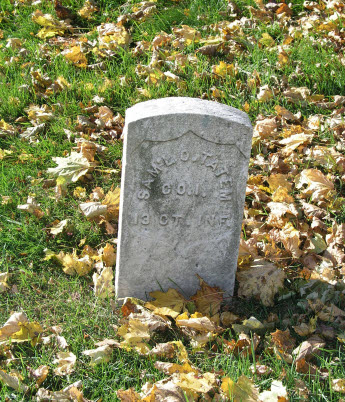
TATEM, JR., SAMUEL O. (1837-1913). Private, 13th Connecticut Infantry, Company I. A native of the West Indies and a resident of New London, Connecticut, Tatem enlisted as a private on January 8, 1862, mustered into the 13th Connecticut on January 22, and was discharged for disability on January 6, 1865. His obituary in the Brooklyn Standard Union, which confirms his Civil War service, states that he was a member of the Cushing Post #231 of the G.A.R. He last lived at 287 9th Street in Brooklyn. Section 15, lot 14888 grave 14.
TAVERNIER, PHILLIP (or PHILIP) (1838-1922). Corporal, 4th New York Infantry, Company D. Of German origin and a hatter according to the Civil War Draft Registration records, Tavernier enlisted at New York City as a private on May 18, 1861, mustered into the 4th New York on that date, and was promoted to corporal on April 27, 1862. On December 13, 1862, he was wounded in action at the Battle of Fredericksburg, Virginia. He was discharged with his company on May 25, 1863, at New York City.
Tavernier became a naturalized citizen on October 26, 1876. As per the census of 1880, he was a hatter by trade. His application for an invalid pension was granted in 1879, certificate 854,632. He last resided at 406 Atlantic Avenue in Freeport, New York. His death was caused by arteriosclerosis. Section 203, lot 32988, grave 1.
TAYLOR, ANDREW B. (1843-1864). Private, 38th New York Infantry, Company K; 40th New York Infantry, Companies H and D. After enlisting as a private on June 3, 1863, Taylor mustered into Company H of the 40th New York having had previous service in the 38th New York. He was wounded in action on May 5, 1864, at the Battle of the Wilderness, Virginia, and had an intra-regimental transfer to Company D on July 7, 1864. On October 15, 1864, he died of gunshot wounds in Virginia. Section 55, lot 15411.
TAYLOR, CHARLES A. (1848-1913). Musician, 155th New York Infantry, Company A. Taylor was originally from England and enlisted on September 17, 1862, at the age of 14. He mustered into the 155th on November 18. On May 14, 1864, he deserted at Burke’s Station, Virginia. Taylor was living in Brooklyn at 305 10th Street when he died nephritis. Section N, lot 28941, grave 2.
TAYLOR, CHARLES F. (1841-1921). Private, 8th Regiment, New York State Militia. A native of New York City, Taylor’s pension index card notes that he enlisted on April 20, 1861, served in the 8th Regiment, New York State Militia, and mustered out on August 2, 1861.
The 1890 Veterans Schedule confirms Taylor’s service in the Civil War. In 1904, he applied for and received an invalid pension, certificate 1,092,221. As per the census of 1920, he was a widower who was living in Manhattan and working as a salesman. He last lived at 300 Elizabeth Street in Manhattan. He died at Flower Hospital from edema of the lungs. Section 202, lot 26056, grave 2.
TAYLOR, EDWIN C. (1843-1882). Private, 83rd New York Infantry, Company E. A New York City native, he enlisted there on October 2, 1861, and mustered immediately into Company E of the 83rd New York. At some point in 1862, he deserted. Taylor last lived at 120 East 24th Street in New York City. He succumbed to pneumonia. Section 186, lot 22737.
TAYLOR, FREDERICK (1837-1866). Private, 2nd New York Heavy Artillery. Born in New York State, Taylor enlisted as a private at New York City on October 17, 1864, mustered into the 2nd New York Heavy Artillery that day but was not assigned to a company. Further details of his service are unknown. His last residence was in New York City. Section 183, lot 20303.
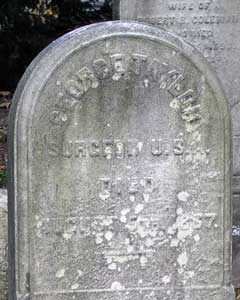
TAYLOR, GEORGE (1831-1867). Lieutenant colonel by brevet; surgeon, United States Army Medical Staff. Born in Baltimore, Maryland, he was commissioned as an assistant surgeon in the United States Army Medical Staff on April 1, 1856, and was promoted to surgeon with the rank of major on August 27, 1862. He was brevetted to lieutenant colonel on March 13, 1865, for “faithful and meritorious service during the Civil War,” and died from yellow fever on August 5, 1867. His last residence was in Baltimore but he died from yellow fever in Galveston, Texas. Section 22, lot 3745.
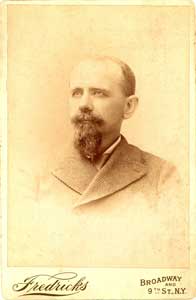
TAYLOR, GEORGE WASHINGTON (1840-1906). Private, 57th New York, Company C. After enlisting as a private on October 1, 1861, at Brooklyn, Taylor, a New York native, mustered in on October 18. A clerk by occupation, he was 5′ 6″ tall with black hair, blue eyes and a fair complexion. According to the 57th’s regimental history, describing its action at the Battle of Fredericksburg, on December 13, 1862, Taylor was one of six men on the advance line with the regimental colors. They desperately tried to get the colors off the field to avoid complete disgrace from their loss at Marye’s Heights. Taylor was seriously wounded in the right thigh and carried off the field while the others followed with the “saved flag laughing in the breeze.” Although mentioned as a corporal in the Regimental history, that rank is not indicated on his soldier history. As a result of his wound, he was discharged for disability on February 28, 1863, at Campbell Hospital in Washington, D.C.
In 1863, he applied for an invalid pension, certificate 27,538, later submitting detailed descriptions recounting how his shortened leg caused chronic pain. As per his obituary in the New York Herald, members of the 57th Regiment were invited to attend his funeral. He last resided at 1083 Dean Street in Brooklyn. In 1908, his widow, Margaretta B. Taylor, received a pension, certificate 667,116. Section 197, lot 32396.
TAYLOR, JAMES (1850-1904). Private, 19th Infantry, United States Army, Company F. Originally from Ireland, Taylor enlisted as a private in the United States Army and mustered into Company F of the 19th Infantry, U.S. Army. Further details are unknown. A member of the G.A.R.’s Joseph Hooker Post #128, his last residence was 67 Marion Street in Brooklyn. Section 128, lot 31394, grave 321.
TAYLOR, JAMES A. (1843-1928). Sergeant, 46th Massachusetts Infantry, Company D. A native of Gramby, Massachusetts, Taylor was a student when he enlisted as a sergeant at Chicopee, Massachusetts, on August 21, 1862, and mustered into the 46th Massachusetts on September 25. He mustered out on July 29, 1863, at Hampden Park in Springfield, Massachusetts. He applied for an invalid pension that was granted, certificate 1,133,558. His last residence was 914 3rd Place in Plainfield, New Jersey. Shortly after his death in 1928, his wife applied for and received a widow’s pension, certificate a-4-11-29. Section 150, lot 18799.
TAYLOR, JAMES LAWRENCE (1840-1861). Private, 5th New York Infantry, Company B. A native of New York, Taylor was a nephew of Moses Taylor, President of the City Bank in New York. A resident of Stamford, Connecticut, at the onset of the Civil War, James Lawrence Taylor enlisted on May 9, 1861, mustering into Company B of the 5th New York, known familiarly as Duryée’s Zouaves. He was wounded in the groin on June 10, 1861, at Big Bethel, Virginia (possibly from “friendly fire”), and died the next day (though some records list him as “killed in battle” on June 10). He was the first Stamford resident to die in the Civil War.
According to Alfred Davenport in Camp and Field Life of the Fifth New York Volunteer Infantry, when Taylor heard that his injury was mortal, he said to his friend, Corporal (later colonel) W. H. Gilder, “That’s all right, ‘Gilly,’-don’t bother about me; I can’t live-take some one off the ground who can live, and fight again.” Gilder later secured transportation for his dying friend after he removed him from the wagon to make room for another who could live. Taylor was buried in Green-Wood on May 31, 1865. Section 11, lot 2524.
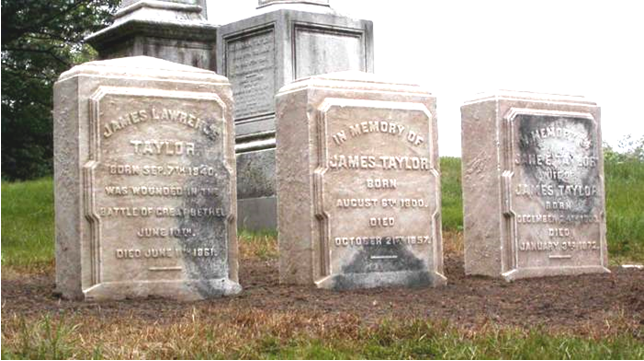
TAYLOR, JAMES W. (1830-1896). Captain, United States Navy. Taylor, who was born in New York, enlisted in the United States Navy on November 15, 1864, and was appointed acting master and pilot on that date. At some point, he was promoted to captain before his appointment was revoked on March 9, 1865. His last residence was 479 9th Street in Brooklyn. In 1914, Annie Taylor, who is interred with him, applied for and received a widow’s pension, certificate 14,614. Section 143, lot 23328, grave 3.
TAYLOR, JOHN HENRY (1837-1918). Acting master’s mate, United States Navy. Taylor was born in New York. His application for a pension from the Navy, dated May 21, 1912, indicates that he enlisted as an ordinary seaman at Brooklyn on January 22, 1861. At the time of his enlistment, he was a sailmaker who was 5′ 8″ tall with dark eyes, dark hair and a dark complexion. He was discharged at Washington, D.C., on November 15, 1863. Subsequently he re-enlisted and served on the USS Adolph Hugle from November 20, 1863, through September 1864; the aforementioned schooner was used as a gunboat in support of Union blockades and was also equipped for shore bombardments. Taylor also served on the USS Teaser, a steamer; the USS Matthew Vassar, a gunboat; and the USS Arletta, a gunboat in support of the Navy blockade.
After Taylor was discharged on September 5, 1865, he lived briefly in West Farms, New York, and then settled in Brooklyn. On March 22, 1914, he mustered into the Abel Smith Post #435 of the G.A.R.; he indicated that he lived in Brooklyn and was a painter. Taylor received a pension from the Navy of $30 per month, certificate 30,394. As per his death certificate, he was a painter at the Navy Yard. He last lived at 1447 Bushwick Avenue in Brooklyn. His death was attributed to chronic endocarditis (inflammation of the lining of the heart). Section 114, lot 8999, grave 813.

TAYLOR, MARCUS BARNES (1843-1919). Commissary sergeant, 93rd Illinois Infantry, Company A. Originally from Watertown, New York, Taylor’s family moved to Illinois when he was three years old. He entered Knox College in 1859 to study for the ministry but his health failed and he returned home to farm in Rock Island County. During the Civil War, he enlisted as a sergeant on August 2, 1862, mustered into Company A of the 93rd Illinois on October 13, and was promoted to commissary sergeant on July 13, 1863. Taylor was wounded in the right shoulder at the Battle of Allatoona, Georgia, on October 5, 1864. The bullet was not removed but he was furloughed and rejoined his regiment at Savannah, Georgia. He mustered out on June 2, 1865.
When Taylor returned home, he was asked to take the census of Rock Island and then left for Kansas where he was in the drug business. After nine years in that enterprise in Kansas and Iowa, he entered the Methodist ministry in 1874. He served in Brownsville, Pennsylvania, then Cincinnati, Ohio, and Beaver Falls, Pennsylvania, before taking up additional studies at Boston University. He spent a short time at Adrian, Michigan, where he also was acting president of Adrian College. He returned to Boston for further studies and then served as pastor of the Congregational Church in Canton, Massachusetts, for twelve years. He applied for and received an invalid pension in 1878, certificate 156,155. In 1885, he mustered into Post #94 of the Massachusetts G.A.R., serving six years as its commander and four years as its chaplain. He was the department chaplain in 1895 and 1896, a delegate to the 30th National Encampment at St. Paul, Minnesota, in September 1896, and elected chaplain-in-chief of the G.A.R.
After Taylor moved to Brooklyn, he was a member of the Ulysses S. Grant Post #327 and appointed to the committee on the Lincoln Memorial. His obituary in The New York Times, which confirms his leadership in the G.A.R., reports that he moved to Brooklyn in 1898 to become pastor of the Park Congregational Church. He last lived at 427 7th Street in Brooklyn. In 1920, his wife applied for and received a widow’s pension, certificate 891,364. Section 175, lot 26629, grave 1.
TAYLOR, STUART MOLLAN (1838-1895). Lieutenant colonel and major by brevet; captain and assistant adjutant general, United States Volunteers; paymaster, 55th New York Infantry. A New Yorker by birth, his death notice indicates that he was the only son of Dr. Isaac E. Taylor, the president of Bellevue Hospital, and Eliza Mary née Mollan.
During the Civil War, he enlisted at Staten Island as a paymaster on August 1, 1861, and mustered into the 55th New York’s Field and Staff on August 28, but rendered no service in that regiment. On December 23, 1862, he was commissioned as captain and assistant adjutant general of United States Volunteers Adjutant General’s Department. A letter for sale on eBay in October 2022 reports that Taylor wrote from Beaufort, South Carolina, on November 10, 1864, about a “mistake” in the discharge case of private George Lackey in Company F of the 26th United States Colored Troops. The 26th U.S.C.T. was organized at Rikers Island, New York, on February 27, 1864, and attached to the Department of the South at Beaufort. As per Frederick A. Dyer in “A Compendium of the War of the Rebellion,” volume 3, the regiment saw action at Johns and James Islands from July 2 through July 10 and later at Honey Hill on November 30, Devaux’s Neck on December 6, Tillifinny Station on December 9 and McKay’s Point on December 22, before returning to Beaufort on January 2, 1865. Taylor was brevetted to major and lieutenant colonel on March 13, 1865, “for faithful and meritorious service during the War,” and mustered out on October 31, 1865. Taylor had been officially relieved of his position as assistant adjutant general on October 14 at Beaufort.
The aforementioned listing on eBay indicates that Taylor was a post-war assistant adjutant general on the staff of General Rufus Saxton and Oliver Otis Howard in charge of the Bureau of Refugees, Freedmen, and Abandoned Lands.” In that position, he was tasked with facilitating the transfer of formerly enslaved people to a free life.
As per his obituary in the Sacramento Bee, Taylor married Gertrude Judge in 1870; she was the granddaughter of Harry Thornton, who was well-known on the west coast. His biography on eBay details that he was a naval officer of the Customs House in San Francisco in the 1880s and was also a featured political speaker. An active Republican, he gave the nominating speech for former Union General William S. Rosencrans at the Union Hall in Los Angeles on October 18, 1880, in support of Rosencrans’s bid for Congress,
As per an article in the San Francisco Examiner, Colonel Taylor addressed a large Democratic Party gathering as chairman of the citizenry who demanded that the legislature address the powerful railroad corporations to make sure that laws are observed and the “people” were not taken advantage of. He urged the people to elect legislators who supported these goals. In his address, he reiterated the purpose of the gathering:
…It is to deliberate thoroughly on the old and tiresome controversy between the railroad corporations and the people as to which are masters and which are servants, and whether or not these common carriers of person and property shall act in conformity with the equitable laws made for the public good—made for him who owns a few dollars and half an acre as well as for the benefit of him whose capital is exhaustless and who counts his fruitful acres by mile stones. We are here to express our convictions in temperate, but strong and earnest words, that while railroads have their rights, the State is above the corporations; that the people are above the corporations; that the law is above the corporations; that the railroads are public highways; and while the law will encompass them with the shadow of its shield, it will tolerate no neglect of their duties, no forgetfulness to fulfill obligations, and will demand the payment in full of all taxes and penalties, the same as they are exacted from you and me. We demand that those who preside over these public highways shall manage them as trusts confided to them by the public for their use and benefit, and not for purposes of self-aggrandizement.
In another article in the San Francisco Examiner on March 14, 1887, Taylor was reported to be present at a meeting held at a veterans home in Yountville, California, that housed a farm and was in need of a new cottage funded by the G.A. R. (Grand Army of the Republic), an organization of Civil War veterans. In addition, the results of a new election for the Board of Directors were announced; Taylor demanded a new election after the San Francisco members were ousted. After a discussion and review, it was determined that the by-laws had not been followed and a new election took place; Taylor and the two ousted San Francisco men were then among the nine directors elected along with two veterans of the Mexican War.
In addition to being a commandant of the Soldiers’ Home in Yountville, Taylor was an officer in the George H. Ward Post #10 of the G.A.R. in Worchester, Massachusetts (years unknown) and a corresponding secretary of the Military Order of the Loyal Legion, a patriotic organization of former Civil War officers.
The San Francisco Examiner reported on April 5, 1888, that Colonel Stuart Taylor was at the Pacific Kennel Club’s bench show where his prized bull-terrier again won first prize. The animal was the only one in the room surrounded by a wire screen to protect it from the hands of the public. Unlike other bull-terriers who bore marks from dog-fighting, Taylor’s dog was described as “smooth and clear as oil.”
He died in Paris, France, on October 7, 1895, after an illness confined him as of June 23 with a chest tumor complicated by pneumonia. His apartment in Paris was at 24 Rue François Premier, as per an obituary posted on the Find a Grave website. His obituary in the Sacramento Bee on October 8, which has a secondary headline that he was well-known and had a brilliant war record, notes that he took ill in June after a visit to the United States. His wife was with him when he died in Paris. He was also survived by three sisters. Section 139, lot 26885, grave 11.
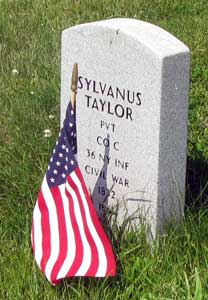
TAYLOR, SYLVANUS (1832-1861). Private, 36th New York Infantry, Company C. After enlisting on September 12, 1861, at New York City, and mustering in on that date, Taylor died of typhoid fever on November 19, 1861, at Washington, D.C. He was interred at Green-Wood on November 26, 1861. Section 126, lot 2458, grave 431.
TAYLOR, WALTER G. (1839-1861). Private, 84th New York (14th Brooklyn) Infantry, Company H. A native of Virginia, he enlisted on April 18, 1861, mustered into the 14th on May 23, 1861, and was killed in a skirmish with Confederate cavalry while on picket duty. Taylor suffered a sabre wound to his right thigh, a ball in his left thigh, and two balls through the chest on November 18, 1861, on the Fairfax Road, Upton’s Hill, two and one-half miles beyond Falls Church, Virginia. Reverend John S. Inskip (see), chaplain of the regiment, celebrated Taylor’s heroic death along with the demise of fellow soldier James Seymour (see), at the Washington Street Methodist Church in Brooklyn on November 22, 1861. According to the Company Muster Roll, dated February 28, 1862, his personal effects were delivered to his brother Robert on December 4, 1861. His remains were moved to this location on May 2, 1863. Section 180, lot 13940.
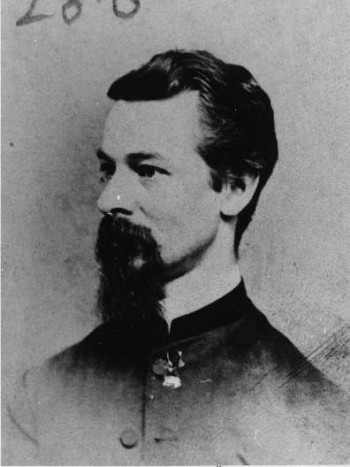
TAYLOR, WILLIAM HOWELL (1833-1914). Chaplain, 48th New York Infantry; second lieutenant, 6th New York Infantry, Companies D and A. Born in New York City, he enlisted there as a private on May 26, 1861, and mustered into Company D of the 6th New York. On April 29, 1863, he was promoted to second lieutenant and transferred into Company A. He mustered out on June 25, 1863. On May 13, 1864, he re-enlisted as a chaplain at Bermuda Hundred, Virginia, was commissioned into the 48th New York’s Field and Staff, and was discharged on May 14, 1865. He died of uremia in Richmond, Virginia, but his residence had been 75 Park Avenue, Manhattan. Section 153, lot 17772.
TAYLOR, WILLIAM J. (1840-1898). Second lieutenant, 47th Regiment, New York State National Guard, Company G; corporal, 13th Regiment, New York State Militia, Company G. Taylor enlisted and was commissioned into the 47th Regiment on May 27, 1862, after having previously served in the 13th Regiment, Company G. After completing his three months of duty, he mustered out on September 1 at Brooklyn. As per his obituary in the New York Herald, he was a member of the Abel Smith Post #435 of the G.A.R. and a Freemason; members of both organizations were invited to attend his funeral. He last resided at 138 Hewes Street in Brooklyn. Taylor died from apoplexy. Section 159, lot 16666, grave 5.
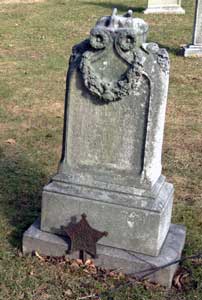
TAYLOR, WILLIAM W. (1837-1910). First lieutenant, 15th New York Heavy Artillery, Companies F and I; private, 22nd Regiment, New York State National Guard, Company D. Taylor enlisted as a private at New York City on May 28, 1862, mustered into the 22nd Regiment, and mustered out after three months at New York City on September 5. He re-enlisted as a first lieutenant at New York City on August 27, 1863, was commissioned into Company F of the 15th Heavy Artillery on September 12, and resigned on April 25, 1864, at Brandy Station, Virginia. His pension and soldier records indicate that he was in Company I and also Company C.
The Veterans Census of 1890 confirms Taylor’s military service in the 15th Heavy Artillery. In 1904, he applied for and received an invalid pension, certificate 1,093,670. As per his obituary in the New York Herald, he was a member of the James Monroe Post #607 of the G.A.R.; comrades were requested to attend his funeral. He last lived at the corner of St. Nicholas Place and 145th Street in the Bronx. In 1911, Isabella Taylor applied for and received a widow’s pension, certificate 730,308. Section 81, lot 3264, grave 1.
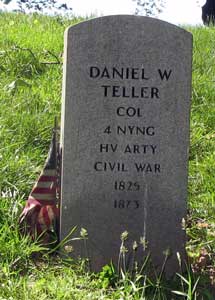
TELLER, DANIEL W. (1825-1873). Colonel, 4th Regiment, New York State National Guard Heavy Artillery. Teller was a New York City merchant who enrolled as colonel of the 4th New York National Guard Heavy Artillery in June 1863 and served for 30 days. He once financed and equipped an expedition to conduct a survey of the Isthmus of Panama as a possible site for a canal. He died in New York City. Section 86, lot 17340, grave 16.
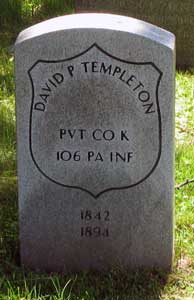
TEMPLETON, DAVID P. (1842-1894). Private, 106th Pennsylvania Infantry, Company K. Born in Pittsburgh, Pennsylvania, he enlisted and mustered into the 106th Pennsylvania on December 12, 1861. In 1893, he applied for and was granted an invalid pension, certificate 897,926. A resident of West 60th Street in Manhattan, he died at Middletown State Hospital in New York. Emma Templeton applied for and received a widow’s pension, certificate 416,249. Section 154, lot 21751.
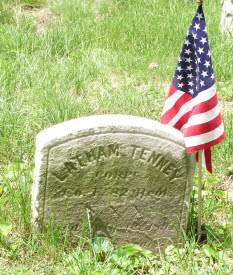
TENNEY (or TINNEY), LATHAM (1846-1894). Corporal, 82nd New York Infantry, Company F. Born in Ireland, he enlisted at New York City as a private on April 17, 1861, and mustered into the 82nd New York the following month on May 21. He was discharged for disability on October 4, 1864, at DeCamp Hospital, David’s Island, New York Harbor.
In 1864, Tenney applied for an invalid pension, certificate 40,548. In civilian life, he was an inspector for the United States Customs House. Continuing his interest in military affairs, he was a member of the Ulysses S. Grant Post #327 of the G.A.R. He last resided at 65 Linden Street, Brooklyn. Section 115, lot 11193, grave 435.
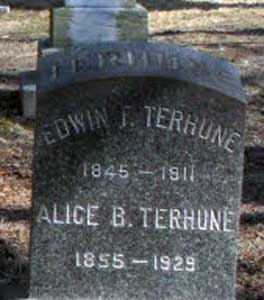
TERHUNE, EDWIN (or EDWARD) FORREST (1845-1911). Musician, 4th New York Infantry, Band; 7th Regiment, New York State National Guard, Company I; drummer, 71st Regiment, New York State Militia, Company G. After serving for three months as a drummer in the 71st New York State Militia in 1861, he enlisted at New York City as a musician on October 10, 1861, and mustered into the band of the 4th New York Infantry. He mustered out on April 21, 1862, at Fort McHenry, Baltimore, Maryland. Terhune re-enlisted the following May 25 at New York City, once again as a musician, and mustered into Company I of the 7th New York National Guard. On September 5, 1862, he mustered out at New York City.
Terhune applied for a pension in 1907 that was approved under certificate 1,151,872. He last resided in at 321 Locust Avenue in Port Chester, New York. Alice Terhune, who is interred with him, applied for and received a widow’s pension shortly after his death in 1911, certificate 736,579. Section 83, lot 2404.
TERHUNE, JACOB (1838-1868). Corporal, 22nd New Jersey Infantry, Company A. A native New Yorker, Terhune enlisted as a corporal on September 1, 1862, mustered into the 22nd New Jersey on September 22, and was discharged for disability o April 24, 1863, at Washington, D.C. He last lived in Brooklyn at 114 Ludlow Street. Section 127, lot 8259, grave 79.
TERRETT, CHARLES WILLIAM (1841-1872). Private, 7th Regiment, New York State National Guard, Company B. A native of New York, Terrett graduated from Columbia College the morning of his enlistment into the Union Army. He served in the 7th New York National Guard when it was activated for three months in 1862. In 1890, Eleanor Terrett, his mother who is interred with him, applied for a pension, application 483,329, but no certification number is listed. He last lived at 35 West 24th Street in Manhattan. His death was caused by phthisis. Section 54, lot 7089.

TERRY, DAVID D. (1841-1885). Captain, 176th New York Infantry, Company E. Born in New York State, Terry enlisted at New York City as a captain on September 14, 1862. On December 18, 1862, he was commissioned into the 176th and mustered out on December 12, 1863, at New York City. His last residence was 27 3rd Place in Brooklyn. His wife, Eleanor Terry, applied for a widow’s pension that was granted in 1890, certificate 336,487. Section 157, lot 21727.
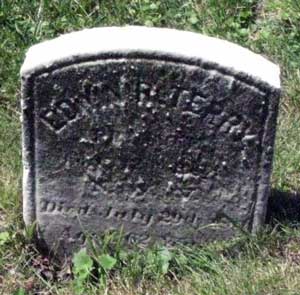
TERRY, EDWIN R. (1829-1891). Private, 12th New York Infantry, Company C. Terry enlisted as a private on November 17, 1861, at Patchogue, New York, mustered into the 12th New York on November 29, and was discharged for disability on October 24, 1862. In 1888, Terry filed for and was granted an invalid pension. He last resided at 3 Jackson Place, Brooklyn. Following his death, his widow applied for a pension which was granted, certificate 317,658. Section 6, lot 20118, grave 837.
TERRY, HORACE E. F. (1841-1868). Private, 22nd Regiment, New York State National Guard, Company A. Born in Orange County, New York, he enlisted at New York City as a private on May 28, 1862, for a period of three months and mustered into Company A of the 22nd Regiment that day. He mustered out at New York City on September 5, 1862. His last residence was 119 Bowery, Manhattan. Section 114, lot 8999, grave 888.
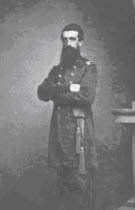
TERRY, OLIVER L. (1824-1889). Major, 13th New York Infantry. After enlisting at Rochester, New York, on May 8, 1861, Terry was commissioned as major of the 13th New York six days later, and resigned on January 9, 1862. He last resided at 45 Perry Street in Manhattan. Terry died from meningitis. Section 6, lot 20118, grave 791.
TEURS, CHARLES (?-?). Rank unknown, 45th Pennsylvania Infantry, Company B. Teurs served in the 45th Pennsylvania and was only 15 years old when he was killed during the War. Although the details of his service are unknown, his story was recounted in a May 28, 1890, article in the Brooklyn Daily Eagle about remembering Civil War veterans on Decoration Day as told by Joseph Woodward (see), a G.A.R. member. Section ?, lot ?.
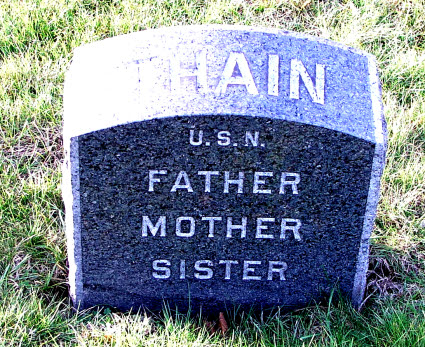
THAIN, WILLIAM WALSON (1837-1872). Acting third assistant engineer, United States Navy. Born in Scotland, Thain’s family immigrated to the United States in 1843, where they settled in Antioch, Illinois, and purchased a farm. According to a descendant, he ran away from home in 1854, traveled west and eventually joined the Navy for a period of five years. When he served as a gunner mate at the Navy Yard in Brooklyn, he established his home in that area.
At the start of the Civil War, Thain was employed as a locksmith but returned to the Navy on December 29, 1862, and was assigned to the Navy Yard. In mid-1863, he was an acting third assistant engineer aboard the Norwich which was part of the Atlantic Squadron blockading the shipment of Confederate supplies to Jacksonville, Florida. After his honorable discharge on October 30, 1865, he returned to civilian life as an oil refiner and then owned a hardware store on Fifth Avenue in South Brooklyn. Section 17, lot 17245, grave 1719.
THALL, RICHARD SEWELL (1835-1905). Acting second assistant engineer, United States Navy. Thall was born in Brooklyn, the second of six children. His father had a successful bakery on Delancey Street in Manhattan and Richard went to work there. The 1860 census reports that he was living in New York City, was employed as a master baker and had a personal estate of $200.
During the Civil War, Thall enlisted as an acting third assistant engineer in the Navy as of March 4, 1863, and subsequently was promoted to acting second assistant engineer on February 1, 1865. As per Chris Foley, whose wife is a descendant, Thall served in both the Atlantic and Gulf Blockading Squadrons onboard the steamships Ceres, Kineo, Nyack and Sumter. His service record shows “other service date” on February 1, 1865. Thall’s name is listed among those honorably discharged in the U.S. Navy and Marine Corps Registries, 1814-1992. As per one soldier record, a Richard Thall is also listed as a carpenter in the USA military (no branch identified) from 1866 to 1868. He was honorably discharged on June 20, 1868.
In 1868, he married Ella Celinda Brownell of Springfield, Massachusetts; they had a daughter and two sons. At the time of the 1870 census, Thall was living in Williamsburg, Brooklyn, with his wife and working as a laborer. The 1875 New York State census shows him living in Brooklyn with his wife and two young children. As per the 1880 census, he was a baker living at 121 4th Street in Brooklyn with his wife, daughter, son and father; he owned a wholesale and retail bakery business. As per a special schedule of the 1880 census, he had $1200 invested in his baking business, employed three men and one boy, and had paid $2184 in wages that year. The 1890 Brooklyn Directory reports that he was a baker and lived at 349 Bedford Avenue. According to the 1900 census, he was a widower living with his two sons and a housekeeper at 753 Jefferson Avenue, in a house that he owned (mortgaged). He was still working as a baker. In 1901, he applied for and received a pension of $12 per month from the Navy, certificate 30,888.
As per his obituary in Brooklyn’s The Chat, he was a well-known retail and wholesale baker until about 1890, with several establishments in Williamsburg. In addition, he was a member of the Christ Protestant Episcopal Church for about 20 years; the reverend of that church conducted his funeral services. That obituary confirmed his service during the Civil War in the Navy and his being aboard the Sumter and the Nyack.
Thall’s service in the United States Navy is confirmed by Edward W. Callahan’s List of Officers in of the Navy of the United States and the Marine Corps from 1775 to 1900, his Navy pension index and his obituary in the Brooklyn Standard Union. A widower whose wife died in 1896, he last lived at 753 Jefferson Avenue in Brooklyn. As per his death certificate, he was retired and succumbed to rheumatic endocarditis and pulmonary edema. He was survived by two sons and a daughter.
On November 18, 1942, Denal Clare O’Brien applied for membership in The Sons of the American Revolution. He cited Richard Thall as his grandfather and Dr. Isaac Chenery of Walpole, Massachusetts, as his ancestor who served during the Revolutionary War as a physician with the minutemen as of April 19, 1775, and then with Colonel Nathaniel Wade’s Massachusetts Regiment until his discharge in January 1779. Section 58, lot 1379, grave 6.
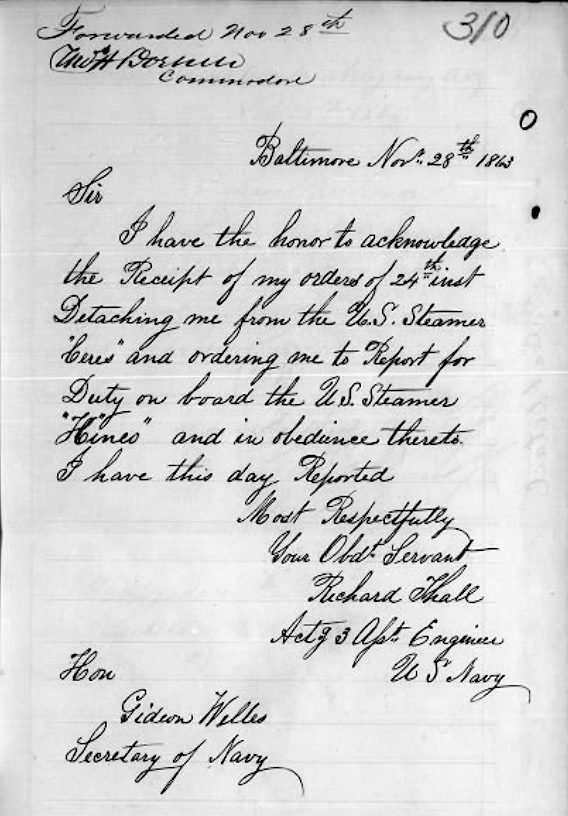

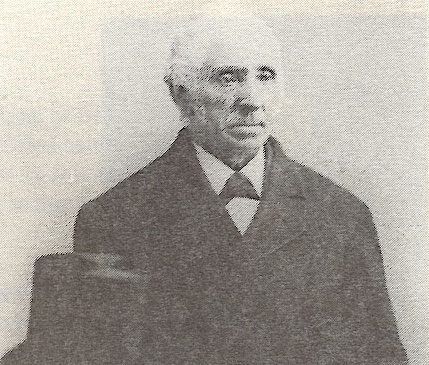
THATFORD, JOSEPH (1840-1914). Private, 84th New York (14th Brooklyn) Infantry, Company D. Before the Civil War, Thatford owned a planing mill in Brooklyn. He enlisted and mustered into the 14th on December 4, 1861, at Brooklyn. Wounded in the leg at the Battle of Antietam, Maryland, he was treated at Caspan’s Hospital. His service also included a period during which he was taken prisoner, then paroled. After being paroled, he deserted from the parole camp in West Chester, Pennsylvania, on September 10, 1863. He likely was the brother of Stephen Thatford (see) who served in the same regiment and company. Section 92, lot 4176.
THATFORD, STEPHEN H. (1839-1862). Private, 84th New York (14th Brooklyn) Infantry, Company D. Thatford was a first baseman on the Vigilant baseball team. As per an article in the Brooklyn Daily Eagle on August 22, 1860, the Second Nine of the Vigilants of Brooklyn hosted the Good Intent of New Utrecht at their home field at Third Avenue between 11th and 12th Streets. Thatford was mentioned for his fine execution at first base and for his humorous jokes; the Vigilants won the game 32-9.
During the Civil War, Thatford enlisted at Brooklyn on May 18, 1861, and mustered into the 14th Brooklyn five days later. He continued his interest in baseball and played with his company’s team while on active duty. An undated article on a match game between Companies D and E at an encampment noted that Thatford played first base for Company D; his team won 39-17 to the cheers of spectators. The Brooklyn Daily Eagle published a long letter from Thatford on June 6, 1861, from Camp Wool in Arlington Heights, Virginia, near Washington, D.C., excerpted below. The introductory paragraph describes his church experience:
…I have just come from church. We go to church here in a different manner than you do in Gowanus. We all fall into line and march off into the woods, where we form a hollow square and with no roof but the trees. Our chaplain being in the centre, he requested all who were used to singing to step out and form a sort of choir; H. W., J. H. Y. and myself by request of our Captain did so, and joined in the singing: they sang America with earnest voices, and it fairly made the woods ring….
Thatford went on to describe the inspections of the regiment’s knapsacks, tents and muskets with a follow-up inventory of the effects of each man; he looked forward to getting a new musket and keeping it clean. He then described his feelings as a nearby encampment received its marching orders:
There has been a Connecticut regiment encamped a short distance from ours since we have been here, but they had orders to march about one o’clock yesterday morning, and I happened to be awake and heard them go off—their band playing national airs, the boys shouting and seeming in great glee at the pleasure of marching somewhere. Their destination is a secret, but it is supposed they will march into Virginia. We expect to march shortly, as we have orders to keep everything right for marching the moment the alarm is sounded, which is “three guns and the bells ringing in the city.” Don’t I wish we could hear the alarm to-night and were to march to the seat of war and have it out. This is a delightful place where I am writing—lying flat on the grass under a broad cedar tree, on a hill, with the cool fresh breeze blowing gently from the southwest. W. is alongside me, writing to his lady love I presume; H. W. is in the tent asleep, having been on guard all night, and Johnny is down by a spring washing and getting some water for our dinner. No chickens or strawberries for dinner to-day,–nothing but beans and pork, and I am under the impression we will have some potatoes, as ten barrels of them were rolled in day before yesterday. That’s good living, ain’t it? I am getting so fat that I grow lazy….
Thatford goes on to describe his daily routine, the detail guard, serenading of officers and the distribution of rations, in this case, potatoes, in which each tent elects a captain, from its non-commissioned officers, to be in charge. He concludes his letter with his hope for the future:
Our captain of the mess is lord of all, and we are just as much bound to do as he says as we are to obey our real officers, H. W. (the tent captain) appoints two of the mess to cook, two to bring water, two to clean the tent, and two to wash the dishes. Last week W. and I had to keep the tent clean, air the straw, make the beds, take in the muskets every night, and do all the little chores in the tent. This week we bring water from the spring, which is half a mile from our tent. We go for water on average about 4 times a day; we need not go so often, but it is awful hot here that the water gets warm before we get back. Fresh out of the spring, it is delightful. Our cooking utensils don’t amount to much; the only thing we have to cook with is a sheet iron pot; in it we make our coffee, roast, boil, fry or broil our meat, and boil our potatoes, beans, rice, & etc. We had a frying pan which we found, but it broke; as soon as we can we will buy in the city a coffee mill, coffee pot and frying pan. With these useful articles we can manage very well. By and by the apples and pears and other fruit will be ripe around here, and then I expect we will live like “fighting cocks.” I was talking to our captain last night, and asked him if he thought that there was a chance or probability of us spending our 4th of July down here; he answered, decidedly, No! that we would be home before then, if we ever returned at all, and then he smiled and turned to go away, and just as he stepped off he said, “I am afraid that many of us will never see another 4th of July”; so I should infer by his language and the way they are fitting us out in such complete order, the drill practice we have had lately and the inspections we undergo, that we may expect either a hard battle or peace before this month is over. As far as I am personally concerned, I pray and hope we may give the secessionists a real good thrashing before peace is declared—wipe out about 50,000 of them, and the rest will beg for peace on my terms.
On August 30, 1861, the Brooklyn Daily Eagle published another of Thatford’s letters from Camp Wool written on August 27. That letter described the review of the 14th and other regiments by President Abraham Lincoln and members of his cabinet. Thatford noted that the 14th held their position to the right of the line among the 6,000-7,000 men who were assembled in a grand display. He said:
We all had on our new red caps, new jackets and fronts, with our blue pants all brushed up and hair smooth and belts blacked and I’ll bet we did look grand too. We had a very short dress parade shortly after we returned from inspection, and our Lieut. Col. told us that the Judges said we were the best drilled and finest and healthiest looking set of men on the ground, and was very proud of us. The only fault in our regiment was there was not enough of us, we only had 362 privates out and we should have had at least 800.
Thatford went on to say that the men were subsequently inspected by brevet Brigadier General Keyes who complimented the regiment for their good and healthy appearance and promised to to try to get the men new rifles to replace their old muskets. Thatford noted that the troop was well fed on potatoes and corn and some men tore down a tree to get the honey from a large bee-hive there, although the men did suffer the stings from the bees. The men kept busy playing checkers.
Mortally wounded at the Battle of Second Bull Run, Virginia, on August 29, 1862, Thatford succumbed to his injuries on September 2, 1862, at the Armory Square Hospital in Washington, D.C. The Grand Army of the Republic (G.A.R.) Post #3 was named in his honor. He likely was the brother of Joseph Thatford (see). Section 92, lot 4176.
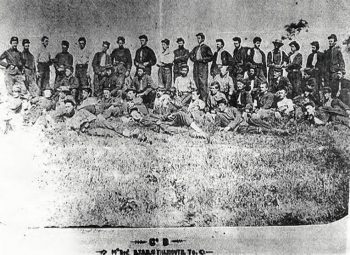
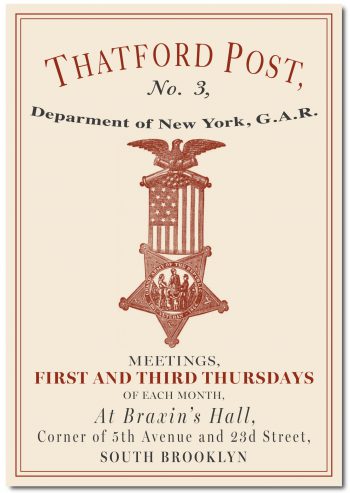

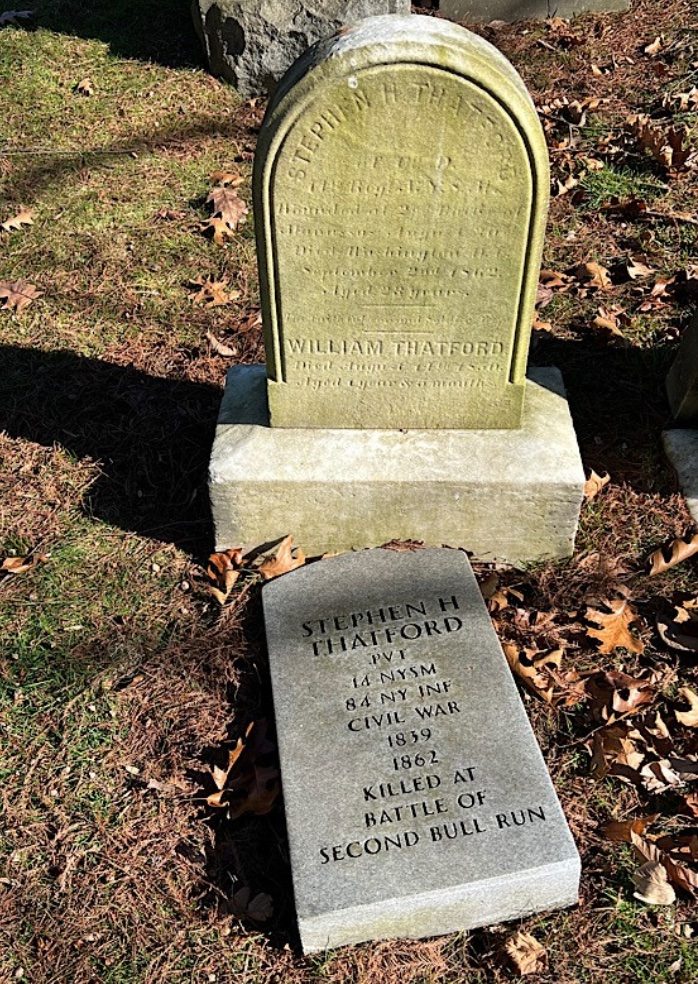
THOM, DAVID (enlisted as JAMES KNIGHT) (1847-1933). Private, 6th New York Infantry, Company I; 33rd New Jersey Infantry, Company D. A native of Angus, Scotland, he was 5′ 4″ tall with brown eyes. Enlisting in May 1861 as James Knight, the name that appears in his soldier history and pension record, he served in Company I of the 6th New York. He re-enlisted as a private on August 29, 1863, mustered into Company D of the 33rd New Jersey on September 4 and mustered out on July 17, 1865, at Washington, D.C. Based on information supplied by a descendant, and a photograph of him, he may have also served in the 79th New York Infantry (the Highlanders).
Thom was active in veterans’ affairs after the War, attending many reunions. In 1892, he applied for a pension that was granted, certificate 889,609. As per his death certificate, he worked for United States Customs before his retirement. His real name, David Thom, was recently carved on his gravestone. A widower, he last resided at 1455 East 13th Street in Brooklyn. He succumbed to heart disease. His wife, Ellinor Hamilton Thom, who is interred with him, died in 1918; only one of their three children survived him, the two who are interred with their parents, died as youngsters. Section 191, lot 23303, grave 2.
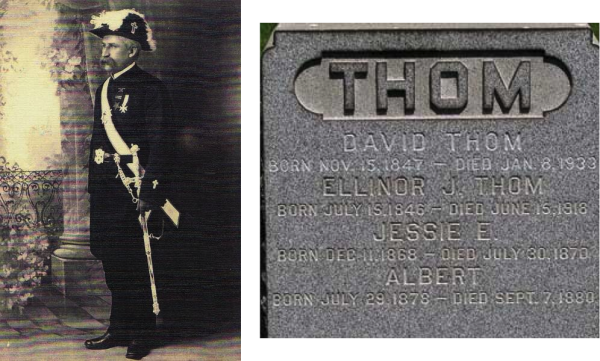
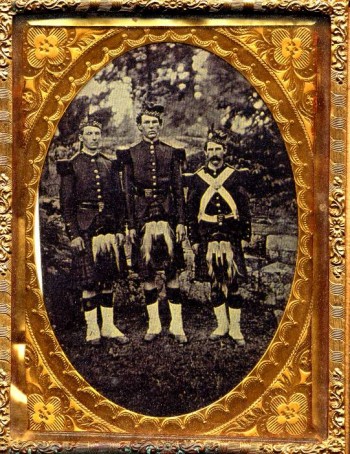
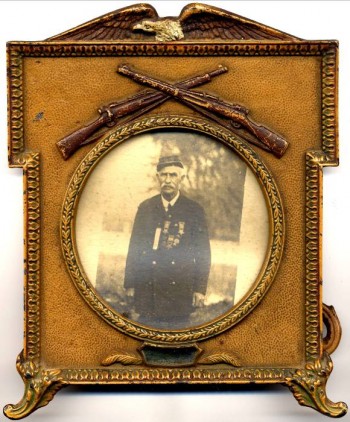
THOMAS, ALBERT H. (1840-1910). Corporal, 30th New York Light Artillery; private, 5th Regiment, New York State Militia, Company A; 32nd New York Light Artillery. Thomas first served as a private in the 5th New York State Militia, enlisting on May 16, 1861, mustering into his company that day, and mustering out on August 7, 1861, at New York City. On August 20, 1861, he enlisted as a private and immediately mustered into the 32nd Light Artillery (company not stated) at New York City. On October 25, 1864, he transferred into the 30th Light Artillery (company unknown), was promoted to corporal on November 1, 1864, and mustered out on June 23, 1865, at New York City. He also served in the 31st New York Light Artillery but the dates of that service are not specified. Bertha Thomas, who is interred with him, applied for and received a widow’s pension in 1910, certificate 714,004. Section 128-129, lot 33663.
THOMAS, AUGUST (or AUGUSTUS) L. (1831-1883). Lieutenant colonel, 2nd Regiment, United States Infantry; first lieutenant and acting brigade quartermaster, 5th New York Infantry, Company I. Thomas was born in Louisiana. After enlisting as a private at Baltimore, Maryland, on September 26, 1861, he mustered into Company I that same day and immediately detailed to the Quartermaster Office. He was soon promoted to quartermaster sergeant on October 6 and to acting regimental quartermaster on February 28, 1862. Subsequently, he was promoted to first lieutenant and quartermaster on March 1, 1862, then to acting brigade quartermaster in July 1862. He mustered out of the 5th to accept a promotion to captain and assistant quartermaster of the United States Infantry on November 25, 1862.
On February 1, 1863, Thomas applied for a fifteen day leave to attend to regimental property in Baltimore and to visit his family. In his new position with the 2nd U.S. Regiment, he was attached to the staff of Major General Gouverneur Warren, promoted to major and quartermaster on August 2, 1864, and lieutenant colonel on November 3, 1864. He resigned on October 3, 1865.
In 1880, Thomas was living at 116 Clinton Place in New York City and working as a lawyer’s clerk. At that time, he was married to a 22-year-old woman named Eliza. The New York Directory for 1880 lists him as a lawyer at 17 Macdougal Street. He last lived at 14 James Street in Manhattan. His death was attributed to phthisis. In 1920, Eliza Thomas, likely his wife, was interred with him. Section 67, lot 13899.
THOMAS, AUGUSTINE (1839-1877). Private, 6th New York Light Artillery. Originally from Ireland, Thomas enlisted at New York City on September 18, 1861, as a private. The same day, he mustered into an unknown battery of the 6th New York Light Artillery from which he deserted on December 17, 1861, at Washington, D.C. Section 15, lot 17263, grave 1296.

THOMAS, AUGUSTUS H. (1842-1875). First lieutenant, 53rd New York Infantry, Company K; private, 71st Regiment, New York State National Guard, Company F. Thomas, a native New Yorker, first served for three months with the 71st Regiment in 1861. He re-enlisted on October 21, 1861, at New York City, and on November 13, mustered into Company K of the 53rd New York. He was commissioned first lieutenant on January 1, 1862, with rank from November 13, and mustered out at Annapolis, Maryland, on March 13, 1862. Thomas last lived in Trenton, New Jersey. Mary Thomas applied for and received a widow’s pension, certificate 415,207. Section 162, lot 15346.
THOMAS, DAVID ANDERSON (1847-1880). Private, 5th Massachusetts Infantry. According to his obituary in the New York Herald, Thomas’s father was a steamer pilot whose ship, the Marion, traveled from Sandy Hook to Charleston, South Carolina. When his vessel was seized upon South Carolina’s secession, he and the other officers were offered the choice of joining the rebel army or returning home; they chose the latter option. David A. Thomas ran away from home at age 15 and enlisted in the 5th Massachusetts. He engaged in 13 battles including the First Battle of Bull Run, Virginia, and was discharged as a minor after 22 months of service. He later followed in the footsteps of his father and became a steamer pilot at Sandy Hook where he was at the helm of the Hamilton Fish. His last residence was 220 Walworth Street in Brooklyn. Section 21, lot 7941.
THOMAS, EDWARD (1838-1891). Private, 79th New York Infantry, Company I. Thomas was born in the West Indies. During the Civil War, he enlisted as a private on May 13, 1861, mustered into Company I of the 79th New York on May 27, and was discharged on July 20, 1862.
On July 10, 1884, Thomas mustered into the Frank Head Post #16 of the G.A.R.; at that time, he lived in Brooklyn and worked as a clerk. His application for an invalid pension was approved in 1888, certificate 437,782. His last address was 244 Atlantic Avenue in Brooklyn. Thomas’s death was attributed to gastritis. His wife applied for and received a widow’s pension, certificate 361,448.Section 133, lot 3139, grave 412.
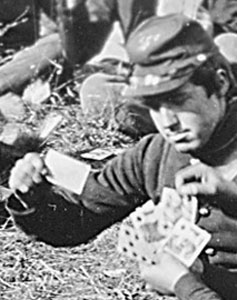
THOMAS, GEORGE W. (1845-1920). First sergeant, 170th New York Infantry, Company B. After enlisting as a private at age seventeen on October 7, 1862, Thomas, a native of New York City, mustered into Company B of the 170th New York. He received promotions to corporal on April 15, 1864, then became a sergeant on March 25, 1865, and a first sergeant on July 5, 1865. He mustered out ten days later at Washington, D.C.
In 1879, Thomas’s application for an invalid pension was approved, certificate 559,433. As per his obituary in the Brooklyn Standard Union, which confirms his service in the 170th New York, funeral services were scheduled at the Ulysses S. Grant Post #327 of the G.A.R.; comrades were requested to attend in uniform for the G.A.R. ritual. He last lived at 51 Clark Street in Brooklyn. Section 166, lot 27346.
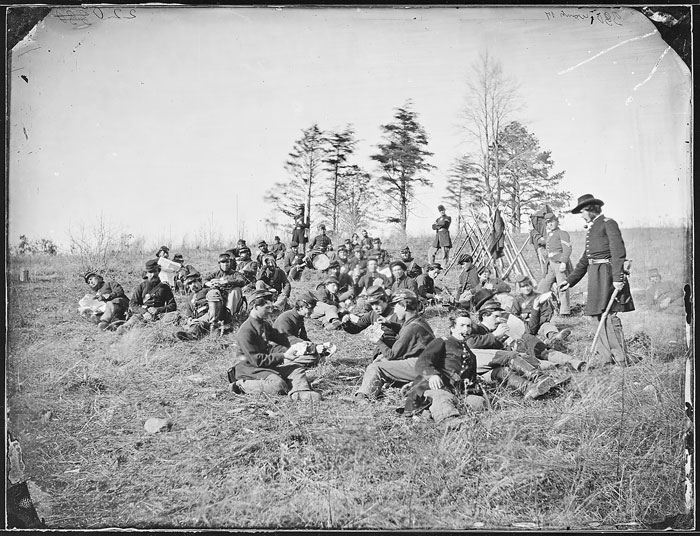
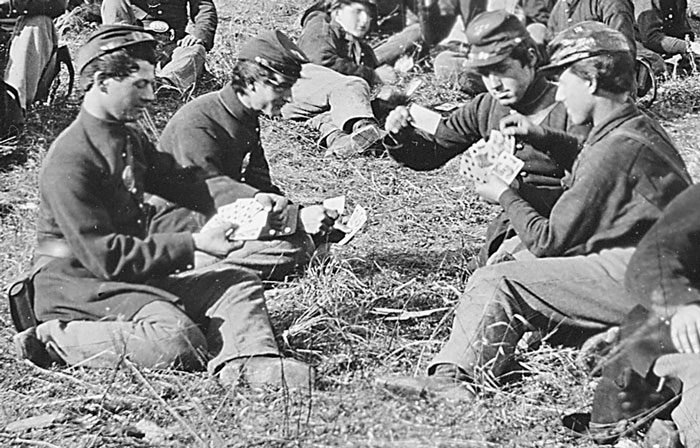
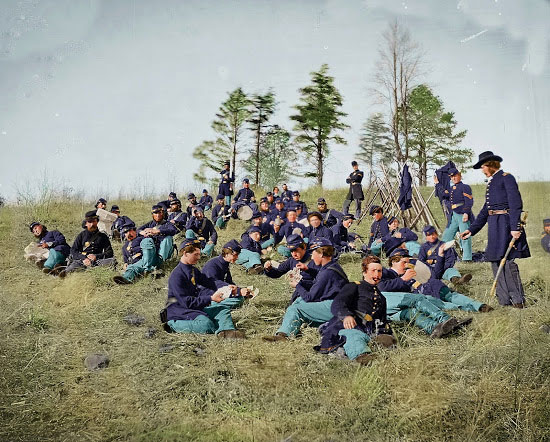
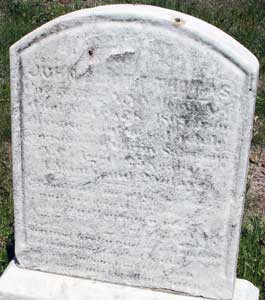
THOMAS, JOHN E. (1840-1865). Private, 5th New York Heavy Artillery, Company H. After enlisting at New York City on August 28, 1862, Thomas, a Brooklynite by birth, immediately mustered into the 5th New York Heavy Artillery. On October 19, 1864, he was taken as a prisoner of war at Cedar Creek, Virginia, and paroled on an unspecified date. He died of disease (debility and hemorrhagica) on March 28, 1865, in Brooklyn, where he lived at 227 Fulton Street. A marble Veterans Administration stone was ordered for him early in the 20th century. Section 115, lot 13536 (Soldiers’ Lot), grave 101.
THOMAS, JONATHAN M. (1842-1862). Private, 84th New York (14th Brooklyn) Infantry, Company C. A native of Wales, Thomas enlisted as a private at Brooklyn on September 18, 1861, and mustered into the 14th Brooklyn six days later. After being wounded at the Battle of Antietam, Maryland, on September 17, 1862, he succumbed the next month on October 10 at Snaketown, Maryland. Section 133, lot 3611, grave 323.
THOMAS, JOSEPH D. (1841-1889). Second lieutenant, 9th Pennsylvania Cavalry, Companies M and K. A native of Bellefonte, Pennsylvania, he was a manufacturer of glassware at the onset of the Civil War. As per his obituary in the New York Herald, he closed his business to join the Union cause. Thomas enlisted as a private on September 18, 1861, and mustered into Company M of the 9th Pennsylvania Cavalry. On August 26, 1864, he was promoted to second lieutenant and transferred intra-regimentally to Company K. During his service, he participated in Sherman’s March to the Sea and was on the staff of General Judson Kilpatrick. He was discharged from military service on May 22, 1865.
According to his obituary in The New York Times, Thomas was a prominent merchant in Middletown, New Jersey, and was at one time its postmaster, appointed by President Hayes. In 1883, he applied for an invalid pension, application 481,548, but there is no certificate number. Thomas last lived in Middletown but died in Bellefonte where he was at the home of his parents hoping to restore his health. Caroline Thomas, applied for a widow’s pension in 1890, application 491,271, but there is no certificate number. Section 73, lot 816.
THOMAS, THOMAS (1817-1878). Private, 90th New York Infantry, Companies G, I, and K; Veteran Reserve Corps. Born in England, Thomas enlisted as a private at Brooklyn at the age of 44 on October 4, 1862, and mustered into Company G of the 90th New York on November 21. On November 26, 1862, he transferred to Company I and on April 7, 1863, to Company K. On March 15, 1864, he transferred into the Veteran Reserve Corps from which he was discharged. Thomas last resided at 3 13th Street, Brooklyn. Section 133, lot 3611, grave 323.
THOMAS, WILLIAM A. (1842-1866). Private, 61st New York Infantry, Companies I, F, and H. He enlisted at New York City on October 28, 1861, mustered into Company I of the 61st New York November 6, and was discharged for disability on November 24, 1862, at Falmouth, Virginia. He also served in Companies F and H of his regiment. He died from diphtheria at his residence in New York City. Section 110, lot 10455.
THOMPSON, EDWARD (1841-1862). Private, 82nd New York Infantry, Company E. A native of Ireland, he enlisted as a private on April 19, 1861, at New York City. On May 21 of that year, he mustered into the 82nd New York and died on January 27, 1862, at Poolesville, Maryland, of typhus fever. He was interred at Green-Wood on January 31. Section B, lot 9895, grave 494.
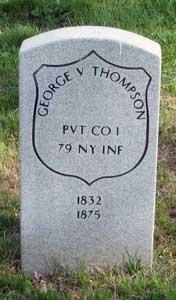
THOMPSON, GEORGE V. (1832-1875). Private, 79th New York Infantry, Company I. After enlisting at New York City as a private on May 13, 1861, Thompson mustered into the 79th on May 28, and was discharged for disability on February 17, 1863, at Washington, D.C. As per the Brooklyn Directory of 1868, he was a teacher. He last lived at 24 South Oxford Street in Brooklyn. Records indicate that he died of Bright’s disease. In 1903, Margaret Pitbladdo, guardian, applied for and received a pension for his minor child, certificate 563,352. Section 33, lot 4230.

THOMPSON, JAMES (1827-1885). Private, 67th New York Infantry, Companies A and B. Of Scottish birth, he enlisted as a private at Brooklyn on June 13, 1864, mustered into Company A of the 67th New York that day, was transferred to Company B on July 4, and deserted on July 25, 1864. Thompson last resided at 226 Park Avenue in Hoboken, New Jersey. His death was caused by typhoid fever. Section 191, lot 23247.
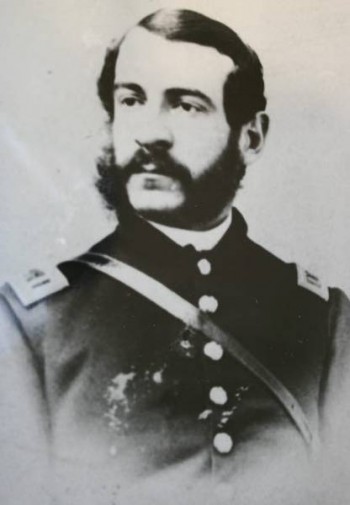
THOMPSON, JOHN C. (1838-1888). Commissary, 22nd Regiment, New York State National Guard, Company A. A native of New York City, he enlisted there as a private on May 28, 1862, and mustered into Company A of the 22nd New York that day. He was appointed to commissary sergeant on July 1, and mustered out on September 5 at New York City after serving three months. When his regiment was reactivated the next year for 30 days, he mustered into the Field and Staff of the 22nd on June 18, 1863, was promoted to commissary that day, and mustered out on July 24 at New York City. He last lived at 70 Columbia Heights in Brooklyn. His death was caused by apoplexy. Section 151, lot 17239.
THOMPSON, JOHN H. (1845-1890). Corporal, 4th New York Heavy Artillery, Battery E. Thompson, a New York City native, enlisted there as a private on December 26, 1863, and mustered into the 4th New York Heavy Artillery on that date. On May 1, 1865, he was promoted to corporal and mustered out on September 26, 1865, at Washington, D.C. His last residence was 100 Varick Street in Manhattan. His death was attributed to alcoholism. His widow, Mary Thompson, who is interred with him, applied for and received a pension in 1894, certificate 291,764. Section 206, lot 21347, grave 622.
THOMPSON, JOHN HANSON (1842-1863). Sergeant, 106th New York Infantry, Company A. Originally from Connecticut, he enlisted as a sergeant at New Creek, Virginia, on September 18, 1862, mustered into the 106th New York on November 18, and died from consumption on March 16, 1863, at North Mountain, West Virginia. According to his descendant, he was a brother of Joseph P. Thompson (see). Section 41, lot 4571.
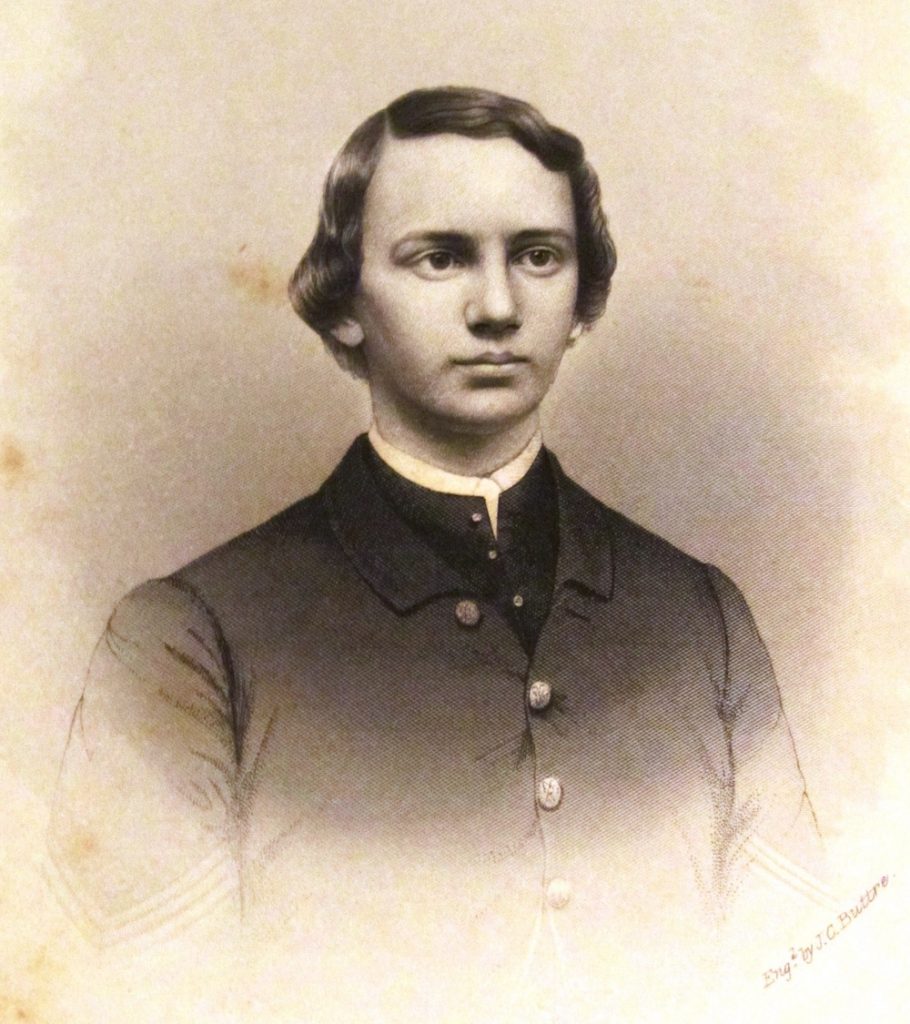
THOMPSON (or TOMPSON), JOHN HOFFMAN (1844-1910). Private, 5th New York Infantry, Company H; 146th New York Infantry, Company I. Thompson entered service at age 17, claiming to be 18. A jeweler by trade, he was 5′ ½” tall with blue eyes and dark hair. He enlisted as a private at New York City on August 6, 1862, mustered into the 5th that day, and transferred into the 146th New York on May 4, 1863. When granted a furlough to return to New York City, he overstayed his leave and spent his time recruiting for the 5th New York Veterans. He was ordered back to the 146th by Colonel Winslow (see), returned on September 27, 1863, forfeited five days pay for AWOL, and mustered out on June 3, 1865, at Alexandria, Virginia. In 1891, he applied for and received an invalid pension, certificate 821,317. As per his pension record, he was a member of Lincoln Post #11 of the G.A.R. in New Jersey. His last residence was in East Orange, New Jersey. Section 55, lot 9366.
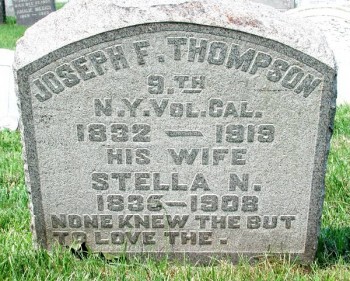
THOMPSON, JOSEPH F. (1832-1919). Saddler, 9th New York Cavalry, Company B. After enlisting on September 28, 1861, he mustered into the 9th New York Cavalry as a saddler on October 8, and mustered out on April 9, 1862, at Washington, D.C., by reason of disaffection. Section 126, lot 16874.
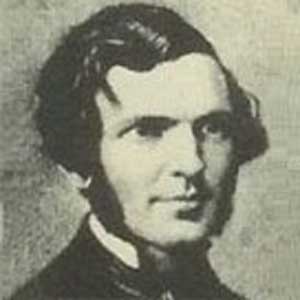
THOMPSON, JR., JOSEPH PARRISH (1844-1897). Captain, 2nd Infantry, United States Colored Troops, Companies F and A. A native of Connecticut, Thompson enlisted as a lieutenant and was commissioned into Company F of the 2nd Infantry, United States Colored Troops (USCT), on an unknown date. He was promoted to captain of Company A of the same regiment at some point. Further details about his service are unknown but the regiment was stationed in Florida. His name appears at the African American Civil War Memorial in Washington, D.C., plaque A-6. According to his descendant, he was a brother of John Hanson Thompson (see). His last residence was 20 Prospect Terrace in East Orange, New Jersey. Section 77, lot 2712, graves 5 and 6.
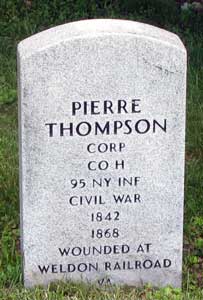
THOMPSON, PIERRE (1842-1868). Corporal, 95th New York Infantry, Company H. Born in Canada, Thompson enlisted as a private at New York City on January 4, 1862, mustered immediately into the 95th New York, and was promoted to corporal on October 27, 1863. He re-enlisted on January 26, 1864, was wounded at Weldon Railroad, Virginia, on August 21, 1864, and was discharged for disability on March 14, 1865, at Fort Schuyler, New York Harbor. The Brooklyn Directory for 1868 reports that he was a clerk. His last residence was 532 Atlantic Avenue in Brooklyn. He succumbed to phthisis. Section 189, lot 17876.
THOMPSON, ROBERT B. (1837-1885). Private, 62nd New York Infantry, Thompson, who was born in New York City, enlisted there as a private on July 27, 1861, mustered into the 62nd New York on August 15, and deserted his unit on October 20, 1862, at Hancock, Maryland. He last lived at 286 Baltic Street in Brooklyn. Section 167, lot 16306.
THOMPSON, THOMAS (1842-1902). Private, 11th New York Infantry, Companies I and A; 173rd New York Infantry, Company D. A native of Ireland, Thompson enlisted as a private at New York City on April 20, 1861, and mustered into Company A of the 11th New York on May 7. According to a descendant, he was wounded at the Battle of First Bull Run, Virginia. He was transferred at some point to Company I before his discharge on October 5, 1861. He applied for an invalid pension on December 26, 1861, but there is no certification number. Thompson re-enlisted as a private at Brooklyn on September 4, 1862, and mustered into Company D of the 173rd New York on October 30. His muster roll reports that he was a brush maker by trade who was 5′ 6″ tall with grey eyes, dark hair and a dark complexion. As per his muster roll, he deserted from a ship in New York Harbor on December 19, 1862.
The 1880 census indicates that he was a brush maker. Thompson, who died from nephritis, last lived at 166 Livingston Street in Brooklyn. Mary J. Thompson applied for and received a widow’s pension in 1903, certificate 581,900. Section 2, lot 5499, grave 1607.
THOMPSON, WILLIAM H. (1836-1915). Sergeant, 29th New Jersey Infantry, Company E. A New Jersey native, Thompson enlisted as a sergeant on September 3, 1862, mustered into the 29th New Jersey on September 20, and mustered out on July 6, 1863, at Freehold, New Jersey. In 1892, his application for an invalid pension was approved, certificate 840,066. His death certificate states that he was a retired carriage-maker. He last lived at 64 North Oxford Street in Brooklyn. Shortly after his death from apoplexy in 1915, his wife applied for and was granted a widow’s pension, certificate 799,602. Section 126, lot 34656, grave 2.
THOMSON (or THOMPSON), ALEXANDER (1842-1924). Private, 4th New York Cavalry, Company M. Originally from Scotland, Thompson enlisted as a private on February 26, 1863, and mustered into the 4th New York Cavalry. He deserted from the Ladies’ Home and St. Joseph’s Hospital in New York City on August 7, 1863. His last residence was 104 North 22nd Street in Ampere, New Jersey. Section 148, lot 21814, grave 2.
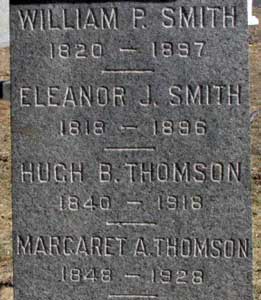
THOMSON, HUGH B. (1840-1918). Sergeant, 2nd New York Heavy Artillery, Company F. Born in Paisley, Scotland, Thomson enlisted at New York City as a private on October 1, 1861, and mustered into the 2nd New York Heavy Artillery the next day. He was promoted to corporal on an unknown date and to sergeant on August 1, 1863. He was reduced to the rank of private on February 9, 1864, and mustered out on October 1 at Petersburg, Virginia.
In 1892, Thomson applied for and received a pension, certificate 1,095,109. As per his obituary in the New York Herald, he was a member of Veteran Company C of the 7th New York State National Guard; his comrades were requested to attend his funeral. He last resided at 2340 Seventh Avenue, Manhattan. Margaret A. Thomson, who is interred with him, applied for and received a widow’s pension in 1918, certificate 861,455. Section 64, lot 9075, grave 2.
THOMSON (or THOMPSON), WALTER H. (1842-1884). Private, 57th New York Infantry, Company A. Born in Brooklyn, Thomson enlisted at New York City as a private on October 17, 1861, and mustered into the 57th New York the next day. On October 31, 1862, he deserted at New York City. His last residence was 364 5th Street, Brooklyn. Section 11, lot 4822.
THORN, EUGENE (1831-1876). Captain, 71st Regiment, New York State Militia, Company F. A native of France, he enlisted as a corporal at New York City on April 19, 1861, and mustered into Company F of the 71st Regiment on May 3. He was promoted to second lieutenant on June 1, 1861, and mustered out on July 31. When the unit was reactivated the following year and part of the New York State National Guard, Thorn re-enlisted on May 28, 1862, and was commissioned into the same company with a promotion to captain. He mustered out after three months at New York City on September 2. He last resided in New York City. The cause of his death was cerebral apoplexy. Section 103, lot 7180.

THORNE, JR., RICHARD V. W. (1821-1875). Captain, 13th Regiment, New York State Militia, Company G. Thorne was active in military affairs before the Civil War. In 1859, the men of this regiment awarded him with a Presentation Grade 1850 Foot Officer Sword and Scabbard. It bears the inscription, “Presented by the Brooklyn City Guard to Capt. R.V.W. Thorne, Jr., 1859.” Enlisting as a captain on April 23, 1861, at Brooklyn, he was commissioned into Company D of the 13th New York State Militia on May 14, and mustered out on August 6 at Brooklyn. On May 28, 1862, he was again commissioned into the same regiment and company and mustered out after three months on September 12 at Brooklyn. His last residence was 24 South Portland Avenue in Brooklyn. Section 187, lot 21943.
THORNELL, GEORGE (1843-1867). Landsman, United States Navy. Irish-born and a cooper by trade, he became a naturalized citizen on October 20, 1864. A month later, he enlisted as a landsman and mustered immediately into the United States Navy on November 28, 1864. He served on board the USS Kansas for the duration of the Civil War. Thornell was discharged from military service on November 26, 1866. His last residence was 106 Sackett Street in Brooklyn. Section 114, lot 8999, grave 436.
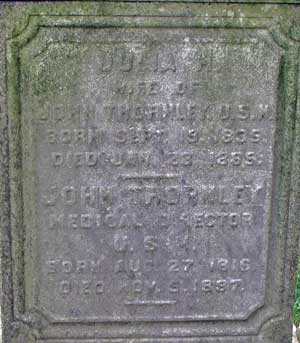
THORNLEY, JOHN (1816-1887). Medical director, United States Navy. Born in Virginia, Thornley joined the Navy as an assistant surgeon on October 13, 1840. He served as a Navy surgeon from 1855-1861, and retired from that position on June 1, 1861. He later served as a medical director and retired on March 3, 1871. He last lived in Charlottesville, Virginia, where he succumbed to cancer. Section 170, lot 12848.
THORNTON, ABRAHAM (or ABRAM) S. (1823-1875). Teamster, 93rd New York Infantry, Company D. He enlisted as a private on February 14, 1862, at Albany, New York, and mustered into Company D of the 93rd New York on that day. He re-enlisted on February 17, 1864, and mustered out on June 29, 1865, at Washington, D.C. At some point in his service, he was promoted to teamster. He last lived at 865 Third Avenue in Manhattan. Section 15, lot 17263, grave 229.

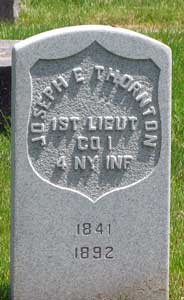
THORNTON, JOSEPH E. (1841-1892). First lieutenant, 4th New York Infantry, Companies B and I. Thornton, who was born in Norwalk, Connecticut, enlisted at New York City as a second lieutenant on April 22, 1861. On May 9, he was commissioned into Company B of the 4th New York. He was promoted to first lieutenant effective upon his transfer to Company I on December 18, 1861, and resigned his commission on May 9, 1862. Thornton’s death was attributed to a pistol shot wound. His last residence was 430 East 86th Street in Manhattan. His wife, Sarah Thornton, who is interred with him, applied for and received a widow’s pension in 1895, certificate 433,979. Section 135, lot 27263, grave 964.
THORNTON, WILLIAM CHARLES BROWNLEE ((1836-1904). Second lieutenant, 164th New York Infantry, Companies G and E. William was born in Brooklyn to John and Hannah Corkendale Thornton. As per the 1850 census, William (listed as Charles) attended school and was living in Brooklyn with his parents and three older and three younger siblings; John Smither, relationship unknown, also lived in the household. The 1855 New York State census, which also reports his name as Charles, documents that he lived in Brooklyn with his parents, two older sisters, a younger sister and two younger brothers.
During the Civil War, he enlisted as a private at Brooklyn on August 25, 1862, and mustered into Company G of the 164th New York Infantry on November 19. His name appears as W. Charles B. Thornton on soldier records. Initially promoted to first sergeant, Thornton was promoted to second lieutenant on November 11, 1863, effective upon his transfer to Company E. His muster roll indicates that he was borne as William Thornton at the time of his promotions and transfer. He was wounded at Petersburg, Virginia, on June 16, 1864, and discharged for wounds on October 14, 1864. On April 5, 1865, he applied for and received an invalid pension, certificate 422,462.
He married Charlotte Agnes Barton on March 2, 1865 in Granby. Massachusetts; on that record, his name was recorded as W. Charles Thornton. His online ancestry.com family tree documents that Charlotte and two toddler children, Gertrude (born 1868) and Grace (born 1869) died in 1870. Gertrude’s birth was recorded in New York Birth Index: she was born in Brooklyn and William is identified as a lawyer.
According to the 1870 census, Thornton was a lawyer living in Brooklyn with the Craft family (relationship unknown). In November 1874, Chas. B. Thornton was a Democratic Party candidate for the New York State Assembly; he appealed to voters for their support in the Brooklyn Daily Eagle. The 1875 New York State census documents that he was living in Brooklyn with his parents, older sister, Elmira, and three others. The 1877 New York City Directory, which identifies him as W. Charles B. Thornton, reports that he was a lawyer st 8 Cumberland Street in Brooklyn. At the time of the 1880 census, he was living at 85 Cumberland Street in Brooklyn with his mother, identified as Ella, now 77, and sister, Elmira, and was working as a lawyer. On August 23, 1883, the Buffalo Weekly Express reported that Thornton, a prominent Brooklyn lawyer, was arrested and charged with appropriating $2,700 belonging to a client. The resolution of that case is unknown.
The New York State census of 1892 shows Thornton living in Brooklyn. As per the 1900 census, Thornton lived in a rental at 692 Hancock Street in Brooklyn with his wife Lois; they had been married three years. He is still listed as a lawyer. He last lived at 229 Hancock Street in Brooklyn. His death was attributed to bronchitis. Thornton was survived by his wife. Section 176, lot 19233, grave 7.
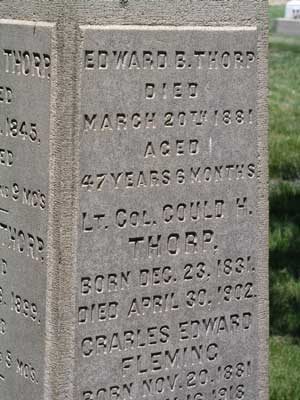
THORP, GOULD H. (1832-1902). Captain, 165th New York Infantry, Company F; 7th Regiment, New York State Militia, Company F. Thorp enlisted as a first lieutenant on September 6, 1862, at New York City, having previously served with Company F of the 7th Regiment in 1861. On September 18, he was promoted to captain and was commissioned into the 165th New York. In Louisiana, he fought at the Battle of Pentachoula (also known as Clinton Crossroads and where he was mentioned in orders for his gallant conduct while conducting skirmishes), Baton Rouge, and in the New Iberia Campaign. He was wounded three times at Port Hudson, Louisiana, on May 27, 1863, hospitalized for ten months to tend to his wounds, and was discharged on March 14, 1864, as a result of his ill health.
After the War, Thorp lived in New York City. In civilian life, he was a member of the Produce Exchange, belonged to the New York Club, and was vice president of the 165th Regiment Association. His last address was 19 East 67th Street in Manhattan. He died of phthisis (tuberculosis.) Section 94, lot 1049, grave 4.
THORP, JR., THOMAS S. (1841-1867). Corporal, 23rd Regiment, New York State National Guard, Company E. Thorp was a corporal in the 23rd Regiment when it was activated for 30 days of service in 1863. After the hostilities, he was a vice president of the Brooklyn Young Men’s Christian Association. His letters from Gettysburg, Pennsylvania, were included in his funeral remembrance book. He recalled breaking camp on the way to Carlisle, Pennsylvania, with sore feet and a 50 pound backpack, encountering heavy flooding that swept away two men from the 56th Regiment, and the train ride back to New York. He last lived on Washington Avenue in Brooklyn where his death was a suicide. Section 178, lot 12466.
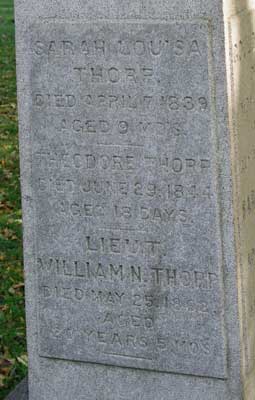
THORP, WILLIAM N. (1842-1862). First lieutenant, 40th New York Infantry, Company E. On June 14, 1861, Thorp enlisted at Yonkers, New York, and was commissioned into the 40th New York as a first lieutenant. He was discharged on September 23, 1861, but on that same day was made a second lieutenant of the same company and regiment. He was discharged on April 27, 1862, and died a month later on May 25. Section 95, lot 1049.
THOUROT, LOUIS PIERRE (1819-1891). Lieutenant colonel, 55th New York Infantry; 55th Regiment, New York State National Guard. Born in France, he enlisted at New York City on July 28, 1861, and was commissioned into the Field and Staff of the 55th New York as its lieutenant colonel on August 28. He commanded the 55th in Virginia at the Battle of Fair Oaks on May 31-June 1, 1862, and at the Seven Days Battle from June 25-July 2, 1862. Thourot was discharged on October 13, 1862. On June 24, 1863, he was commissioned into the 55th Regiment, New York State National Guard, as lieutenant colonel, and mustered out after 30 days on July 27 at New York City. He last lived in West Hoboken, New Jersey, where he died from a self-inflicted gunshot wound. Section 86, lot 2857, grave 25.

THURMAN, WASHINGTON R. (1841-1862). Private, 65th United States Colored Troops, Company A. A New Yorker by birth, he served in the 65th USCT, where privates were African-American, and then re-enlisted. He died of typhoid fever in South Carolina on May 22, 1862, and was interred in lot 4259 at Green-Wood the next month on June 19. He was re-interred on June 30, 1862. His name is displayed on the African American Civil War Memorial in Washington, D.C., plaque C-75. Section 169, lot 13580.
THURSTON, RICHARD H. (1835-1882). Rank unknown, 80th Infantry, United States Colored Troops (USCT); sergeant, 128th New York Infantry, Companies G and F. Originally from England, Thurston enlisted as a sergeant at Hudson, New York, on August 9, 1862, and mustered into Company G of the 128th New York ten days later. He was reduced to the rank of private on December 7, 1862, transferred into Company F on July 1, 1863, and discharged for promotion on January 31, 1864, the same date that he was commissioned into the 80th Infantry, USCT. The details of his service, including rank, in the 80th USCT are unknown. His soldier history indicated that he subsequently re-enlisted as a sergeant major but there is no information about that enrollment. He last lived at 1396 Second Avenue in Manhattan. Section 2, lot 8650.
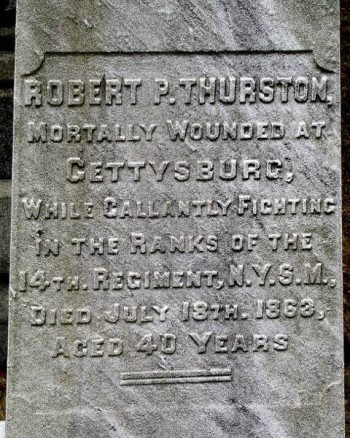
THURSTON, ROBERT P. (1823-1863). Private, 84th New York (14th Brooklyn) Infantry, Company E. After enlisting on August 28, 1862, at Brooklyn, Thurston mustered into the 14th Brooklyn on that date. He was severely wounded in the right arm on July 1, 1863, at Gettysburg, Pennsylvania, necessitating amputation. He died from his wounds on July 18. Interment at Green-Wood was on July 24, 1863. Section 11, lot 4848.
TICHENOR, EUGENE (1838-1887). Private, 131st Regiment, New York State Militia, Company C. Originally from Ithaca, New York, he enlisted as a private in 1861 and served with the 131st Regiment for its activation of 30 days. His last residence was 377 Throop Avenue in Brooklyn. In 1888, Mary Tichenor applied for and was granted a widow’s pension, certificate 263,537. Section 175, lot 21255.
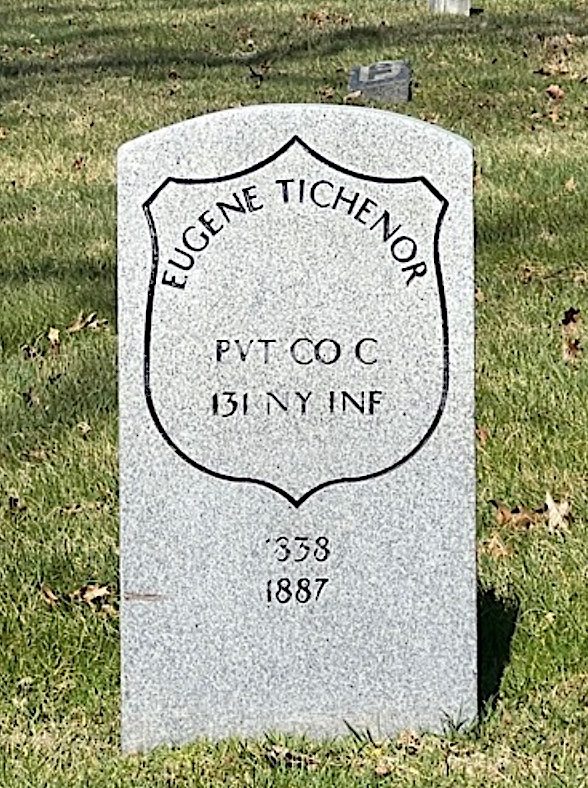
TICKNER, ALFRED P. (1838-1907). Private, 84th New York (14th Brooklyn) Infantry, Company E. He enlisted on August 21, 1862, mustered in two days later, was wounded on December 13, 1862, at Fredericksburg, Virginia, and transferred to the Veteran Reserve Corps on June 2, 1864. The New York City Directory for 1877 lists Tickner as working in the gold business. Section 13, lot 19694, grave 341.
TIEFEL, GEORGE (1832-1907). Private, 1st New York Cavalry, Company G. Tiefel was born in Germany. According to the Veterans Schedule of 1890, a census of Civil War veterans, Tiefel enlisted as a private in 1861 for three years. At the time of that census, he was living at 25 Mount Morris Avenue in Manhattan. He served in Company G of the 1st New York Cavalry.
According to the 1870 census, Tiefel was a native of Bavaria living in New York City with his wife Catherine (who is interred with him), as well as a female servant and a “butcher’s boy,” and he was working as a retail butcher. That record also reports that he was a United States citizen (he appears to have been naturalized in 1860). In the 1900 census, he is listed as living in the Bronx with his wife “Kathrin” and two servants. He died from cancer. In his will, he left his wife “Katherina” $100 (” . . . the reason I do not leave her any more is that I have heretofore amply provided for her . . . .”). He also left his wife the lots and their residence at 1077, 1079, and 1081 Post Road in the Bronx. He died a wealthy man: he left $15,000 (the equivalent of $368,000 today) to several individuals and thousands of dollars to others. Section L, lot 20237, vault.
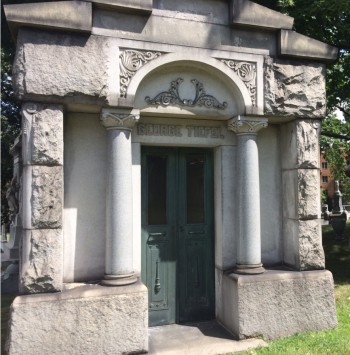
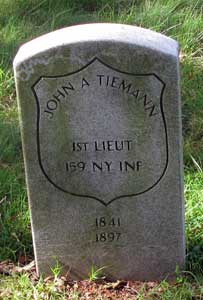
TIEMANN, JOHN A. (1841-1897). First lieutenant, 159th New York Infantry, Companies B and F. Born in New York, he enlisted as a sergeant at Brooklyn on September 17, 1862, and mustered that day into Company B of the 159th. When he was promoted to first lieutenant on August 24, 1864, he was transferred into Company F. Tiemann was discharged on January 20, 1865. He was likely a brother of Julius Tiemann (see). His last residence was 11 East 139th Street in Manhattan. Section 29, lot 10733, grave 11.
TIEMANN, JULIUS H. (1840-1906). First lieutenant, 159th New York Infantry, Company B. Born in New York City, Tiemann enlisted as a first lieutenant at Brooklyn on September 24, 1862, was commissioned into the 159th New York on November 1, and was discharged on December 24, 1863. He was likely a brother of John Tiemann (see) who also served with Company B of the 159th New York. He last lived in Brooklyn. In 1908, Margaret Tiemann, who is interred with him, applied for and received a widow’s pension, certificate 720,142. Section 29, lot 10733.
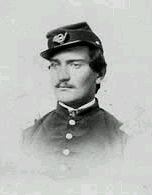
TIEMANN, WILLIAM FRANCIS (1838-1926). Captain, 159th New York Infantry, Company B. After enlisting as a private at Brooklyn on May 9, 1862, Tiemann mustered into the 159th New York and was promoted to sergeant major on November 2. He rose to second lieutenant on January 13, 1863, to first lieutenant on June 10, 1863, and became captain on February 23, 1864. On September 19, 1864, he was captured at the Battle of Winchester, Virginia, at which time he lost a light cavalry sword with a steel scabbard and a bright metal canteen.
In 1891, Tiemann wrote and published, The 159th Regiment Infantry in the War of the Rebellion 1862-1865. The text was compiled, according to his preface, primarily from letters that he sent home and contacts with the adjutant general and others for muster rolls and additional records. In one chapter, devoted to the Battle of Cedar Creek in Virginia’s Shenandoah Valley, he described the preparation for battle the morning of October 19, 1864, when the Confederate troops were already in place by 6 a.m. and shrouded in the early morning fog. The 159th was initially caught off-guard but the men were later rallied by the return of General Sheridan who met the retreating force. Tiemann wrote of him:
Dashing forward at top speed he met crowds of stragglers and demoralized troops whom he halted, and by his presence and cheering words soon infused new life and energy in the disheartened men, and with earnest resolve that his promise, ‘We shall occupy our old lines again to-night,’ should be true, the broken lines were re-formed, and with renewed vigor they marched to meet the enemy.
By that afternoon, at 3:30 p.m., the regiment was in a strong position:
The rebels in our front were in two lines, strongly posted behind a stone wall and on the crest of a hill with a battery in position. After delivering our fire a charge was ordered and the rebels were driven from the hill, our colors being the third to be planted on its crest. We captured in the charge three officers and thirty-one men of the rebels. Halting here for a short time only, we pressed forward again until at Cedar Creek we halted and finally camped in our old quarters. General Sheridan had proved himself the ‘man at a pinch’ we had thought him to be when we first saw him, and had nobly kept his glorious promise. Throughout the entire fight our regiment, with all those of our brigade, maintained its organization and moved from point to point as it was ordered.
The day was not without loss for Tiemann’s comrades, with the loss of its major, Robert McDermott Hart (see), the captain of Company K, Duncan Richmond (see), and two men. One officer and 12 men were injured and five were missing. Tiemann praised Hart, “He was a firm disciplinarian and exacted implicit obedience from his men, but no one cared more for or looked more closely to their interests than did he.” Of Richmond, Tiemann wrote, “…Pleasant and genial in his manner, kind to and thoughtful of his men, brave as the bravest, we could ill afford to lose so gallant an officer. He fell just as success was assured to our arms. None more worthy gave his life for his country.”
On October 24, President Lincoln’s congratulations were read to the troops by General Sheridan. Tiemann then described the movement of the troops to Newtown where camp was set up for winter on November 29 when log cabins were built to withstand severe conditions. After celebrating Christmas with boxes from home and saluting General Sherman’s capture of Savannah, Georgia, marching orders were received on December 29, 1864. He was discharged on October 22, 1865.
In 1892, when Tiemann was living at 196 St. John’s Place in Brooklyn, he offered a liberal reward for the return of the items he described as lost at Winchester, Virginia, in 1864. However, it appears that the reward was never claimed and he never got his captured equipment back. In 1906, he received a pension, certificate 1,135,506. He last lived at 82 North Arlington Avenue in East Orange, New Jersey. Frances Huntington Tiemann, who is interred with him, received a widow’s pension in 1926, certificate a-7-8-26. On May 14, 1938, Frances Tiemann, applied for a government-issued headstone, citing her husband’s service in the Civil War. The application noted parenthetically that he was also commissioned as major. Section 194, lot 32311.
TIFFANY, LYMAN (1838-1912). Corporal, 7th Regiment, New York State Militia, Company G. Born in New York City, Tiffany served during two activations of the 7th Regiment. He enlisted at New York City as a private and served with the 7th Regiment from April 26-June 3, 1861. A year later, he returned to the 7th as a corporal on May 25, 1862, and mustered out at New York City three months later on September 5. He joined Brooklyn’s Lafayette Post #140 of the G.A.R. in 1881, and became surgeon of the post in 1884. Tiffany resided in Washington, D.C., and lived abroad for many years but his last address was in Jamestown, Rhode Island. Section 95, lot 1017.

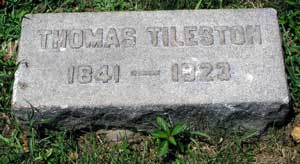
TILESTON, THOMAS (1841-1923). Captain, 131st New York Infantry, Companies A and K. Tileston enlisted as a first lieutenant at New York City on July 26, 1862, and on September 6 was commissioned into Company A of the 131st New York. On September 20, 1862, he transferred to Company K upon his promotion to captain. He took part in Grant’s siege of Vicksburg, Sherman’s March to the Sea, and Sheridan’s Battle of Cedar Creek (where he was wounded), before mustering out at Savannah, Georgia, on July 26, 1865.
A founder of the Loyal Legion, a fraternal organization of former Union officers, Tileston was also a member of the New York Stock Exchange for thirty-five years, retiring in 1903. In addition, he belonged to the Union Club. Tileston received an invalid’s pension in 1879, certificate 185,052. When he died, from chronic myocarditis, he was living at the Beechwood Hotel in Summit, New Jersey. Section 185, lot 24061.
TILFORD, GEORGE (1837-1923). Private, 71st Regiment, New York State Militia, Company D; 7th Regiment, New York State National Guard, Company D. A New York native, Tilford enlisted as private on April 29, 1861, and mustered into the 71st Regiment for its three month activation that year. As per United States Civil War Soldiers, he also served as a private for three months in the 7th Regiment in 1862.
According to the federal census of 1870 and the New York State census of 1875, Tilford lived in Brooklyn with his wife and young children and was employed as a truck driver (cartman). On June 29, 1886, he mustered into the Mansfield Post #35 of the G.A.R.; at that time, he was living in Brooklyn and working as a carman. In 1897, he application for an invalid pension was approved, certificate 958,258. The 1900 census reports that he lived at 235 South 4th Street in Brooklyn, was a truckman, and had been married for 35 years. He was a widower at the time of his death. He last lived at 895 Lafayette Avenue in Brooklyn. His death was attributed to senility. Section 12, lot 7784.
TILTON, JOHN D. (or O.) (1843-1883). Corporal, 67th New York Infantry, Company A. After Tilton enlisted as a private at Brooklyn on May 7, 1861, he mustered into Company A of the 67th New York on June 20, 1861. On August 1, 1861, he was promoted to corporal of his company. Tilton deserted on August 31, 1862, at Maryland. His death attributed to injuries, he last resided at 100 Henry Street in Brooklyn. Section 113, lot 17605.
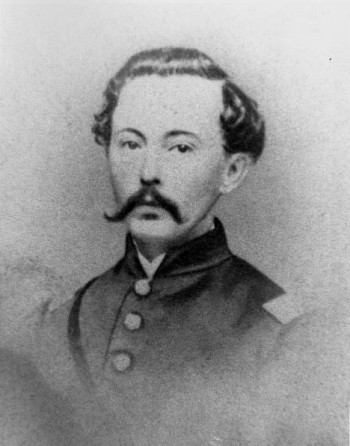
TIMOLAT, HENRY N. (1838-1864). First lieutenant, 131st New York Infantry, Company G; private, 7th Regiment, New York State Militia, Company E. A native of New York City, he enlisted in the 7th for its 1861 activation, which lasted from April 18-June 3. Timolat re-enlisted at New York City on August 30, 1862, as a first lieutenant, and mustered into the 131st on September 6. He served in Maryland, Virginia, and Louisiana where he took part in the storming of Port Hudson, and then fought at the Battle of Vicksburg, Mississippi. At the Second Battle of Winchester, Virginia, he led a charge of 18 men; only five survived. He was mortally wounded at Winchester, taking a bullet to his chest on September 19, 1864, and succumbed there eight days later. Although he suffered from rheumatism, he never asked for or accepted a furlough. His company from the 7th escorted his remains to Green-Wood. Section 80, lot 5253.
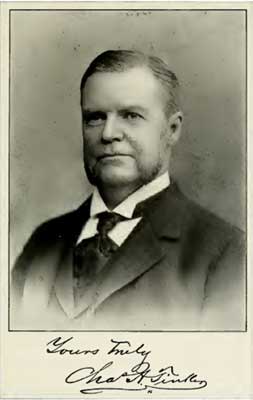
TINKER, CHARLES ALMERIN (1838-1917). Telegrapher in the War Department. A descendant of John Tinker, one of the early settlers of Windsor, Connecticut, Charles Tinker’s grandfather moved to Vermont prior to the American Revolution and was a volunteer in the defense of Bennington. Born in Chelsea, Vermont, Tinker’s family moved to Michigan when he was an infant but returned to Northfield, Vermont, in 1851. Although he studied at the Newbury Seminary, he did not complete his degree due to sickness and took a position as clerk at the Northfield Post Office in 1852 where he learned the Bain system of telegraphy. His obituary in the New York Evening Post reports that he first was an operator for the Vermont & Boston Telegraph Company in 1855 then, after learning Morse code, became manager of the Illinois & Mississippi Company’s office in Pekin, Illinois, before taking a position with the Chicago & Rock Island Railroad in 1857. During his time in Illinois, he joined the Chicago Light Guard where his regiment escorted Stephen A. Douglas to the Wigwam where he made his last speech for the Union and then two weeks later, in June 1861, escorted Douglas’s remains to the banks of Lake Michigan.
Ronda Rich, a writer whose family traces its roots back ten generations in Georgia and whose husband, John Tinker, is a great-great grandson of Charles Tinker, wrote on her website about the close connection between Tinker and President Abraham Lincoln. According to Rich, the two met before the Civil War in Illinois when both men lived there and became acquainted through Tinker’s expertise in telegraphing, a modern technology at that time. This information is confirmed by Tinker’s obituaries and other documents. Tinker remembered later that Lincoln, one of the lawyers who came to the Tazewell House, a hotel where the telegraph center was located, said to him, “Mr. Operator, I have always had a curiosity to see the telegraph work. You don’t seem to be very busy. I wonder if you would explain it to me.”
Tinker’s obituary in the Evening Post reports that he declined a commission as a lieutenant colonel because he thought that he could better serve the country as a telegrapher. First assigned to the field, he was at Poolesville, Maryland, then served under General James Wadsworth at Upton Hill, and with Generals George B. McClellan and Samuel P. Hentzleman before taking sick and returning to Vermont. He subsequently went to Washington, D.C., where he worked closely with President Abraham Lincoln as one of four telegraph cipher operators (although the Brooklyn Daily Eagle says three) in the War Department. The telegraphers were the only ones who knew the secret code by which the movements of the troops were ordered. They also sent out and received all official information about the progress of the War. Tinker recalled that he saw President Lincoln about one thousand times when the President made daily or nightly visits to the telegraph room. It was Tinker who delivered the news to the President that he had been nominated by the Republican Party for re-election.
Rich’s husband has inherited two-handwritten notes from the President to Charles A. Tinker that are evidence of their friendship; he is also the care-taker of 30 of Tinker’s diaries. Ms. Rich wrote about the journals in “Dixie Divas.” The diaries, written meticulously in quill and ink, were numbered and dated and then duplicated in pencil. Some entries from 1865:
March 6: “Lizzie and I attended the inauguration ball in the patent office,” he penned. “The ballroom was so crowded that it was almost impossible to dance.” He described the room and who was seated with the Lincolns on the raised platform. “During the evening, the president recognized me in the crowd and sent Robert (Lincoln’s son) to ask me if I had any news from (General) Sheridan, or from any other source since he was in the (telegraph) office that afternoon. I accompanied Robert back to the platform and gave the President the information for which he thanked me, and learning that Mrs. Tinker was present said he would be pleased to speak to her.”
April 9: “General Grant telegraphs this evening that General Lee has surrendered the Army of Northern Virginia to him accepting terms proposed by Grant. Glorious news and everybody happy.”
April 11: Lincoln had come to the office and told a story. “To illustrate the point, he gathered his coattails under his arms and taking long strides passed out of the office laughing loudly and leaving me convulsed by his story and ludicrous performance.”
On April 16, 1865, Tinker was ill with intermittent fever and was confined to bed when he heard about the assassination of the President and the rumored assassination of Secretary of State William Henry Seward, who was wounded at Ford Theater, via word of mouth. He rushed to his office where he learned the truth and wrote:
“Our office feels most mournful,” he wrote of that day. “We had learned to look upon him in his daily visits as a companion while we venerated him for his goodness as a father. We had no heart for work, bitter tears flooding every eye and grief choking every utterance.”
Subsequently, as per an article in the New-York Daily Reformer (Watertown, New York) on April 4, 1868, Tinker was called to testify at the impeachment trial of President Andrew Johnson. In his testimony, he related that he telegraphed a copy of Johnson’s speech on August 18 and that transcript was relayed to offices throughout the country by the Associated Press.
After leaving the Military Telegraph Corps in 1869, Tinker was manager of the Western Union office in Washington, D.C., then became manager of the telegraph lines of the Baltimore & Ohio Railroad. The census of 1870 notes that he had a personal estate of $3,000. An article in the New York Herald on April 30, 1879, indicates that he was one of three stakeholders in the Union Telegraph Company founded by Jay Gould with a capital investment of 10 million. (Jay Gould held half of the shares and provided Tinker and David Homer Bates, the former superintendent of the A & P Telegraph Company with the rest of the money to invest.) Tinker lived in Baltimore, Maryland, as per the census of 1880. He moved to Brooklyn in 1881 where he was general superintendent of the Western Union Telegraph Service. The census of 1890 lists him as a telegrapher living in Brooklyn.
On July 13, 1891, an article in the New York Evening Post, “Did Lincoln Want Hamlin,” focused on an in-depth interview with Albert E. H. Johnson, a patent attorney who had been a confidential clerk to Edwin M. Stanton, President Lincoln’s Secretary of War. In that interview, Tinker is mentioned in reference to a letter that he wrote to the Sun a few days earlier remembering when Lincoln read the telegraph announcing that Andrew Johnson, instead of Hannibal Hamlin, was the vice presidential candidate in 1864. The crux of the discussion with Albert Johnson centered on Lincoln’s comment about Andrew Johnson, “Well, I thought he might be the man. Perhaps he is the best man, but-”
In 1896, Tinker was elected vice president of the American District Telegraph Company. He retired in 1902. As per his passport application of 1903, he was 5′ 7½” tall with gray eyes, gray and auburn hair, light complexion, high forehead, not prominent nose, full and ruddy face with short-cut side whiskers, and square chin. On February 12, 1907, he spoke at the unveiling of a portrait of Abraham Lincoln by Benjamin Eggleston at the Brooklyn Lincoln Club. His remarks were made into a souvenir book, “A Simple Tribute to the Memory of Abraham Lincoln.” In it, Tinker details his friendship with Lincoln, describing a man who was aged beyond his years and was distinguished for his homely looks, practical common sense and unwavering honesty. Tinker was convinced that Lincoln “was born to rule,” admired his appreciation of wit and humor, his tender heart and the truthfulness of his nickname “Honest Old Abe.” On January 31, 1909, an article in the Brooklyn Daily Eagle announced that Tinker would speak about his relationship with President Lincoln at P.S. 144 to commemorate the 100th anniversary of Lincoln’s birth. That article said Tinker “…saw the President in his darkest hours as well as when he brought the nation successfully through its struggle…” On April 15, 1913, as per the Brooklyn Daily Eagle, Tinker spoke to the Emmanuel Baptist Brotherhood at their annual dinner and reminisced about his friendship with Abraham Lincoln on the 48th anniversary of his assassination. Tinker began his recollections with their meeting in Pekin, Illinois, at the telegraph office and ended a few days before the assassination when Lincoln was in a happy frame of mind.
Tinker was also chairman of the deacons at the Washington Avenue Baptist Church and was at one time the president of the Lincoln Club in Brooklyn. Rich and her husband visited Green-Wood in a chilly winter’s rain to see Tinker’s gravesite and wrote about that experience in her July 2013 newsletter. Three of Tinker’s children, born after the Civil War, bore the names of men he admired—Arthur Lincoln, Stanton (named for Edwin Stanton, the Secretary of War and Tinker’s boss), and Charles Grant. He last resided in Stamford, Connecticut, with his son, but died in Winnipeg, Canada, where his daughter lived. Ronda Rich spoke about Charlie Tinker at Green-Wood on December 14, 2013, and noted in her column of December 24, 2013, that Tinker’s fame has grown through the restoration of his gravesite, a New York Times article, “Lincoln’s Favorite Telegrapher,” and her invitation to speak at Green-Wood. Section 165, lot 27130.
TISDALE, WILLIAM S. (1816-1888). Lieutenant colonel, 62nd New York Infantry. After enlisting at New York City on April 17, 1861, he mustered into the Field and Staff of the 62nd as the lieutenant colonel on July 24. He was discharged on October 1 of that year due to disability without being commissioned. He last lived at 3 Montague Terrace in Brooklyn. Section 99, lot 17140.
TISSOT, JOHN H. (1825-1896). Captain, 55th New York Infantry, Company E. Born in Switzerland, the 1858 Brooklyn Directory lists Tissot as an engine turner. During the Civil War, he enlisted at Staten Island as a captain on July 28, 1861, mustered into the 55th New York on August 28, and was discharged on October 31, 1862. Tissot is listed as an engine turner in the Brooklyn Directory for 1865 and the New York City Directory for 1877 and as a jeweler in the 1868 Brooklyn Directory. As per his obituary in the New York Herald, he was a member of the Independent Order of Odd Fellows and the Royal Arcanum. His last address was 75 Adelphi Street in Brooklyn. Section 49, lot 7392, grave 2.
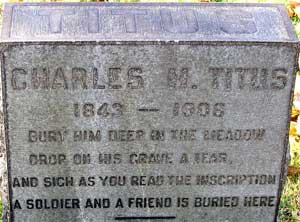
TITUS, CHARLES M. (1843-1908). Unknown soldier history. Born in New Jersey, Titus served in the War although the details of his service are unknown. According to his obituary in The New York Times he was a Civil War veteran and served as the assistant adjutant general of the Union Veteran League after the War. The last line on his gravestone reads, “A soldier and a friend is buried here.” He last lived on 50th Street in Brooklyn. Section 17, lot 17245, grave 1064.
TITUS, LEWIS THURSTON (1839-1920). Private, 13th Regiment, New York State Militia, Company G. During the Civil War, Titus joined the 13th Regiment in 1861 when it was activated for three months. The New York City Directory for 1877 indicates that he was in the storage business. An article in the April 24, 1896 edition of the Brooklyn Daily Eagle reports that Titus was a member of the Brooklyn City Guard in 1861, citizen soldiers who predated the New York State National Guard. The article stated that the 52nd reunion honored the memory of General John B. Woodward (see) who died in 1896. Titus applied for and received an invalid pension in 1908, certificate 1,146,958. The annual Brooklyn Daily Eagle Almanac lists Titus as a Civil War veteran in its “Local Necrology for 1920.” His last residence was at 613 East 14th Street in Brooklyn. Section 106, lot 10396.
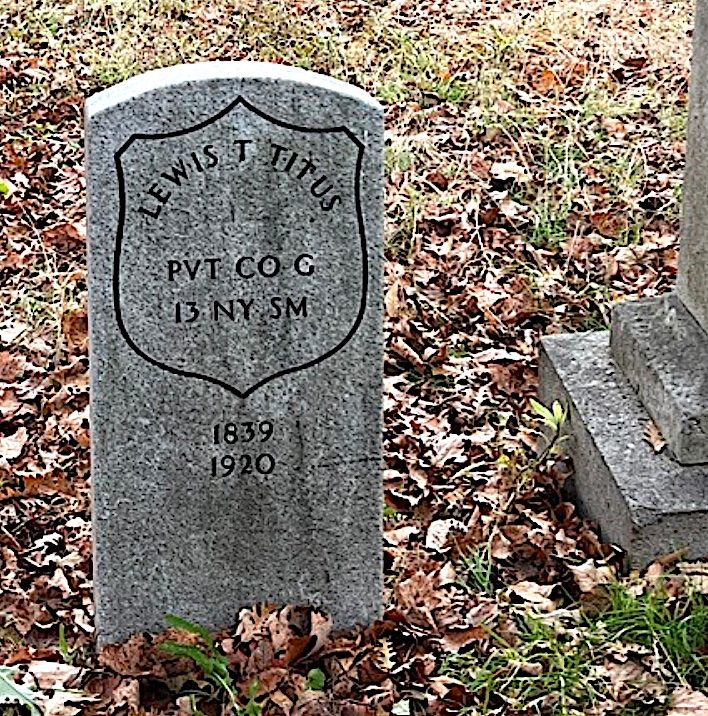
TOBEY, SALATHIAL H. (1830-1906). Captain, 1st Georgia Infantry, Confederate States of America. Tobey, who was born in Massachusetts, chose to serve the Confederate cause. A resident of Shelby County, Tennessee, when he enlisted, he had fair complexion, light hair, grey eyes, and was 5′ 9½” tall. He was commissioned as a captain in the 1st Georgia Infantry on an unknown date, surrendered at Macon County, Georgia, on May 8, 1865, and took the oath of allegiance to the Union.
According to his widow’s obituary in The New York Times, Tobey was the head of a brokerage firm, Tobey & Kirk, in New York City after the Civil War. He last resided at 217 West 45th Street in Manhattan. His widow, Martha Tobey, was a native of Nashville, Tennessee. Section 116, lot 23071.
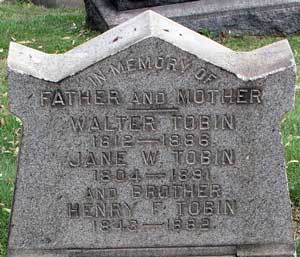
TOBIN, WALTER (1812-1886). Assistant surgeon, 40th New York Infantry. Born in the West Indies, a physician, he enlisted as an assistant surgeon when he was over 50 years old at Falmouth, Virginia, on May 4, 1863, and was commissioned into the Field and Staff of the 40th New York eight days later. In September 1864, he was temporarily detailed to the 110th Pennsylvania Volunteers. He mustered out on June 27, 1865, at Washington, D.C. His last residence was 971 Myrtle Avenue in Brooklyn. Tobin’s cause of death was Bright’s disease. In 1891, Jane Tobin, who is interred with him, applied for and received a widow’s pension, certificate 288,399. Section 21, lot 5488.
TODD, ROBERT BARR (1826-1901). Delegate, Louisiana Secession Convention. Like Mary Ann Todd (Lincoln), his ancestors can be traced back to Robert Todd, who immigrated to the United States from Scotland in 1737. Born in Lexington, Kentucky, he was one of the first graduates of the University of Missouri in 1843, a delegate to the Louisiana Secession Convention who voted in favor secession in January 1861, and served as a justice of the Supreme Court of Louisiana from 1880-1888. He last resided with his daughter at 347 Greene Avenue in Brooklyn. Section 136, lot 28307, 407.
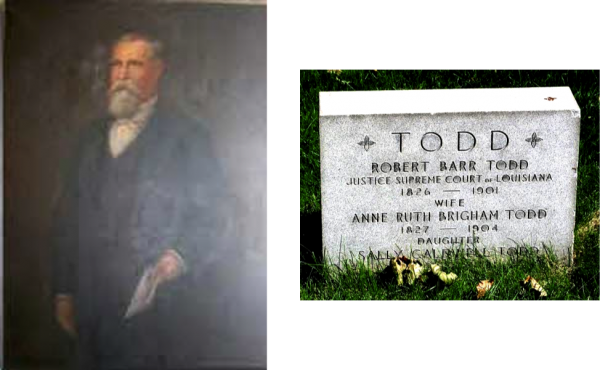
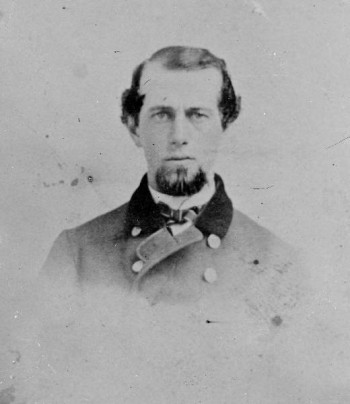
TOFFEY, DANIEL (1837-1893). Captain’s clerk, United States Navy. Born in Pawling, New York, and raised in Jersey City, New Jersey, Toffey was married to Adeline S. Wilson; the couple had three children. During the Civil War, he was assigned to the USS Monitor, the first Union ironclad, as a junior officer with the rank of captain’s clerk in February 1862. His uncle, John Worden, was the commanding officer of the Monitor. A month later, he participated in the second day of the Battle of Hampton Roads, Virginia, on March 9, where the Monitor engaged the Confederate ironclad CSS Virginia (popularly known by its former name, the Merrimack). During that battle, he served as a messenger between the commanding officer in the pilot house and the head officer in the turret, supposedly catching his uncle when he fell, wounded in action. On March 10, 1862, he wrote about that battle:
…I am well and all safe except being somewhat fatigued as I have had scarcely any sleep except a few hours at a time since I left New York, having had a very exciting voyage and engagement…after leaving Sandy Hook Thursday evening. Everything passed off finely until the next day when a northeast gale sprang up and the water rushed over our deck in immense quantities…which had the effect of stopping the blowers from working in the engine room, and the gas immediately escaped from the flues in such quantities that the engineers…the firemen and coal heavers fell with exhaustion and had to be carried on deck….I am happy to say, they are all doing well. The wind was blowing to a perfect gale…but God was with us. Our engines soon began to work….
…The gale began to subside and we were then off the capes of the Delaware and proceeded…until the next day, Saturday, in the afternoon, when within about 15 or 20 miles from Fortress Monroe, we heard heavy firing in the vicinity of the fort and supposing that a fight was going on, we immediately cleared the decks for action…and long before we arrived at the fort, we had everything in perfect firing condition, ammunition and shot passed up and the guns loaded….
…We soon took the pilot on board who informed us that the Rebel Steamer Merrimack had attacked our vessels…we were then ordered to proceed to Newport News and protect the U.S. Steamer Minnesota which was then aground…we laid beside her all night….Early yesterday, we espied the Merrimack coming out…she fired one or two shots at the Minnesota which we returned and then we commanded all of her attention…and for three hours or more…we fought her well….
…The Merrimack ….attempted to run us down and struck us twice, but it did not take any effect. I passed orders…to the turret. I reported the effect of every shot to Lieut. Greene….She is a powerful large vessel and is completely iron plated, her sides like the roof of a house extending up and down at an angle of 45 degrees….
…[Commander] John Worden stood in the wheel house…directing the fight…from 8 in the morning until 12 when a shot from the Merrimack struck the pilot house directly in front of where he was looking out…and he was taken down saying I am not hurt, and sent me for Lieut. Greene to take his place as he was blind….
….The boat is now leaving. I will finish tomorrow….Give my love to all friends. We are all right….We have saved the Minnesota and all vessels in the neighborhood of Fortress Monroe….
On April 17, 1862, Toffey left the Monitor, and by late autumn, he was serving with a New Jersey regiment, and was under fire at the Battle of Fredericksburg, Virginia, on December 13, 1862. The details of his infantry service are not known. Toffey was awarded a gold medal by Congress for his wartime service.
In civilian life, he was a cattle broker and then became an alderman. Census data records his net worth as $10,000 in 1870. According to his obituary in the New York Tribune, he was a pioneer in the exporting of “dressed beef” to Europe and was active in Republican politics. He last lived on Bergen Avenue in Jersey City, New Jersey. Section 103, lot 22413.
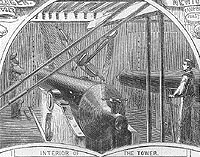
TOLEFREE (or TOLIFREE, TOLFREE), ROBERT R. (1847-1869). Private, 13th New Jersey Infantry, Companies B and I. Originally from Georgia, he enlisted as a private in New Jersey on February 27, 1865, mustered that day into Company B of the 13th New Jersey, and transferred into Company I of his regiment at some point. On June 8, 1865, he transferred into an unassigned company of the 33rd New Jersey from which he mustered out on July 17, 1865, at Washington D.C. His last address was in Plainfield, New Jersey. In 1877, his mother applied for a survivor’s pension, application 234,133, but the certificate number is unknown. Section 13, lot 9343.
TOLFORD (or TALFORD), CHARLES R. (1837-1922). Private, 84th New York (14th Brooklyn) Infantry, Company C. A Brooklynite by birth, Tolford is listed in the Brooklyn Directory for 1857-1862 both as a law student and as a grocer; both show that he was living at 163 Schermerhorn Street. During the Civil War, he enlisted at Brooklyn as a private on April 18, 1861, and mustered into the 14th Brooklyn on May 23. He was discharged for disability on August 19, 1861, at Arlington, Virginia.
The Brooklyn Directory for 1862 indicates that Tolford was a clerk whose home was at 163 Schermerhorn Street. In 1890, his application for an invalid pension was approved, certificate 923,967. On May 19, 1911, he was listed as among the surviving veterans of the “Fighting Fourteenth” on the occasion of their 50th anniversary. The Brooklyn Daily Eagle, in their article about that event, noted that he was a resident of the Soldiers Home in Togus, Maine. He continued to reside there and in Brooklyn. He died of heart disease; his obituary in the Brooklyn Daily Eagle notes that he died suddenly at 402 Fulton Street in Brooklyn. Section 101, lot 8262.
TOMLIN, JAMES A. (1842-1914). Private, 6th New York Infantry, Company D; 16th New York Heavy Artillery, Company E. A native of New York, Tomlin enlisted as a private at New York City on May 26, 1861, mustered immediately into the 6th New York, and mustered out with his company at New York City on June 25, 1863. Tomlin re-enlisted at Brooklyn on December 14, 1863, mustered into the 16th Heavy Artillery two days later, and mustered out with his company on August 21, 1865, at Washington, D.C.
Goulding’s Manual of New York and General Statistical Guide for 1875 lists Tomlin as a painter. The New York City Directory for 1889 reports that Tomlin was a clerk. In 1893, he applied for and received an invalid pension, certificate 1,033,564. As per the census of 1910, he was living on West 51st Street in Manhattan, working as a cooper (barrel-maker), was able to read and write, and was a survivor of the Union Army. He last lived at 549 West 51st Street in Manhattan. The cause of his death was endocarditis. Shortly after his death in 1914, Josephine Tomlin applied for and received a widow’s pension, certificate 755,832. Lot 18372, grave 150.
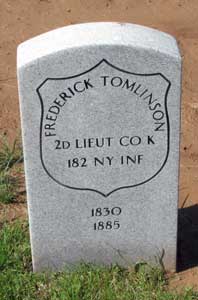
TOMLINSON, FREDERICK (1830-1885). Second lieutenant, 182nd New York Infantry, Company K. Born in England, he enlisted as a first sergeant on September 22, 1862, at New York City. On November 17, 1862, he mustered into the 182nd New York. Tomlinson was promoted to second lieutenant on June 5, 1863, and was dismissed on July 15, 1865. In 1879, he applied for an invalid pension, application 807,367, but it does not appear to have been granted. He last lived at 171 Tenth Avenue in Manhattan. He succumbed to pneumonia. Section 2, lot 5499, grave 1013.

TOMPKINS, HENRY (1839-1890). Artificer, 1st New York Engineers. He enlisted as a private and mustered into the 1st Engineers on December 12, 1863. At some point, he was promoted to artificer before he mustered out on October 15, 1864, at Varina, Virginia. Tompkins also served in the 4th New York Independent Battery. He was a resident of New Utrecht, Brooklyn. Section 206, lot 21347, grave 543.

TOOKER, SAMUEL COBB (1841-1906). Private, 8th Regiment, New York State Militia, Company E. Tooker served with the 8th Regiment for three months in 1861. Section 109, lot 3475.
TOOMBS, SAMUEL S. (1835-1914). Private, 13th Regiment, New York State Militia, Company D. Born in Brooklyn, he enlisted and served with the 13th Regiment when it was activated for 30 days in 1861. The Brooklyn Directories for 1863, 1864, and 1866 report that he was a plumber. Toombs’s pension application was approved, certificate 1,086,305.
As per his obituary in the Brooklyn Daily Eagle, which confirms his Civil War service, he was in the plumbing business for many years but was employed by the Department of Water Supply, Gas and Electric of the City of New York for the last fourteen years of his life. The obituary reported that Toombs congratulated the Brooklyn Daily Eagle on its 70th anniversary in October 1911 and stated that he had been a reader since “the big fire of 1848.” Active in community life, he was a member of the Society of Old Brooklynites, the Knights of Honor (a fraternal society), and the Brooklyn Veterans Volunteer Firemen. He was also a member of the Veteran Association of the 13th Regiment, New York State National Guard; comrades were requested to attend his funeral. His last residence was 2642 East 24th Street in Sheepshead Bay, Brooklyn. Annie Toombs applied for and received a widow’s pension in 1914, certificate 781,373. Section 6, lot 33090, grave 3.

TOPHAM, THOMAS W. (1844-1912). Sergeant, 2nd New Jersey Infantry, Company C. Born in Webster, Massachusetts, he was graduated from high school in Newark, New Jersey. Topham enlisted and mustered into the 2nd New Jersey as a private on May 27, 1861. He was promoted to corporal on November 1, 1862, and to sergeant on March 25, 1864. He fought in the following battles in Virginia: First Bull Run, West Point, Malvern Hill, Gaines’ Mills, White Oak Swamp, First and Second Fredericksburg, Salem Heights, the Wilderness, and Spotsylvania; South Mountain, Maryland; and Gettysburg, Pennsylvania. At the Battle of Second Bull Run, Virginia, Topham had four of his ribs fractured by a shell and was in an Army General Hospital for almost two months. On June 21, 1864, he mustered out at Newark, New Jersey.
In 1870, Topham moved to Indianapolis, Indiana, where he attended the Indiana College of Physicians and Surgeons. After he graduated in 1873 and practiced for a time in Indianapolis, he became a teacher at the National Surgical Institute. On January 10, 1884, he opened a medical practice in Brooklyn. He was a member of the Ulysses S. Grant Post #327 of the Grand Army of the Republic and served as its post surgeon for two terms. His last residence was 354 Schermerhorn Street in Brooklyn. Section 87, lot 1715.
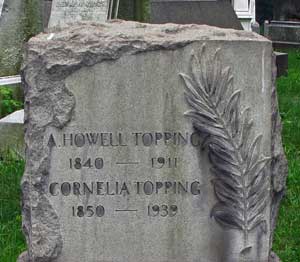
TOPPING, ABIJAH HOWELL (1840-1911). Associate member, Grand Army of the Republic (G.A.R.). Topping was born in Rockaway, New Jersey. A wholesale hatter with a large store, Topping, Maynard & Hobron, at 597 Broadway, he became wealthy and was active in many organizations including the Union League and the Freemasons. He was an associate member of the Ulysses S. Grant Post #327 of the G.A.R., an organization for veterans of the Civil War. Associate memberships in the G.A.R. were given to those who were prominent in social and Masonic circles but were not veterans of that conflict. At the time of his death, he lived at 489 Willoughby Avenue in Brooklyn. Section 23, lot 4049.

TOPPING, MELANCTHON HOWELL (1836-1892). Captain, 100th New York Infantry, Company B. After enlisting as a first lieutenant at Le Roy, New York, on September 1, 1861, he was commissioned into the 100th New York on January 7, 1862, promoted to captain on December 1, 1862, and discharged on April 21, 1864. He last resided at 235 Hancock Street in Brooklyn. He died of pneumonia. After he was interred on May 13, 1892, his remains were moved from lot 18867 on June 23 of that year. There is a G.A.R. shield next to his tombstone noting his membership in the Ulysses S. Grant Post #327. Section 196, lot 28058, grave 1.
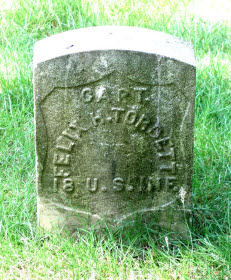
TORBETT (or TORBITT), FELIX HUSTON (1836-1876). Major and captain by brevet; captain, 16th Infantry, United States Army; corporal, 2nd Infantry, United States Army, Company H. Born in Tennessee, Torbett enlisted as a private on December 11, 1859, and mustered into the 2nd Infantry of the United States Army on that date. At some point during his service, he became a corporal and then a sergeant. On February 19, 1863, he was discharged for promotion and transferred to the 16th Infantry of the United States Army and commissioned as a second lieutenant. He rose to first lieutenant on May 5 of that year.
Torbett was wounded at the Battle of Missionary Ridge, Tennessee, and saw action at the battles of the Atlanta Campaign including Resaca, New Hope Church, Kennesaw Mountain, Gulp’s Farm, Peach-Tree Creek, and Jonesboro. As a result of “…gallant and meritorious service during the Atlantic Campaign and the Battle of Jonesboro, Georgia,” he was brevetted captain and major on September 1, 1864. From March 1865 through September 1866, he was on recruiting duty in New York City. He was promoted to captain on March 19, 1866, and served in the United States Army until he mustered out on January 1, 1871. Torbett died of a gunshot wound to the abdomen in Paris, Tennessee. According to a descendant, he was a U.S. Marshal in Tennessee and was killed in the line of duty during an arrest of V.C. Giles for selling unstamped tobacco. Three of his brothers served in the Confederate Army. Section 78, lot 2579.
TOSHACK (or TOSBACK), JAMES (1841-1887). Seaman, United States Navy. Of English origin, he enlisted on July 6, 1864, as a seaman in the United States Navy and served until his discharge on August 11, 1867. He was a member of the G.A.R. He last resided at 74 Classon Avenue, Brooklyn. Section 183, lot 20215.

TOTTEN, HENRY (1843-1890). Second lieutenant, 59th New York Infantry, Companies F and D. After enlisting as a sergeant at New York City on October 2, 1861, and mustering into Company F on that day, he was reduced to ranks on December 4, 1861, promoted to first sergeant on January 1, 1862, and transferred to Company D on September 17, 1862, upon his promotion that day to second lieutenant. He last lived in New York City. Shortly after his death from uremia, Frances A. Totten, who is interred with him, applied for and received a widow’s pension in 1890, certificate 317,480. Section 172, lot 14509.
TOWERS, JAMES C. (1835-1869). Corporal, 8th Regiment, New York State National Guard, Company B. A native of New York State, he enlisted on May 29, 1862, at New York City, as a corporal. On that date, he mustered into the 8th Regiment, and mustered out after three months at New York City on September 10. His last residence was at 24 East 50th Street in Manhattan. Section ?, lot ?.
TOWERS, RICHARD (1838-1876). Private, 7th Ohio Infantry, Company C. Towers enlisted on April 25, 1861, as a private, and mustered into the 7th Ohio Infantry on that date. He was discharged on August 18, 1861, at an unknown place. His last residence was at the Taylor’s Hotel in Jersey City, New Jersey. Section 148, lot 20193.
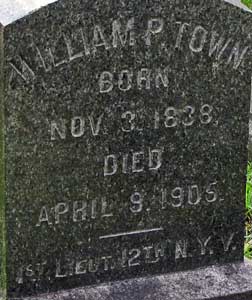
TOWN, WILLIAM P. (1838-1905). First lieutenant, 12th New York Infantry, Company K. After he enlisted at Elba, New York, on April 24, 1861, he was commissioned into the 12th New York as a first lieutenant on May 13, and resigned on August 6 of the same year. Section 23, lot 4049.
TOWNSEND, CHARLES HARRISON (1838-1911). Sergeant, 83rd New York Infantry, Company L; 6th Veteran Reserve Corps, Company A. Born in Buffalo, New York, he was employed as a clerk at the time he enlisted and mustered into the 83rd at New York City as a private on September 6, 1861. He was 5′ 9″ with blue eyes, sandy hair, and a fair complexion. Wounded at Chancellorsville, Virginia, on May 3, 1863, he was taken as a prisoner of war that day and paroled on an unknown date. On January 12, 1864, he was transferred to the 6th Veteran Reserve Corps, and was discharged at Washington, D.C., on June 12, 1865.
After the War, Townsend lived in Washington, D.C., Savannah, Georgia, and Key West, Florida, before moving to New York City where he was employed by the Customs Service. He was granted a pension in 1908, certificate 1,101,237. His last residence was at 805 Sterling Place in Brooklyn. In 1911, Clara E. Townsend, who is interred with him, applied for and received a widow’s pension, certificate 737,223. Section 168, lot 16051.
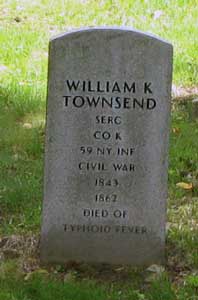
TOWNSEND, WILLIAM K. (1843-1862). Private, 59th New York Infantry, Company K. A native of New York, Townsend resided on Ninth Avenue in Manhattan when he enlisted as a private at New York City on September 1, 1861, and mustered into the 59th that day. He died of typhoid fever at Frederick Hospital in Frederick, Maryland. Section 73, lot 6031.
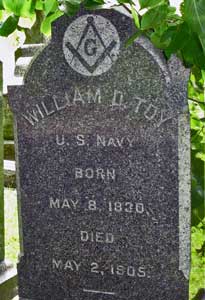
TOY, WILLIAM D. (1830-1905). Carpenter, United States Navy. A native of Philadelphia, Pennsylvania, Toy served as carpenter on the USS Brooklyn which was damaged during the attack on Forts Jackson and St. Philip in April 1862. The details of the damage were documented in a report written by him from New Orleans, Louisiana. Toy also served as carpenter on the USS Lancaster from 1862-1863. The Lancaster, which was part of the U.S. Ram Fleet, was present in the background during the naval action off Memphis, Tennessee, in June 1862 and subsequently took part in operations against the Confederate fortress at Vicksburg, Mississippi. Disabled in action in July, 1862, the Lancaster was repaired and participated in a daring run past the fortress on March 25, 1863, during which she was sunk by Confederate cannon fire. As per his obituary in the Brooklyn Daily Eagle, he was a Freemason. He last resided at 413 Madison Street in Brooklyn. Section 92, lot 10153, grave 4.
TRABANT, FRITZ (1837-1891). Private, 52nd Regiment, New York State National Guard; 176th New York Infantry. Of German birth, Trabant enlisted at Brooklyn as a private on October 14, 1862, mustered into an unknown company of the 52nd Regiment that day, and was transferred into an unknown company of the 176th New York on December 15, 1862.
An article in the Brooklyn Daily Eagle on August 4, 1876, noted that he was incarcerated after stabbing John Creamer and his two sons during a fight at the tenement house where they all resided at 269 Pacific Street in Brooklyn the preceding day. The elder Creamer was severely injured. According to the report, Trabant was a billiard table maker who was in a long-standing feud with the Creamer family. After Trabant’s daughter dropped a flower pot from her window on Creamer’s daughter, who was playing on the sidewalk below, the three Creamer men began their assault on Trabant, punching him in the eye, pounding him and tearing at his clothes while the wives fought on the floor. Despite claiming that he was the aggrieved party, Trabant was returned to his cell after he testified in court. His last residence was 231 Pacific Street in Brooklyn. Section 135, lot 27263, grave 953.
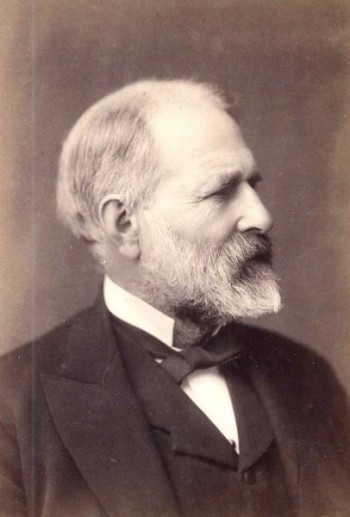
TRACEY (or TRACY), BENJAMIN FRANKLIN (1830-1915). Medal of Honor recipient; brigadier general by brevet; colonel, 109th New York Infantry, 127th United States Colored Infantry. Born in Owego, New York, Tracey entered service after recruiting for the 109th and 137th New York Infantries and served as colonel of the 109th from August 28, 1862-May 17, 1864. During that time, he led his regiment in Virginia at the Wilderness and at Spotsylvania Court House, but exhaustion forced him to surrender command. Beginning September 10, 1864, he was the colonel of the 127th United States Colored Infantry (USCT). On March 13, 1865, he was brevetted brigadier general “for gallant and meritorious services during the War.” On June 21, 1895, he was awarded the Medal of Honor for his gallantry when he seized the colors at the Wilderness and led his regiment after other regiments had retired; afterwards, he re-formed and held his line. Tracey also served as the commander of the military prison in Elmira, New York, where 10,000 Confederates were held.
After the War, Tracey practiced law, was appointed United States Attorney for the Eastern District of New York, and served as a judge of the New York State Court of Appeals from 1881 to 1883. Appointed United States Secretary of the Navy by President Harrison, he held that office from 1889-93. Known as the “Father of the Fighting Navy,” the great battleships that fought in the Spanish-American War were built during his watch. He chaired the commission that, in 1896, drafted the charter for Greater New York, and ran unsuccessfully as the Republican candidate for mayor of New York City. His name is displayed as Benjamin F. Tracy on the African American Civil War Memorial in Washington, D.C., plaque D-133. Thousands attended his funeral. His last address was in Manhattan. Section 139, lot 27142.
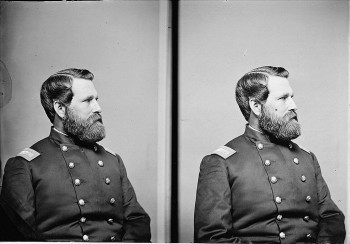
TRACY (or TRACEY), PRESCOTT (1832-1867). First lieutenant, 5th New York Infantry, Company K; first sergeant, 82nd New York Infantry, Company G; 59th New York Infantry, Company G. Originally from Ireland and employed as a clerk, Tracy was 6′ tall with blue eyes and brown hair. After enlisting as a first lieutenant at New York City on April 25, 1861, he was commissioned into the 5th New York on May 9, and resigned on August 1 of that year. He re-enlisted as a private at New York City on January 22, 1862, mustered into the 82nd New York that day, and was promoted to first sergeant in March 1862. When he returned to the 82nd after he deserted at Bolivar, West Virginia, on October 30, he was reduced in rank to private. He was captured at Petersburg, Virginia, on June 22, 1864, confined at the infamous Andersonville [Georgia] Prison, and exchanged on August 16. He subsequently served in the 59th New York and mustered out on June 27, 1865, at Petersburg, Virginia. He last lived in Stapleton, Staten Island. Section 95, lot 13177.
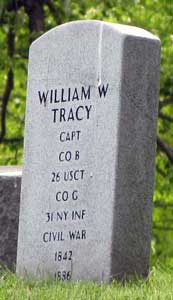
TRACY, WILLIAM W. (1842-1886). Captain, 26th United States Colored Troops (USCT), Company B; first lieutenant, 31st New York Infantry, Company G; private, 7th Regiment, New York State National Guard, Company C. Tracy first served with the 7th Regiment for three months in 1862 from May 25-September 5. After he re-enlisted as a second lieutenant at White Oak Church, Virginia, on January 9, 1863, he mustered into the 31st New York on March 7. Tracy was promoted to first lieutenant on March 16, 1863, fought at Chancellorsville, Virginia, where his regiment lost half of its men, and served as an adjutant from June 15-October 14, 1863. He re-enlisted as a captain, immediately mustered into the 26th USCT on February 4, 1864, and fought in South Carolina at the Battle of Pocotaligo and at many skirmishes near Charleston Harbor before mustering out on August 28, 1865. His name is displayed on the African American Civil War Memorial in Washington, D.C., plaque B-42. He last resided at 39 East 31st Street in Manhattan. His death was caused by phthisis. Section 70, lot 4020.
TRACY, WILLIAM WILLIT (1841-1864). Captain, 65th New York Infantry, Companies I, E, and H. Tracy is not buried at Green-Wood; a cenotaph honors his memory. On September 19, 1861, Tracy enlisted in the 65th New York as a private; he mustered in the next day. He was promoted to sergeant in October 1861, mustered in as second lieutenant, Company E, on August 1, 1862, rose to first lieutenant, Company H, on December 1, 1862, and became captain on September 2, 1863. He was killed at the Wilderness, Virginia, on May 6, 1864, and buried on the battlefield there. Section 158, lot 17524.
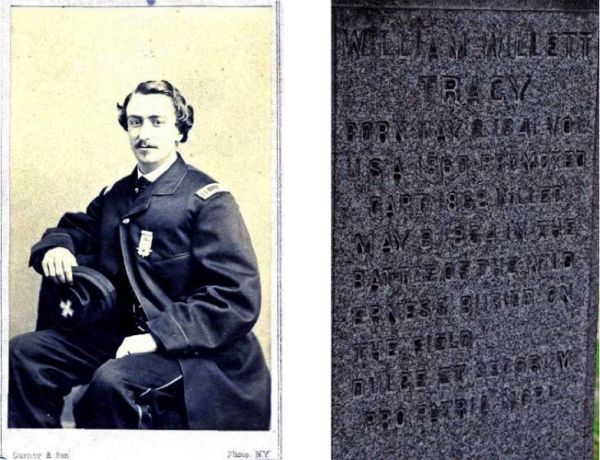

TRAENDLEY (or TRAENDLE), FRANZ (1834-1889). Private, 20th New York Infantry, Company D. Born in Germany, he enlisted as a private on August 15, 1861, and mustered into Company D of the 20th New York three days later. On April 14, 1863, he deserted at New York City while on furlough. His last residence was 330 West 16th Street in Manhattan. Section 190, lot 22909.
TRAUB, CHARLES (1831-?). First sergeant, 5th Regiment, New York State National Guard, Company A. There was only one Charles Traub who lived in New York and served in the Civil War but there are two Charles Traubs in Green-Wood who might be the veteran in question. He enlisted as a private in 1863, served with the 5th National Guard for 30 days during its activation that year, and was promoted to first sergeant before he mustered out with his company. If he was the Traub who died in 1877, he was interred in section 46, lot 22571; if he was the Traub who died in 1908, then he was buried in section 127, lot 16311, grave 200.
TRAVELL, JOHN (1834-1894). Corporal, 48th New York Infantry, Company C. Born in Ireland, Travell enlisted at Brooklyn as a private on September 6, 1861, and mustered into the 48th New York four days later. At some point, he was promoted to corporal, but then reduced in rank to private before he was discharged on September 20, 1864. According to his discharge papers, he was a carpenter who was 5′ 5″ tall with blue eyes and light hair. He last lived on 3rd Avenue in Brooklyn. After his death from a cerebral hemorrhage, Mary Travell, who is interred with him, applied for and received a widow’s pension in 1894, certificate 414,848. Section 17, lot 17245, grave 874.
TRAVERS, PATRICK HENRY (1845-1917). Second lieutenant, 164th New York Infantry, Company H. Originally from Ireland, he enlisted as a private at Brooklyn on August 19, 1862, mustered into the 164th on November 19, and rose to corporal on February 5, 1864. He was wounded in the right side at Cold Harbor, Virginia, on June 3, 1864, was subsequently treated at De Camp General Hospital in New York Harbor on June 21, and returned to active duty on August 13. He became a first sergeant on March 1, 1865, before mustering out on July 15 at Washington, D.C. On October 17, 1865, he was brevetted a second lieutenant “for meritorious conduct during term of service.”
In 1872, Travers’s application for an invalid pension was granted, certificate 225,531. He spent many years in the New York City Fire Department and worked his way up to battalion chief. A member of the Tefft-Odell Post of the G.A.R., he last lived in Brooklyn at 687 Greene Avenue. Section 5, lot 34254, grave 1.
TRAVIS, ROBERT P. (1836-1910). Private, 83rd New York Infantry, Company C; 97th New York Infantry, Company C; 94th New York Infantry, Company C. A native of New York City, Travis enlisted there as a private on November 18, 1861, mustered into the 83rd that day, and was transferred into the 97th New York on June 7, 1864. On August 10, 1864, he was transferred into Company C of the 94th New York where he served until his discharge on November 15, 1864. He last lived at 352 Center Street in Nutley, New Jersey. Section 190, lot 17948, grave 1.
TRAYNOR, EDWARD A. (1846-1911). Corporal, 139th New York Infantry, Company C. Traynor enlisted as a private on August 22, 1862, mustered into his company on September 9, and was promoted to corporal on April 10, 1863. He was taken as a prisoner of war on October 18, 1863, at Charles Town, West Virginia, and mustered out on June 19, 1865, at Richmond, Virginia. He last lived at 349 19th Street in Brooklyn. Section 6, lot 20118, grave 678.

TREADWELL, CHARLES S. (1843-1884). Sergeant, 90th New York Infantry, Companies K and A. Treadwell, who was born in Houlton, Maine, was living in Brooklyn and employed as a clerk when the census was taken in 1860. After he enlisted as a corporal at Brooklyn on October 21, 1861, he immediately mustered into Company K of the 90th New York. As per his muster roll, he was a clerk who was 5′ 9″ tall with gray eyes, light hair and a light complexion. Treadwell was promoted to sergeant on March 1, 1862, and mustered out on an unknown date. He re-enlisted on February 20, 1864, was reduced to the rank of private on July 31, 1864, transferred to Company A on November 30 of that year, and mustered out on February 9, 1866, at Albany, New York.
In 1880, Treadwell applied for and was granted an invalid pension, certificate 236,472. Remaining active in military affairs, he was a sergeant for seven years with the 14th Regiment, New York State National Guard. In addition, he was a member of the John H. Perry Post #89 of the G.A.R. The 1880 census reports that he was a house carpenter but he worked little the last two years of his life, and was bed-ridden for two months before his death, He last lived at 716 Bedford Avenue in Brooklyn.
The January 5, 1884, edition of the Brooklyn Daily Eagle reported on the controversy regarding the time and place of his funeral. That article, which confirms his Civil War service, notes that Treadwell served for three months in the 13th Regiment before serving with the 90th and that he sustained unspecified injuries. The controversy over his funeral stemmed from a decision by the Reverend L. T. Chamberlain of the Classon Avenue Presbyterian Church that affected Treadwell’s comrades in the Perry Post of the G.A.R. Treadwell had asked his wife to have his funeral take place at the church on a Sunday so that a large contingent of his G.A.R. comrades could attend. The Eagle reported that of the 5,000 G.A.R. men in Brooklyn, 2,500 were members of the Perry Post. Rev. Chamberlain refused the request and also refused to allow the Sunday school room to be used for the funeral. Chamberlain attested that a Sunday funeral interfered with regularly scheduled services. Sarah Treadwell told the reporter who came to her house:
My dear husband who lies there, was a good man. He never chewed, smoked or drank, and that will tell what kind of a man he was. You see he is covered with the flag, which he helped to save, and then to think that any one could be so hard hearted as to refuse his last request. He asked me before he died to have him buried from the Classon Avenue church, and I promised him it should be done….
The Eagle then interviewed Reverend Chamberlain who denied that there was a controversy and refused to discuss the matter. The reporter asked if it was because Treadwell was poor and then quoted an unnamed comrade from the Perry Post, “I am a member of Perry Post, and as such feel very indignant over the insult which has been given to the memory of the deceased as well as to every Grand Army man in Brooklyn…” The funeral was conducted at the Treadwell home by Reverend Job G. Bass (see), the former chaplain of the 90th New York. The draped coffin was placed in the front room and visitors entered the front door to view the body and then exited the rear door. Treadwell’s comrades from the G.A.R. escorted the remains to Green-Wood. A follow-up article in the Brooklyn Daily Eagle on January 7, 1884, noted that Reverend Chamberlain was present at the home services and that a committee would be formed at the Perry Post’s next meeting to investigate Chamberlain’s alleged action of refusing a church funeral service on a Sunday. Treadwell’s widow, Sarah, who later married Charles McWilliams (see), was awarded a pension in 1884, certificate 206,702, and a minor child received a pension in 1890, certificate 276,074. Section 13, lot 19694, grave 180.

TREAT, WILLIAM B. (1838-1888). Private, 80th New York Infantry, Company D. Treat enlisted and mustered into the 80th New York as a private on September 5, 1861, at Kingston, New York. He mustered out on January 29, 1866, at Portsmouth, Virginia. In 1880, he applied for and was granted an invalid pension, certificate 227,612. His last residence was at 500 Myrtle Avenue in Brooklyn. Section 4, lot 21316, grave 132.
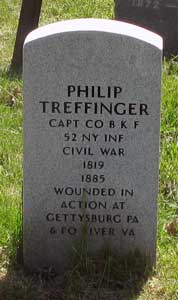
TREFFINGER, PHILIP (1819-1885). Captain, 52nd New York Infantry, Companies B, K, and F. At age 43, he enlisted as a sergeant at New York City on August 9, 1861, and mustered into Company B of the 52nd New York on November 1. He was promoted to second lieutenant on March 4, 1863, effective upon his transfer that day to Company K, and was wounded in action at Gettysburg, Pennsylvania, on July 2, 1863. On November 17, 1863, he was promoted to captain and suffered his second battlefield wound at Po River, Virginia, on May 12, 1864. He was transferred to Company F on October 15, 1864, and mustered out on February 22, 1865, at Petersburg, Virginia. As per the New York City Directory of 1877, he was a janitor. His last address was 105 Ludlow Street in Manhattan. He died of Bright’s disease. Section 114, lot 8999, grave 1.
TREHON, JOSEPH A. (1820-1871). Corporal, 139th New York Infantry, Company F. After Trehon enlisted at Brooklyn as a private on August 22, 1862, he mustered into the 139th New York on September 9, and was wounded on June 2, 1864, at the Battle of Cold Harbor, Virginia. On September 1, 1864, he was promoted to corporal of his company serving in that rank until he mustered out on June 19, 1865, at Richmond, Virginia. His last residence was 287 Smith Street in Brooklyn. Section A, lot 9146, grave 126.
TREMAIN, WALTER RUTHVEN (1844-1862). First lieutenant, 53rd New York Infantry, Company F; 132nd New York Infantry, Company C; second lieutenant, 73rd New York Infantry, Company C; private, 7th Regiment, New York State Militia, Company C. He enrolled at New York City as a private on April 22, 1861, mustered into the 7th Regiment on April 26, and mustered out with his company at New York City after 30 days of service on June 3. He re-enlisted on July 6, 1861, at Camp Scott, New York, as a second lieutenant, was commissioned into the 73rd New York, and was discharged on August 20, 1861, prior to being mustered. Subsequently, he enlisted at New York City as a first lieutenant on May 17, 1862, was commissioned into the 53rd New York (second organization) on June 16, and transferred into the 132nd New York on September 10, 1862, where he acted for a time as an adjutant. After serving on picket and expeditionary duty, he contracted typhoid fever resulting in his death on December 25, 1862, at New York City.
His friend wrote that Tremain was “…a true patriot, and a youthful martyr to his love of country and the cause of republican government.” In his bio in William Swinton’s History of the Seventh Regiment, National Guard, State of New York During the War of the Rebellion (1870), it is noted that his last thoughts were for his country and that he regretted that he had “done so little for her.” His comrades considered him a promising young officer who had a kind nature and was a “brave and noble defender” of his country. He last resided at 10 West 35th Street in Manhattan. Section 90, lot 3234.
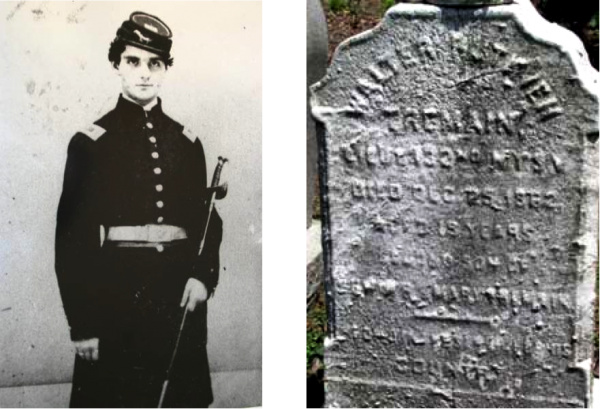
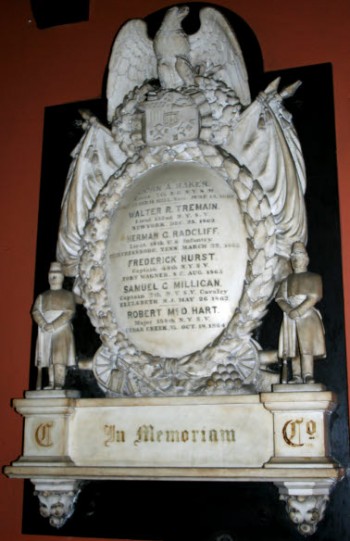
TREMAINE, JOHN M. (1812-1877). Private, 13th Regiment, New York State Militia, Company G. After Tremaine enlisted in 1861, he mustered into the 13th Regiment for its three month activation. His last residence was in Brooklyn. Section 25, lot 3074.
TREPP, CASPER (or CASPAR) (1829-1863). Lieutenant colonel, 1st United States Sharpshooters, Company A. Born in Switzerland, Trepp received military training and served as an officer in the British Foreign Legion from 1848-57 before coming to New York City in 1858. While in England, he married Harriet Bear on November 9, 1856, in the Parish of St. Mary in Lambeth, an inner borough of London in the county of Surrey; he listed his occupation as draftsman on his marriage certificate. When the Civil War began, he volunteered for service, helped to organize two regiments of Berdan’s Sharpshooters and was commissioned captain of Company A, 1st United States Sharpshooters, on August 20, 1861. He spent the next two years in the field, skirmishing, and fought in Virginia at Second Bull Run and Chancellorsville, and at Gettysburg, Pennsylvania. He was promoted to major and, on September 22, 1862, was promoted to lieutenant colonel. On November 30, 1863, at Mine Run, Virginia, Trepp was shot through the head and killed by a Confederate sniper. First buried in a crude coffin on the battlefield and later re-interred on a farm at Brandy Station, Virginia, he was finally brought back to New York at his wife’s request. He last lived at 237 West 43rd Street in Manhattan.
Forty-nine days after his death, his wife Harriet died of typhoid fever, and left three orphaned children, ages 6, 4, and 2. Initially, on January 25, 1864, Henry Escher, an attorney, represented the children’s interests in court, claiming them destitute and in need of a protector; a minor’s pension of $30 per month was granted as of March 1866 backdated to November 1863. Sadly, at some point, the children were separated. On April 15, 1936, Robert Washington Trepp, Casper’s son, who was born in 1861 and had received a minor’s pension under certificate 68,334, wrote to the Pension Bureau asking for all the details about his father including the names and birth places of his children. Section 114, lot 8999, grave 101.

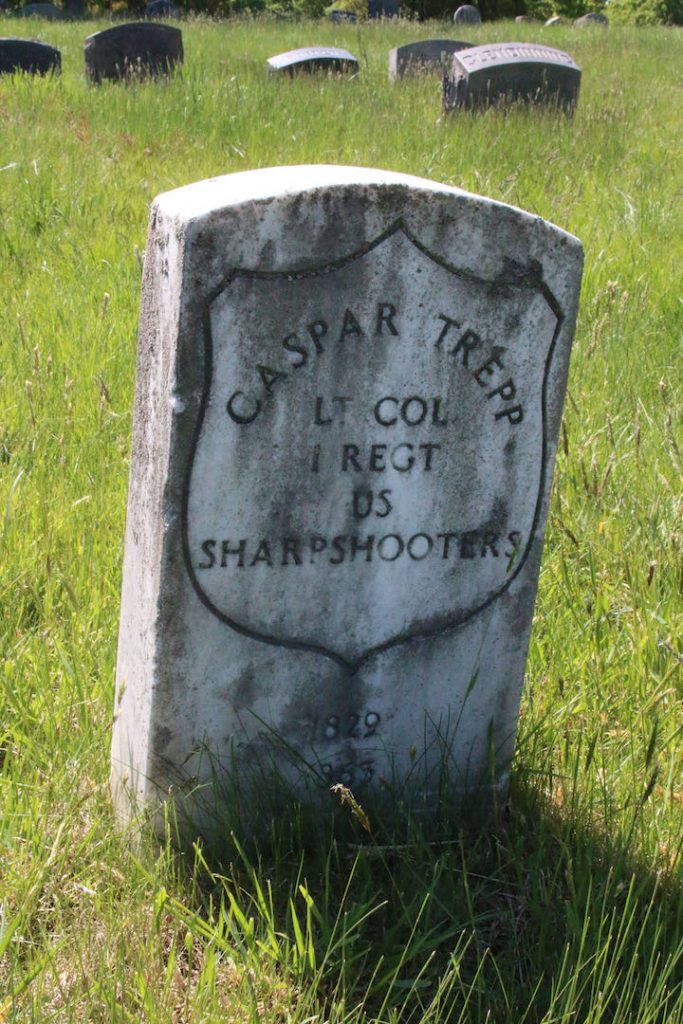
TREVOR (or TRAVER), JOHN (1843-1917). Corporal, 1st New York Cavalry, Company M. A native of Cavan County, Ireland, Trevor enlisted as a private at New York City on August 1, 1861, and mustered into Company M of the 1st New York Cavalry on September 9. According to a descendant, his pension records note that he was in confinement on June 30, 1862; no other details of that confinement are known. He was promoted to corporal on October 1, 1862, and reduced to ranks before he re-enlisted on January 1, 1864. Trevor was again promoted to corporal on November 1, 1864, and mustered out on June 27, 1865, at Alexandria, Virginia.
On October 18, 1871, Trevor married Mary Griffin; the couple resided at 1984 Pacific Street in Brooklyn. In civilian life, he was a carpenter. In 1904, his application for a pension was approved, certificate 1,096,418. He last lived in Brooklyn. Mary Trevor applied for and received a widow’s pension in 1917, certificate 854,471. Section 197, lot 30974.
TRICKEY, AARON (1842-1906). Private, 22nd Regiment, New York State National Guard, Company K. A New York native, Trickey served for 30 days with the 22nd Regiment in 1863. In the 1880s and 1890s, he was listed as a bookkeeper and accountant in the Brooklyn City Directory. He last lived at 160 Taylor Street in Brooklyn. Section 56, lot 4373.
TRIGG, JOSEPH (1820-1892). Bandleader, 18th United States Infantry. A German by birth, he was a bandleader in the 18th U.S. Infantry (Regular Army). No additional details of his service are known. Trigg’s last residence was 277 14th Street, Brooklyn. Charlotte M. Trigg, who is interred with him, applied for and was granted a widow’s pension in 1897, certificate 457,736. Section 6, lot 20118, grave 840.
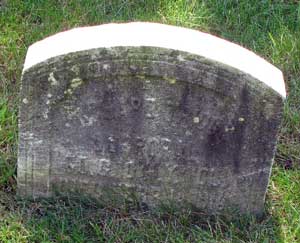
TRIGGS (or TRIGG), RICHARD (1841-1916). Private, 10th New York Infantry, Company F. Of Irish origin, Trigg enlisted at New York City as a private on April 26, 1861, mustered into the 10th New York four days later, and mustered out of military service on May 6, 1863, at New York City. He last lived at 62 Howard Avenue in Brooklyn. Section 107, lot 10320.
TRIPP, SILAS D. (or O.) (1843-1916). Corporal, 109th New York Infantry, Company K. Tripp, who was born in New York State, enlisted as a private at Nichols, New York, on August 6, 1862, mustered into the 109th on August 18, and was promoted to corporal nine days later. He was discharged from Sough Hospital in Alexandria, Virginia, on June 15, 1865. His last residence was in Falls Church, Virginia. Section 60, lot 3889.
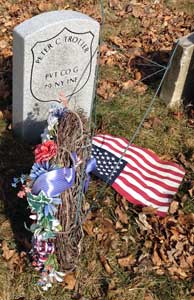
TROTTER, PETER C. (or E.) (1822-1862). Private, 79th New York Infantry, Company G. A native New Yorker, he enlisted there on May 13, 1861, and mustered into the 79th New York on May 28. Wounded by gunshot at James Island, South Carolina, on June 16, 1862, he died of his wounds on or about July 1, 1862, at New York City. His last address was 40 West 16th Street in Manhattan. Section 115, lot 13536 (Soldiers’ Lot), grave 47.
TRUAX, WILLIAM W. (1832-1895). Seaman, United States Navy. Truax served in the Navy on the USS Merredito. Further details of his service are not known. His last residence was 125 33rd Street in Brooklyn. Section 135, lot 27263, grave 2564.
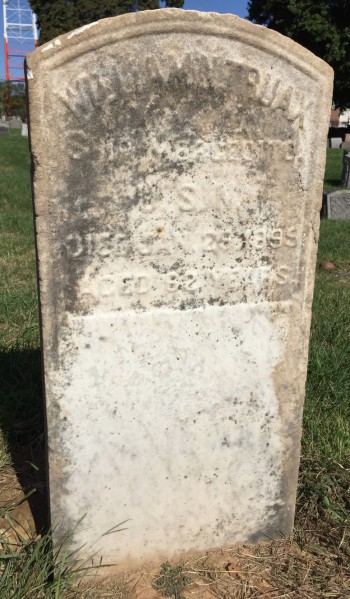
TRUMPER, JOHN (1838-1914). Corporal, 56th New York Infantry, Company D. Originally from Warwick, New York, Trumper was a house carpenter according to the census of 1860. During the Civil War, he enlisted as a private on October 5, 1861, and mustered into the 56th New York five days later. On February 20, 1864, he re-enlisted and returned to the same regiment and company with a promotion to corporal. He was discharged on October 17, 1865, at Charleston, South Carolina.
As per the censuses of 1870 and 1880, Trumper was a stove mounter. In 1879, he applied for and was granted an invalid pension, certificate 421,678. His military service was confirmed by the 1890 Veterans Census. In 1900, census records note that he was living in Morris, New Jersey. His last resided at the Soldiers’ Home in Kearny, New Jersey. Trumper died from chronic bronchitis. Section 14, lot 4969, grave 99.

TRUSS, JR., GEORGE W. (1835-1868). Second lieutenant, 53rd New York Infantry, Company A; private, 82nd New York Infantry, Company C; 83rd New York Infantry, Company I; 97th New York Infantry, Company F. Truss enlisted at New York City, his birthplace, on May 21, 1861, and immediately mustered into the 82nd New York. He was discharged for disability on December 16, 1861, at Washington, D.C. He re-enlisted at New York City as a second lieutenant on March 1, 1862. On May 22, he was commissioned into Company A of the 53rd New York, and mustered out on September 13, 1862. Rejoining the ranks as a private on July 11, 1863, at New York City, he mustered into the 83rd that day, served until his transfer to the 97th New York on June 7, 1864, and mustered out on July 18, 1865, at Ball’s Cross Roads, Virginia. He died four years later of consumption at his home on Nostrand Avenue in Brooklyn. Section 27, lot 5920.
TRYON, JOHN S. (1825-1874). Private, 115th New York Infantry, Company H. Tryon, who was born in New York State, enlisted as a private on September 2, 1863, at Brooklyn, mustering into his company the same day. He was discharged for disability on December 1, 1864, at Grant Hospital in Willet’s Point, New York. He last resided at 61 Elm Street in Brooklyn. Section 114, lot 16889.
TUCKER, ADONIRAM (or ADONIRANE) J. (1820-1870). Second lieutenant, 5th New York Veteran Infantry, Company K; private, 84th New York (14th Brooklyn) Infantry. Company G. Tucker enlisted on December 8, 1863, at Brooklyn, as a private, and mustered into the 14th Brooklyn on that date. On June 2, 1864, he transferred into Company K of the 5th New York Veterans, as a private, and was promoted to second lieutenant of his company on September 16, 1864, but did not muster in at that rank. He mustered out on August 21, 1865, at Hart’s Island, New York Harbor. His last residence was in Utica, New York. Section B, lot 8575, grave 916.

TUCKER, ALBERT FARNUM (1844-1913). Acting master’s mate, United States Navy. After enlisting as an acting master’s mate on August 23, 1864, Tucker, a native Brooklynite, joined the United States Navy. He resigned on June 20, 1865. At the time of his death, he was the manager for Brooklyn and oldest employee Lloyd’s Plate Glass Company. Active in community affairs, he was a board member and treasurer of the Brooklyn Baptist Home for the Aged, the G.A.R.’s Winchester Post #197 in Brooklyn as of 1903, and the Royal Arcanum. As per his obituary in the New York Sun, which confirms his Civil War service in the Navy, he was a deacon of the Marcy Avenue Baptist Church. He last lived at 146 Midwood Street in Brooklyn. Section 77, lot 4519.
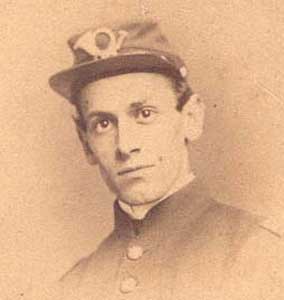
TUCKER, FANNING (or TANNING) C. (1837-1878). Captain, 103rd New York Infantry, Company D; private, 7th Regiment, New York State Militia, Company F. After enlisting as a private at New York City on April 17, 1861, he mustered into the 7th Regiment on April 26, and went with his unit to defend the nation’s capital in 1861. He re-enlisted as a first lieutenant at New York City on February 17, 1862, was commissioned into the 103rd New York on February 28, and was promoted to captain on April 4, 1862. He served under General Burnside in North Carolina, Pope in Virginia, and McClellan in the Maryland Campaign. After he was wounded at Antietam, Maryland, on September 17, 1862, he mustered out on November 4, 1862, citing disability from his wounds. He last lived at the Hoffman House in New York City. Section 98, lot 9800.
TUCKER, JOHN ASKEW (1840-1896). Private, 7th Regiment, New York State Militia, Company K. A Brooklynite by birth, he attended the Polytechnic Institute there and graduated from Columbia College in 1861. During the Civil War, he was a private in Company K of the 7th Regiment, New York State Militia, when it was activated for 30 days in 1861. He returned to the 7th in 1862, now part of the New York State National Guard, and served for three months. In 1863, he served with the same company of the 7th National Guard for 30 days.
He then became a clerk and later partner in the Tucker & Carter Cordage Company. In addition, he was a director of the Leather Manufacturers’ Bank of New York, a member of the Chamber of Commerce and the Maritime Exchange. In civilian life, he belonged to the Hamilton Club and the Quogue Field and Great South Bay Yacht Clubs. He last resided at the Strathmore at 1762 Broadway in Manhattan. Section 65, lot 98.

TUCKER, JOSEPH (1838-1891). Private, 37th New York Infantry, Company B. Tucker enlisted at New York City on November 1, 1861, as a private, and mustered into the 37th New York that day. Taken as a prisoner of war at Talleysville, Virginia, on June 29, 1862, he was paroled at Cumberland Landing, Virginia, on July 13. On September 5, 1862, he deserted. He died of paralysis in Brooklyn. Section 82, lot 2602.

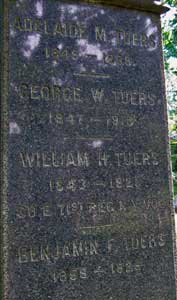
TUERS, WILLIAM H. (1843-1921). Private, 71st Regiment, New York State National Guard, Company E. Serving for three months in 1862, he enlisted on May 27 at New York City, mustered into the 71st Regiment the same day, and mustered out at New York City on September 2. According to an article in the Brooklyn Standard Union on September 30, 1921, the heirs of William Tuers (two brothers and a niece) shared equally in his estate (savings accounts) valued at $30,309.55. Section 29, lot 12136.
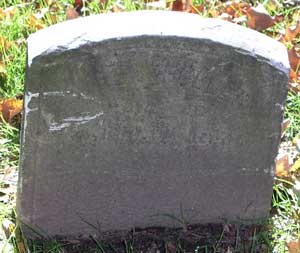
TULLER (or TULLAR), BYRON (1840-1893). Corporal, 13th Vermont Infantry, Company K. Born and educated in Swanton, Vermont, and a resident of that town where his father was a farmer, he was 5′ 9″ tall with blue eyes, brown hair, and a dark complexion. He enlisted as a private on August 28, 1862, and joined Company K of the 13th Vermont. A fellow soldier wrote about him in memoirs of the 13th:
“Comrade Tuller was very much inclined to be reserved and did not mingle very freely with his comrades, except those of his tentmates and particular friends. He was at times homesick and very melancholy. On the whole his disposition was uneven, yet was always pleasant and kind and enjoyed the good will and respect of all of Company K. He was promoted to corporal on June 5, 1863, just before we started on the long march to Gettysburg. His shoes wore out on the march and for a while went barefoot until we arrived at Adamstown or Emmitsburg, where he bought or procured a new pair…His pride and courage enabled him to face cannon and bristling bayonets. Patriotism indeed, induced him to volunteer. High regard for discipline made him faithful in the discharge of duty in camp, on the march, and the picket line and secured promotion. He was conscientious to the cause of the Union which made him brave in battle.”
Tuller’s superiors cited his courage at Gettysburg, Pennsylvania, “for facing cannon and bristling bayonets.” He mustered out on July 21, 1863, at Brattleboro, Vermont. After the War, he sold the farm he lived on, ran a saw mill, and then moved to Brooklyn where he last resided near Green-Wood Avenue and Windsor Terrace. Section 197A, lot 28449.
TUMBRIDGE, WILLIAM (1845-1921). Captain, United States Navy. Tumbridge was born in Cape Town, South Africa, and served in the United States Navy. Details about his military history are not available. He last resided at St. George Hotel on Clark Street in Brooklyn, a structure he helped build and expand. An article about his real estate activities in Brooklyn noted that he was once fined $25 for slapping and punching a broker who had no money to pay his hotel bill. Section 196, lot 31399.
TUPPER, THEODORE A. (1837-1880). Private, 2nd Regiment, New Jersey Infantry, Company K. A New Jersey native, Tupper enlisted there on April 26, 1861, as a private. On May 1, he mustered into Company K of the 2nd New Jersey from which he was discharged after three months at Trenton, New Jersey, on July 31, 1861. In addition, he served as a teamster in the Quartermaster Department, United States Volunteers. His last residence was 13 Exchange Place in Jersey City, New Jersey. In 1890, his wife applied for and was granted a widow’s pension. Section 85, lot 1594, grave 274.
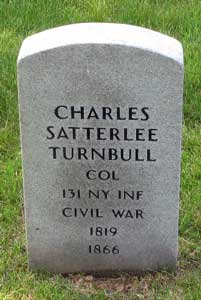
TURNBULL, CHARLES SATTERLEE (1819-1866). Colonel, 131st New York Infantry. A native New Yorker, he served as a New York City police captain, then enlisted on July 12, 1862, at New York City. After mustering into the 131st as colonel on September 16, he was on duty at Parole Camp, Annapolis, and then was with General Banks in Louisiana where his regiment was the first to arrive at Baton Rouge. He was discharged on January 15, 1863, upon his resignation. According to William Swinton’s History of the Seventh Regiment (1876), Turnbull also served in Company G of that unit; the dates of that service are not noted. He last lived in New York City where he died of a hemorrhage. Section 169, lot 15265.
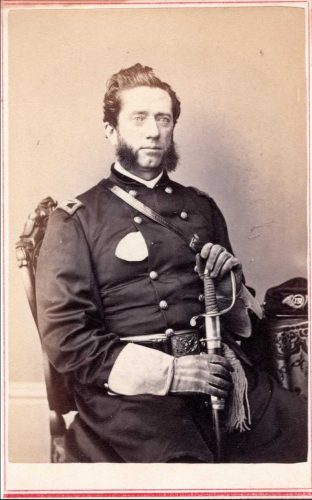
TURNBULL, JAMES DRYSDALE (1839-1910). First sergeant, 6th New York Heavy Artillery, Company C. Enlisting as a first sergeant on August 22, 1862, at West Farms, New York, Turnbull, a native of New York City, mustered into the 6th New York Heavy Artillery on September 2. He was reduced to sergeant on November 11, 1862, and deserted at Harpers Ferry, (now West Virginia), on January 12, 1863. At the time of his death, he resided at 468 Chestnut Street in Brooklyn. Section 54, lot 6642.
TURNBULL, JOHN M. (1838-1862). Second lieutenant, 40th New York Infantry, Company F. A native New Yorker, he enlisted as a first sergeant at Yonkers, New York, on June 14, 1861, and mustered into the 40th New York on that day. Turnbull was promoted to second lieutenant on September 25, 1861, and was discharged on May 19, 1862. A month later, he succumbed to consumption. He last resided in Yorkville, New York. In 1863, his mother, Jane Turnbull, received a pension, certificate 131,119. Section 54, lot 6642.
TURNER, GEORGE (1843-1914). Unknown soldier history. Turner served during the Civil War but the details are not known. He was a member of the Grand Army of the Republic, an organization for Civil War veterans. At the time of his death, he resided at 324 Jefferson Avenue in Brooklyn. Section 167, lot 16936, grave 1.
TURNER, HENRY W. (1827-1882). Captain, 71st Regiment, New York State Militia, Companies G and H. A native of Boston, Massachusetts, Turner enlisted in New York as a second lieutenant on April 19, 1861, was commissioned into the 71st Regiment, Company G, on May 3, and mustered out on July 31. When his regiment was reactivated the next year and part of the New York National Guard, he re-enlisted on May 28, 1862, was commissioned into Company H as a captain, and mustered out after three months on September 2. He re-enlisted on June 6, 1863, served with Company H of the 71st for 30 days, and mustered out with his company on July 22 at New York City.
After the War, Turner worked as a printer and was manager of the publication department of the Nautical Gazette. He was a prominent Freemason and was president of the Brooklyn Yacht Club. At the time of his death, from cerebritis (inflammation of the brain), he lived at 826 Lexington Avenue in Brooklyn. Section 51, lot 12647.

TURNER, JOHN (1843-1864). Corporal, 10th New York Infantry, Companies I and C. Turner is not buried at Green-Wood; a cenotaph in his family’s lot honors his memory. He enlisted and mustered into Company I of the 10th New York on December 4, 1861, at New York City, was promoted to corporal on an unspecified date, transferred to Company C on April 26, 1863, and was killed at Wilderness, Virginia, on May 6, 1864. His cenotaph states his place of death and notes, “the body was not recovered from the field of battle.” Section 112, lot 12692.
TURNER, WILLIAM H. (1841-1898). Sergeant, 8th Regiment, New York State Militia, Companies K and G. Originally from Kentucky, Turner enlisted as a private at New York City in 1861. He mustered into Company K of the 8th Regiment and before his three month term expired, was promoted to sergeant and transferred to Company G. When the 8th Regiment was reactivated in 1862, and part of the New York State National Guard, he returned to Company G as a sergeant and served for three months before mustering out at New York City. In 1863, he was a private in Company K for three months, mustering out with his company at New York City.
He applied for an invalid pension in 1890 that was approved, certificate 797,518. As per his obituary in the New York Herald, he was an active Freemason and member of the Knights Templar and the G.A.R.; members were invited to his funeral at the Scottish Rite Hall in civilian dress. His last residence was 2435 Creston Avenue in the Fordham section of the Bronx. Alicia Turner applied for and received a widow’s pension, certificate 468,490. Section 195, lot 25427, grave 2.
TURNER, WILLIAM HENRY HUNTER (1842-1893). Private, 18th Battalion, Georgia Infantry, Company A, Confederate States of America. Turner was born in Demerrara, Georgetown, Guyana, then a colony in the British Empire. His parents sailed to New York in 1850 but after his mother’s death in 1855, his father moved to Savannah, Georgia. Turner enlisted in the 18th Battalion, Georgia Infantry, which was also identified as the Savannah Volunteer Guards, on March 1, 1862, at which time he received a $50 bounty. He was present in May and June 1863 on the muster rolls but was absent as sick from August 24, 1863, until late December 1863, then absent/sick from March 12, 1864, then present in May and June 1864. His November/December 1864 muster roll notes that he, “Deserted to the Enemy at Chaffins Farm [Virginia] December 21, [18]64, while on picket duty.” He was transferred to the Headquarters of the Army of the James two days later and turned over to the provost marshal at City Point, Virginia. On December 24, he was listed as a rebel deserter at Bermuda Hundred, Virginia. After taking the oath of allegiance to the Union, he was sent to Port Royal, South Carolina, on December 30. After the War, he lived in New York where his occupation was listed as paper-hanger in the 1880 census. Section 127, lot 8259, grave 201.
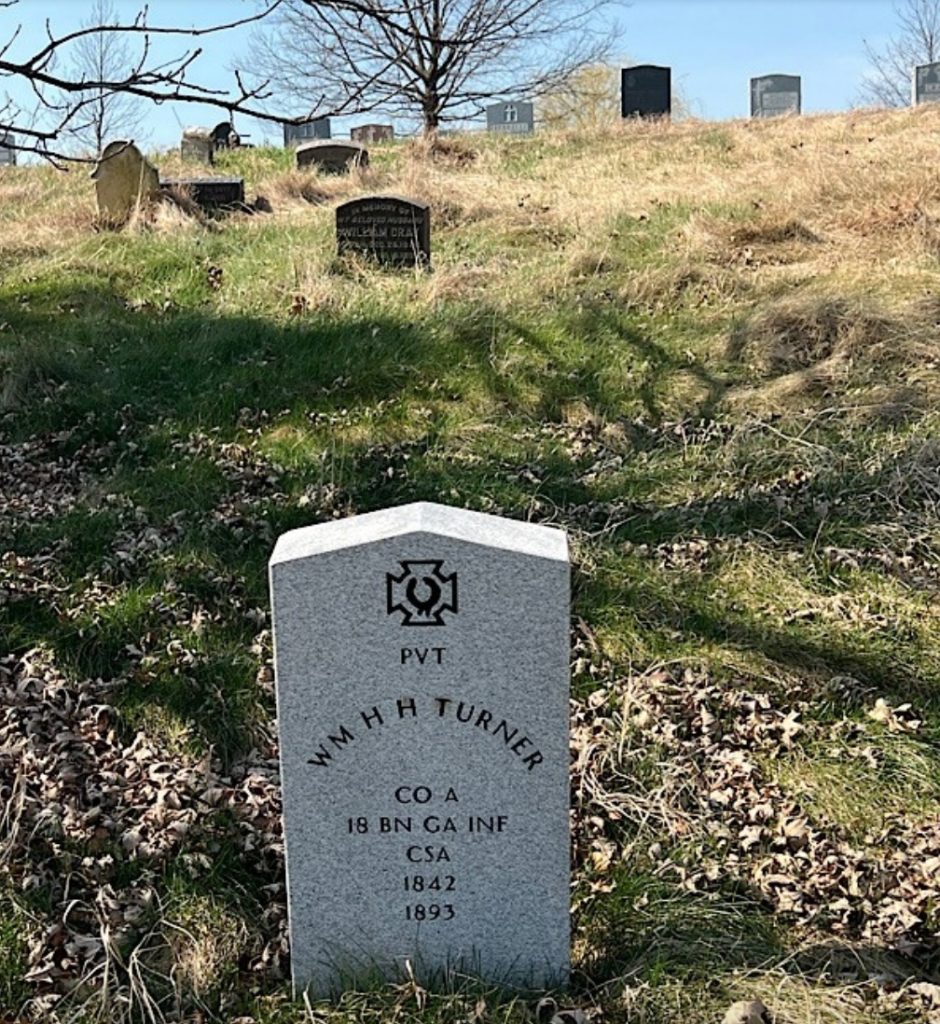
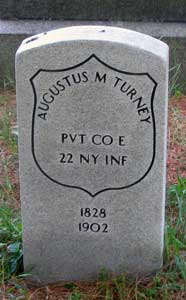
TURNEY, AUGUSTUS M. (1828-1902). Private, 22nd Regiment, New York State National Guard, Company E. A native of New York City, Turney enlisted there as a private on May 28, 1862, mustered immediately into the 22nd New York, and mustered out after three months on September 5. He last lived at 343 Sixth Avenue in Brooklyn. Turney succumbed to Bright’s disease. Section 180, lot 13897, grave 3.
TUTHILL, GEORGE (1824-1906). Captain, 83rd New York Infantry, Company H. Before the Civil War, Tuthill, a native of New York City, served in the 7th Regiment, New York State Militia, Company C, and in the 9th New York State Militia, Company F. After the 9th had not been called up for duty in the first wave of 1861 activations, Tuthill and many of his comrades from the 9th enlisted in the 83rd New York Volunteer Infantry. He enlisted as a captain on May 27, 1861, was immediately commissioned into the 83rd at New York City, and served in June and July of 1861 in the Upper Potomac under Generals Stone, Patterson, and Banks. On July 5 of that year, he was detached to General Stone to a command at Harpers Ferry (now West Virginia) where he transmitted a disputed order to General Patterson from Winfield Scott; he was relieved of the command on July 24. In 1863, he was seriously wounded from an explosion and was carried from the field. Tuthill left the service on account of disease that he contracted while on duty.
Tuthill applied for a federal pension in 1891, certificate 905,109. He was a member of the Lafayette Post #140 of the G.A.R. Employed in the coal business, his office was at 111 Broadway in Manhattan. He was also a commission merchant for many years. Tuthill was living at 239 Lexington Avenue in Brooklyn when he died. Section 181, lot 17797.

TWADDELL (or TWADELL, TWADDLE), JAMES THOMAS (1829-1862). First lieutenant and adjutant, 32nd New York Infantry, Companies G, B, E, and F. A native of New York City, Twaddell (spelled Twaddle on the paper submitted in his widow’s pension records), age 21, married Virginia Clark, age 18; the marriage was officiated by the pastor of the Mariners’ Church in New York City on February 22, 1848. The 1855 New York State census lists him as living in Manhattan with his wife and two children and working as a halter. By 1860, the couple had four children; the 1860 census reports that Twaddell was a policeman.
After enlisting as a second lieutenant at New York City on May 15, 1861, Twaddell was commissioned into Company G on May 31. He was transferred to Company B on October 15, 1861, the same day he was promoted to first lieutenant and adjutant and transferred to Company E. Twaddell was transferred to Company F on April 4, 1862. He was shot in the leg on May 7, 1862, at West Point, Virginia, succumbed to his wounds at the Judiciary Square Hospital in Washington, D.C., on July 5, and was interred at Green-Wood on July 12.
As per his obituary in the New York Tribune, which acknowledges Twaddell’s service in the Union Army, the superintendent of the Metropolitan Police invited its members to attend Twaddell’s funeral and also pay its last respects to him. On November 5, 1862, Virginia Twaddell, who is interred with him, applied for and received a widow’s pension, certificate 6,442. The New York Sun reported on October 5, 1880, that Twaddell’s son, James, married Catharine Anne Oakley, the daughter of James F. Oakley (see). Section 71, lot 4255.
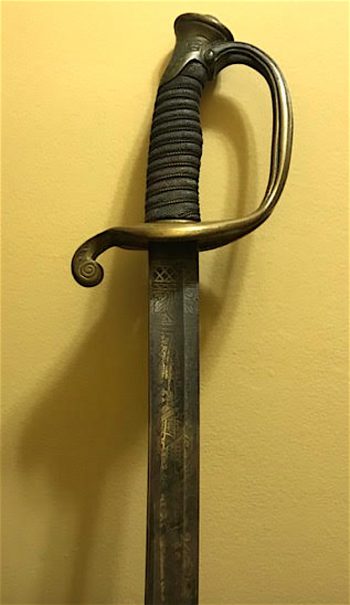
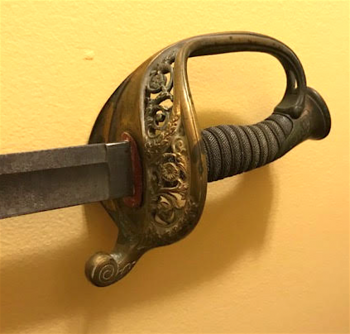

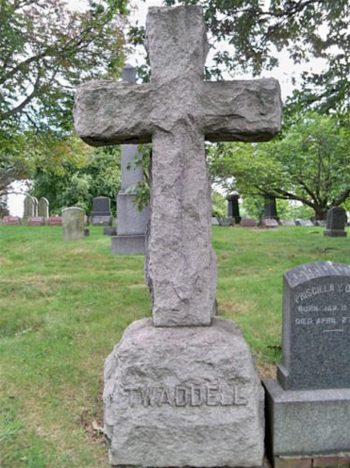
TWAMLEY, PETER (1840-1916). Private, 48th New York Infantry, Company I. Originally from Ireland, Twamley enlisted at Brooklyn as a private on August 10, 1861, mustered into the 48th New York six days later, and was discharged on an unknown date. In civilian life, he was employed for over twenty-five years in the sugar division of the United States Custom House at the Port of New York. His obituary in the Brooklyn Daily Eagle reports that he was a Freemason for fifty years and member of the 48th New York Veterans Association and the Alexander Hamilton Post #182 of the G.A.R. His last residence was 639 Walton Avenue in the Bronx. Originally interred at Green-Wood, his remains were moved to Kensico Cemetery in Valhalla, New York, on November 1, 1917.
TWEED, WILLIAM MAGEAR (often his middle name is incorrectly reported as MARCY; “BOSS”) (1823-1878). Born on the Lower East Side in New York City, he began working as a chair-maker at age eleven, following in his father’s footsteps, then was taught to be a saddler and subsequently learned bookkeeping. Circa 1848, Tweed was an organizer of the Americus Volunteer Fire Engine Company, where his success as its foreman was the launch pad to his political career; at that time, fire companies were powerful neighborhood associations. Tweed purchased a lot at Green-Wood for Americus members. In 1851, he was elected a New York City alderman, then was elected to the House of Representatives the following year. In 1856, he was elected to the city board of supervisors. At the same time, he strengthened his political power by having his cronies named to key city and county posts, forming what became known as the “Tweed Ring.” By the late 1850s, he was a leader of Tammany Hall, the site of Democratic Party politics and place where Irish and other immigrants went for help. By 1860, he headed Tammany Hall’s general committee, thus controlling the Democratic Party’s nominations to all City positions. In that same year, he opened a law office where corporations paid large fees for his supposed “legal services.” By the mid-1860s, he was a powerful force at Tammany Hall, where he and his cronies dominated New York City politics through fraudulent contracts, vote buying and other deceptive measures that extracted monies and enriched him and his partners.
New York City’s Draft Riots of 1863 created an opportunity for Tweed to win over voters and steal money. At first, he denounced the lawless behavior of the rioters and appeased some of the concerns of Republicans by supporting the prosecution of rioters in the late summer and early fall; sixty-seven convictions were handed down with jail terms of various lengths. In response to the Draft Riots, New York City set up a board to allocate a fund to purchase substitutes for poor family men who had been drafted. Tweed was appointed to that board, creating more opportunities for him both to steal public funds and ingratiate himself with the working class. Another member of the board, Orison Blunt (see), a Republican who supplied weapons to the Union Army, had worked with Tammany Hall to quell the Draft Riots and also persuaded President Abraham Lincoln to temporarily suspend enforcement of the draft in New York.
Because few men could come up with bounties to pay for their substitutes, they turned to Tweed for help. Tweed signed the documents for indigent men attesting that they were entitled to monies from the comptroller for their substitutes. When the federal draft resumed in August, Tammany allied with New York’s Governor Horatio Seymour to get the quota for New York reduced from 26,000 to 12,000 men. Tweed and others enriched themselves through their bounty ring that enabled New Yorkers who did not want to serve to avoid military duty. The Herald reported, “The bounty ring was of the most elaborate description, a ring in which Supervisors, recruiting officers, doctors, bounty brokers, and policemen were interested, and in the profits of which they shared.”
In 1868, Tweed was elected State senator and grand sachem of Tammany Hall. In the early 1870s, Tweed and his “ring” of associates continued to demand payoffs from contractors who did business with the city; Tweed personally amassed millions and lived in an opulent mansion on Fifth Avenue and 43rd Streets. At the height of his misdeeds, he embezzled New York City funds to remodel the City Court House in 1871; the fraud was exposed by The New York Times. It is projected that Tweed and his “Ring” stole huge amounts of public money; estimates range from $30,000,000 to $200,000,000 (which is between $539 million and $3.6 trillion in today’s money). His activities were also exposed by Thomas Nast, the political cartoonist for Harper’s Weekly, whose work was widely circulated and could be understood even by those who were illiterate. Tweed’s candidates lost their seats in the election of 1871 and Tweed and members of his “Ring” were charged and sentenced to prison. He first served time for forgery and larceny from 1873-1875; he then returned to jail in 1875 on a civil matter, but escaped to Cuba and Spain in 1875. In 1876, he was arrested by Spanish police who recognized him from one of Nast’s cartoons; Tweed then was extradited back to the United States. He died at the Ludlow Street Jail in 1878. Section 55, lot 6447.
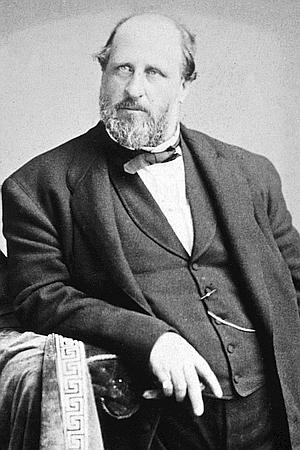
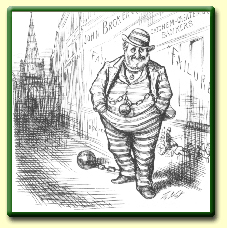
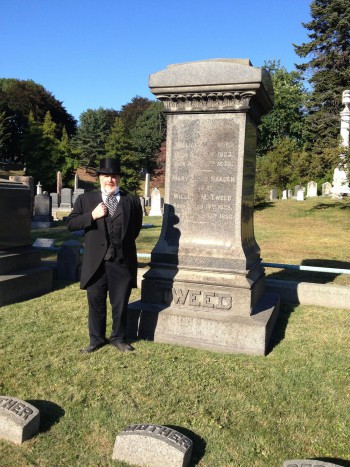
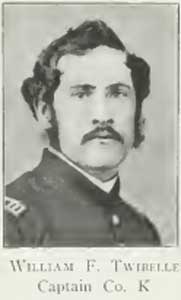
TWIBILL, WILLIAM F. (1836-1886). Captain, 84th New York (14th Brooklyn) Infantry, Companies H and K. He enlisted as a private at Brooklyn on April 18, 1861, and mustered into Company H of the 14th Brooklyn on May 23. Twibill rose through the ranks to sergeant about August 15, 1861, effective upon his transfer to Company K. He was promoted to second lieutenant but not commissioned on June 18, 1862. (The company’s muster roll for March-April 1862 indicated that he was promoted by election from third sergeant to second lieutenant on March 4, 1862.) On August 30, 1862, he was wounded in action at Manassas, Virginia, and was absent on the muster rolls that September and October. He was promoted to captain effective February 26, 1863, with rank from January 18, 1863. On May 10, 1864, he was wounded at Laurel Hill, Virginia, and appeared on the 14th Regiment’s casualty list. On June 6, 1864, he mustered out at New York City.
His name was incorrectly spelled as “Twibelle” in the Regiment’s sketchbook. In 1882, he applied for an invalid pension, application 373,546, but there is no certificate number listed. He last lived in Flatbush. Twibell’s obituary in the Brooklyn Daily Eagle extended an invitation to his funeral to members of the Fourteenth Regiment War Veteran Association. His headstone confirms his service as captain of the 84th N.Y.S.M. Section 188, lot 14528.
TWYEFFORT, LOUIS PHILIPPE (1843-1902). Second lieutenant, 72nd Illinois Infantry, Company D. Born in Brussels, Belgium, he was a resident of Chicago, Illinois, where his family settled in 1855. He enlisted as a corporal on July 25, 1862, and mustered into the 72nd Illinois on August 21, a company made up chiefly of members of the Young Men’s Christian Association of Chicago. He was promoted to second lieutenant on September 27, 1864. According to his obituary in The New York Times, part of his time in service was spent on the staff of General Thomas. He mustered out on August 7, 1865.
After the War, Twyeffort relocated to New York where he became a prominent dry goods merchant whose firm had offices in New York and Paris. He was a member of the Union League Club of Brooklyn, treasurer of the American Chapel in Paris, and a director of the YMCA in Paris. His last residence was 67 Hancock Street in Brooklyn. Section 154, lot 24590, grave 3.
TYLER, CHARLES A. (1823-1900). Civilian fighter during the New York City Draft Riots. A native of New York City, he began his career as a letter carrier in 1845 after distributing pamphlets and newspapers. In the early days of his career, he was paid two cents for every letter he delivered (the government was paid the same amount) and received a five percent commission for selling stamps. During the New York City Draft Riots of July 1863, Tyler took a musket and helped defend the Cedar Street Post Office in downtown Manhattan. Two mail carriers were killed and several wounded during that attack. In his obituary in the Brooklyn Daily Eagle, it was noted that he was the oldest letter carrier and that he worked during the blizzard of 1888. One hundred colleagues accompanied his body to his gravesite. He last lived at 238 Albany Avenue in Brooklyn. Section 99, lot 9266, grave 1.
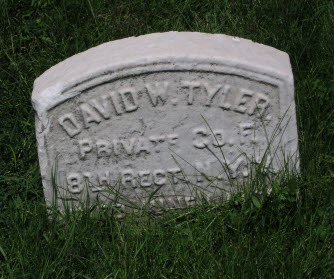
TYLER, DAVID W. (1841-1895). Private, 8th Regiment, New York State Militia, Company F. Tyler served for three months with the 8th New York State Militia in 1861. He enlisted at New York City on April 25, mustered in on May 27 at Washington, D.C., and mustered out at New York City on August 2.
As per his obituary in the New York Herald, he was a member of the Cushing Post #231 of the G.A.R., the Independent Order of Odd Fellows, and the Lincoln Council; members were invited to attend his funeral. His tombstone has an inscription noting that he was a member of the G.A.R. as does a stone from the Veterans’ Administration. He last resided at 689 Fourth Avenue in Brooklyn. Section 204, lot 29144, grave 2.

TYLER, HENRY DUNREATH (1834-1911). Private, 84th New York (14th Brooklyn) Infantry, Company C. Born in Limington, Maine, and a lawyer by trade, Tyler was 5′ 11″, with dark complexion, dark brown hair and hazel eyes. After enlisting at Brooklyn on April 18, 1861, he mustered into the 14th on May 23. He fought with the 14th at the first Battle of Bull Run, Virginia, where he received shrapnel wounds, permanently scarring his legs, the index finger of his left hand and the little finger of the right hand. He was discharged for disability on September 7, 1861, at Munson Hill (Arlington), Virginia, James Dailey, M.D., assistant surgeon, citing “general debility – the nervous system completely broken down, rendering him unfit for any duty whatever.” He appears to have applied for a disability pension on August 30, 1861, application 6, but there is no record that he received one at that time.
After the War, Tyler lived in Brooklyn. Between 1870 and 1889 he worked as a coffee broker, otherwise he practiced law. He was a member of the Ulysses S. Grant Post #327 of the G.A.R. In 1904, Tyler’s application for an invalid pension was granted, certificate 1,099,723. His obituary in the Brooklyn Standard Union, which confirms his service in the Civil War, reports that Tyler was a prominent lecturer on the early history of New York City and was also a dealer in rare pictures of early City life. As per his obituary in the Brooklyn Daily Eagle, members of the G.A.R. Post #327 were invited to attend his funeral; officers were requested to attend in uniform but without side arms. At the time of his death, he resided at 463 East 26th Street in Brooklyn but died in Pike County, Pennsylvania, where he had hoped to restore his health. Section 80, lot 2937.
TYLER, JR., JOHN (1837-1922). Private, 71st Regiment, New York State Militia, Company A. After enlisting in 1861, Tyler served for three months with the 71st Regiment that year. In 1907, he applied for and received a pension, certificate 1,136,803. He last lived at 527 West 110th Street in Manhattan. Section 206, lot 21347, grave 367.
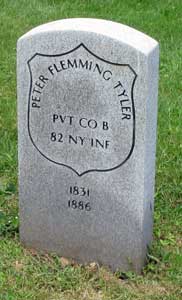
TYLER, PETER FLEMMING (1831-1886). Private, 82nd New York Infantry, Company B. After he enlisted as a private on April 17, 1861, at New York City, he mustered into the 82nd on May 21, and mustered out at New York City on June 25, 1864. He last lived at 102 Grand Street in Brooklyn. In 1888, his wife applied for a widow’s pension, application 373,291, but no certificate number is listed. Section 186, lot 18999.
TYNG, CHARLES ROCKLAND (1844-1925). Private, 7th Regiment, New York State National Guard, Company I. Born in Philadelphia, Pennsylvania, Tyng served with the 7th Regiment when it was activated for three months in 1862. In 1906, he applied for and was granted a pension, certificate 1,124,101. He was likely the son of Stephen (see) and brother of Thomas Tyng (see). He last lived in New York City. His widow received a pension in 1926, certificate a-10-12-26. Section 99, lot 11479.
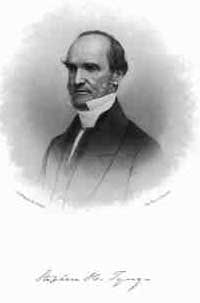
TYNG, STEPHEN HIGGINSON (1800-1885). Chaplain, 12th Regiment, New York State National Guard. A renowned Episcopal evangelical preacher, Tyng was born in Newburyport, Massachusetts, and graduated from Harvard College in 1817. After ordination as deacon in 1821, he became a priest in 1824 and began his ministry in Georgetown, D.C., 1821-1823. He later served as a rector in Maryland (1823-1829), Philadelphia (1829-1845), and then New York (1845-1878).
On June 19, 1863, Tyng enlisted as a chaplain at New York City, was commissioned into the Field and Staff of the 12th National Guard, and mustered out after 30 days on July 20 at New York City. Widely known in Episcopal circles as a great preacher, he was active in supporting Sunday schools to teach the Bible and prepare people for conversions. In New York, his church was a pioneer parish for missionary work for the poor. He worked as an editor on church journals, favored revival meetings, but did not support the schism of the Reformed Episcopal Church in 1873. His sons, Charles (see) and Thomas (see) both served in the 7th Regiment. He died in Irving-on-Hudson, New York. Section 99, lot 11479.
TYNG, THOMAS MITCHELL (1834-1908). Second sergeant, 7th Regiment, New York State Militia, Company I. Born in Philadelphia, Pennsylvania, and the son of Reverend Stephen Tyng (see), he first served as a private in the 7th Regiment for 30 days in 1861. When the 7th was reactivated for three months the next year, he was promoted to second sergeant and served in same company as Charles Tyng (see). In 1907, he was awarded a pension, certificate 1,143,961. He last lived in Bayonne, New Jersey. Section 99, lot 11479.
TYSON, EDWIN W. (1834-1868). Landsman, United States Navy. Born in Bridgeport, Connecticut, Tyson enlisted as a landsman on June 15, 1864, mustered into the Navy on that day, and was discharged on July 22, 1867. He last lived in Manhattan at Sixth Avenue and 38th Street. Section 84, lot 6302.
UDELL, THEODORE (1825-1886). Private, 83rd New York Infantry, Company A. After enlisting on May 27, 1861, at New York City, he immediately mustered into the 83rd New York. He deserted on about October 15, 1861, at Darnestown, Maryland. He last lived in Baltimore, Maryland. The cause of his death was Bright’s disease. Section 15, lot 9565.

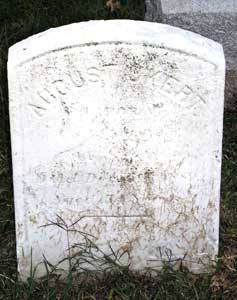
UKERT (or UCKERT, UCART), AUGUST (1838-1889). Private, 5th General Service Cavalry, United States Army, Company B. Born in Prussia, Germany, he was a private in the Regular Army in the 5th General Service Cavalry. His soldier records indicate that he was borne as August Uckert but his gravestone has the spelling of Ukert. A game keeper, he was 5′ 7″ tall with gray eyes, brown hair and a fair complexion. He was discharged at Carlisle Barracks, Pennsylvania, as a private on February 7, 1865, upon the expiration of his service. Although Ukert’s gravestone notes that he was a corporal in Company B of the 5th Artillery, his pension index record and other soldier records do not mention that promotion.
The 1865 New York State census lists him as August Ucart, a soldier living with his wife Mary and his 10-year-old daughter Elizabeth in Brooklyn’s 8th Ward. On February 14, 1868, he became a naturalized citizen. (His name was spelled “Uckert” on that document.) Although he applied for an invalid pension in 1883, application 471,281, it does not appear that it was ever certified. In the 1887 Brooklyn Directory, Ukert is listed as a driver living at 361 17th Street. His last residence was 353 17th Street in Brooklyn. Mary Uckert, who is interred with him, applied for and received a widow’s pension, certificate 296,450. Section 196, lot 30988, grave 1.
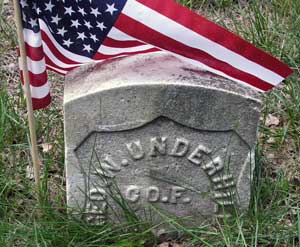
UNDERHILL, GEORGE W. (1840-1912). Private, 84th Regiment, New York State National Guard, Company F. Underhill, a native New Yorker, served for 100 days in the 84th New York National Guard in 1864. He joined the G.A.R. in New York City in May 1882. He last lived in Manhattan at 2743 Eighth Avenue. Section 115, lot 11193, grave 346.
UNDERHILL, WILLIAM H. (1816-1882). Captain, 1st New York Infantry, Company G. After enlisting at age 45 at New York City on May 3, 1861, and being commissioned in on that date, he served in Virginia near Fort Monroe and took part in the Battle of Big Bethel on June 10. He resigned on August 3, 1861, on account of physical disability dating from an injury received in New York City’s Astor Place Riots in 1849 when he was a member of the 7th Regiment’s Company E. His severe varicose veins were also cited as making him unfit for field duty. He was a resident of Brooklyn at the time of his death, caused by an ulcer of the leg. Section 182, lot 10484.
UNDERWOOD, ALEXANDER A. (1833-1864). Sergeant, 42nd New York Infantry, Company F; 71st New York Volunteers. A native New Yorker who was employed as a cartman, Underwood was 5′ 8″ tall with dark eyes and complexion and black hair. He enlisted as a corporal at Long Island, New York, on June 22, 1861, and immediately mustered into the 42nd New York, also known as the Tammany Regiment. He was promoted to sergeant on August 19, 1861, and was discharged for disability on March 8, 1863, from the camp hospital at Falmouth, Virginia, because of a cough contracted from exposure to the weather while building a bridge over the Chickahominy River, and early-stage tuberculosis.
According to a descendant, Underwood fought during the Peninsula Campaign and at the Battles of Ball’s Bluff, Virginia; Antietam, Maryland; and Fredericksburg, Virginia. He re-enlisted in the 71st New York Volunteers when General Lee invaded the North. His service, according to this descendant, included guarding the main rail line during the Battle of Gettysburg, Pennsylvania, and participating in the policing of New York City during the draft riots of July 1863. On November 24, 1864, he died from tuberculosis in New York City. Section 74, lot 11767.
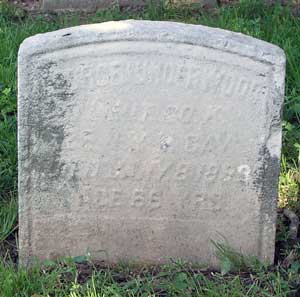
UNDERWOOD, GEORGE J. (1834-1899). First lieutenant, 25th New York Cavalry, Company K; corporal, 7th New York Heavy Artillery, Company G. A native of New York City, Underwood enlisted as a private at Albany, New York, on August 13, 1862, and mustered into the 7th New York Heavy Artillery on August 18. Promoted to corporal on March 12, 1864, he was discharged for promotion on May 13, 1864, immediately following his company’s engagement at Spotsylvania Court House, Virginia, on May 8-12. He was commissioned as a second lieutenant in the 25th New York Cavalry, Company K, on May 28, and fought with General Sheridan in the Shenandoah Valley Campaign in 1864 and 1865. He was promoted to first lieutenant on January 9, 1865, and mustered out at Hart’s Island, New York Harbor, on June 27, 1865. According to his pension records, he also served in Company G of the 113th New York Infantry.
After the Civil War, Underwood was a member of the Henry M. Lee Post #21 of the G.A.R. In 1892, his application for an invalid pension was granted, certificate 865,874. He died of Bright’s disease. Section 135, lot 30010, grave 133.
UNKLES, ABRAHAM (1841-1916). Corporal, 1st New York Mounted Rifles, Company G; 4th New York Provisional Cavalry, Company G. Born in Cork, Ireland, Unkles enlisted as a private at New York City on September 30, 1862, and mustered into the 1st New York Mounted Rifles that day. He re-enlisted on September 1, 1864, rejoined the unit, was promoted to corporal on February 19, 1865, was transferred into the 4th New York Provisional Cavalry on September 6, 1865, and was discharged on November 13.
The 1868 Brooklyn Directory states that Unkles was a clerk. He died from a fractured skull and multiple injuries suffered in a railroad accident. His obituary in the Brooklyn Standard Union, which confirms his Civil War service, reports that his daughter noted that her father was hard of hearing; that may have caused him to unknowingly step into the path of the train. His last home was in Meriden, Connecticut. Section 35, lot 12206.
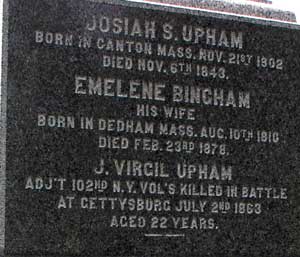
UPHAM, JOSIAH VIRGIL (1837-1863). Adjutant, 102nd New York Infantry, Companies K and E. Upham enlisted as a first sergeant on January 15, 1862, at New York City, and mustered into Company K of the 102nd Infantry two months later on March 15. He received promotions to second lieutenant on November 15, 1862, and to first lieutenant on March 27, 1863, and at some point was transferred to Company E and then to the Field and Staff. On or about May 1, 1863, he was promoted to adjutant. Upham was mortally wounded in the head and thigh on July 2, 1863, at Gettysburg, Pennsylvania, and died there of his wounds at the 2nd Division, 12th Corps Hospital. Although his remains were never brought to Green-Wood, a granite memorial to him has been placed in his family’s lot. Section 7, lot 14531.
URGUHART (or URQUHART), JOHN (1834-1892). Private, United States Marine Corps, United States Navy. A native of Scotland and a porter by trade, he first enlisted in the United States Marine Corps at Brooklyn for four years in 1855. At that time, he was 5′ 9″ tall with grey eyes, dark hair and a ruddy complexion. He served on the USS San Jacinto from October 2, 1855, through August 26, 1858, at which time he was discharged at Brooklyn for medical reasons.
During the Civil War, Urguhart enlisted as a private on July 13, 1861, and served in the Marine Corps aboard the USS North Carolina as of July 29. He was discharged at the Brooklyn Barracks on July 16, 1865. At the time he applied for a pension in 1887 and again in 1890, he cited disability related to his service indicating head pains and difficulty turning in bed. His pension from the Navy was granted, certificate 5,188. At the time of his death, caused by pneumonia, he was employed as a tailor. He last lived at 39 Gold Street in Brooklyn. In 1892, Maxwell Urguhart applied for and received a widow’s pension from the Navy under certificate 8,251. Section 135, lot 27263, grave 2487.
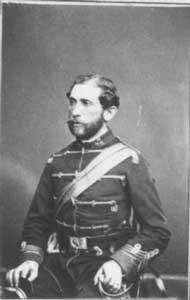
UTASSY (or VON UTASSY, D’UTASSY), CARL (1826-1871). Second lieutenant, 39th New York Infantry, Company C. An Austrian by birth, Utassy enlisted on June 1, 1862, was commissioned on that date into Company C of the 39th New York, and mustered out of service at Washington, D.C., on May 31, 1863. His last residence was 1078 Second Avenue in Manhattan. His widow applied for and was awarded a pension in 1891, certificate 337,080. Section 134, lot 17216, grave 33.